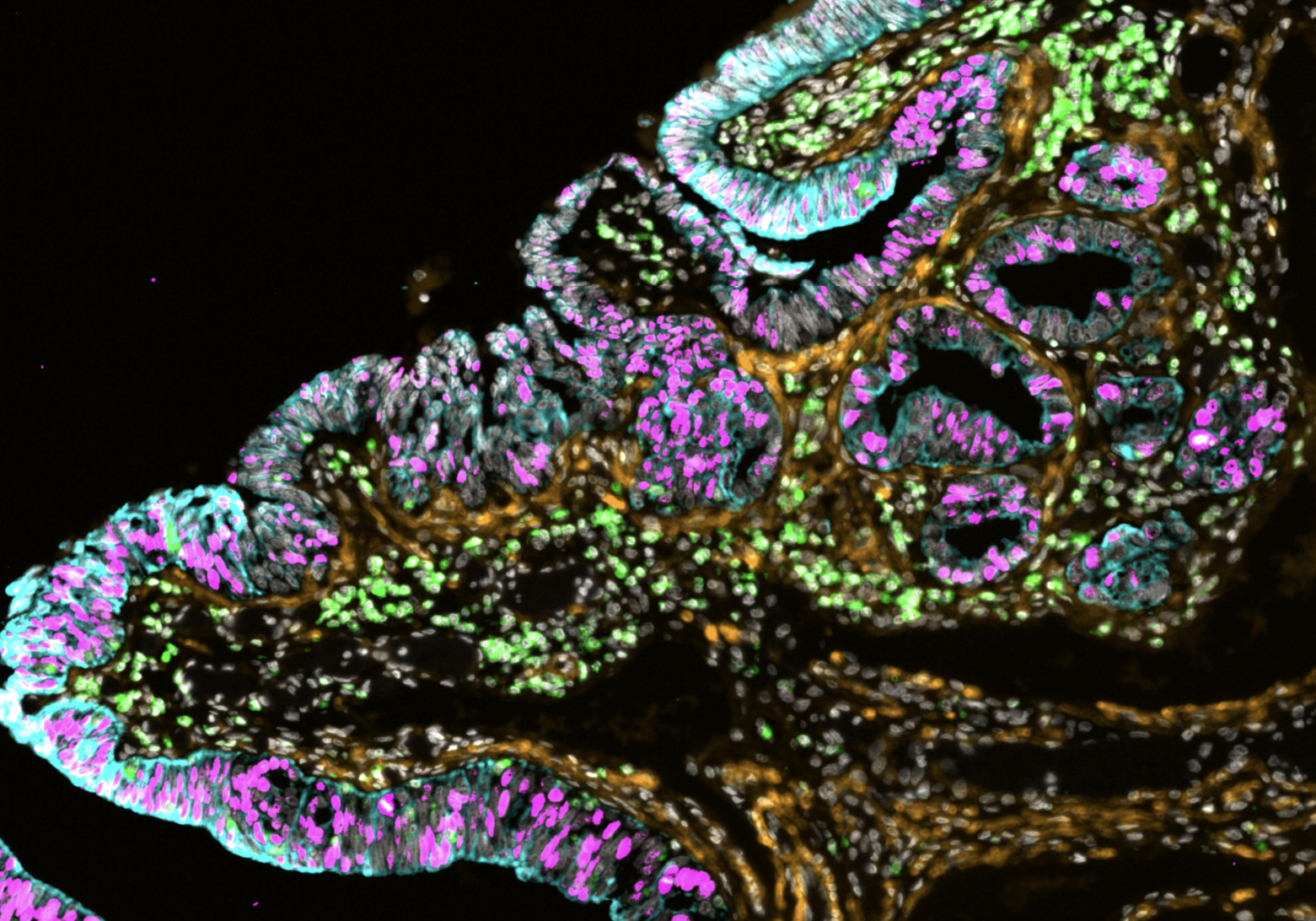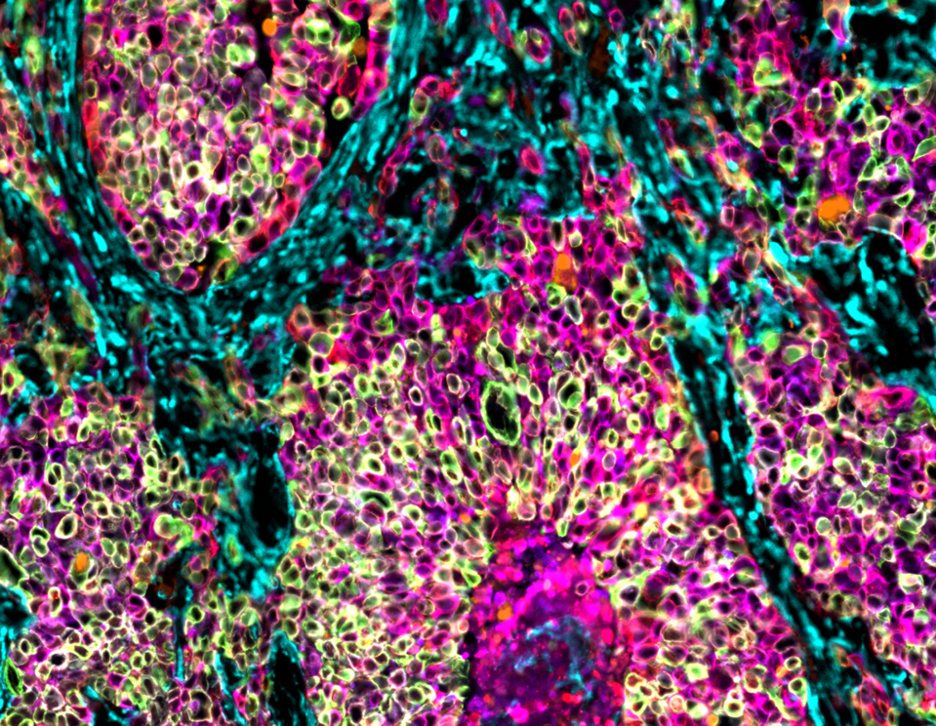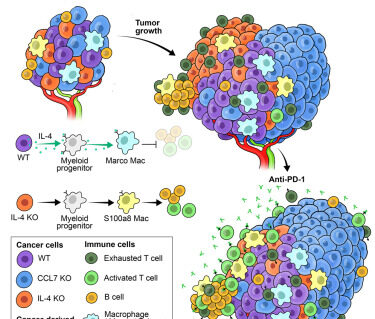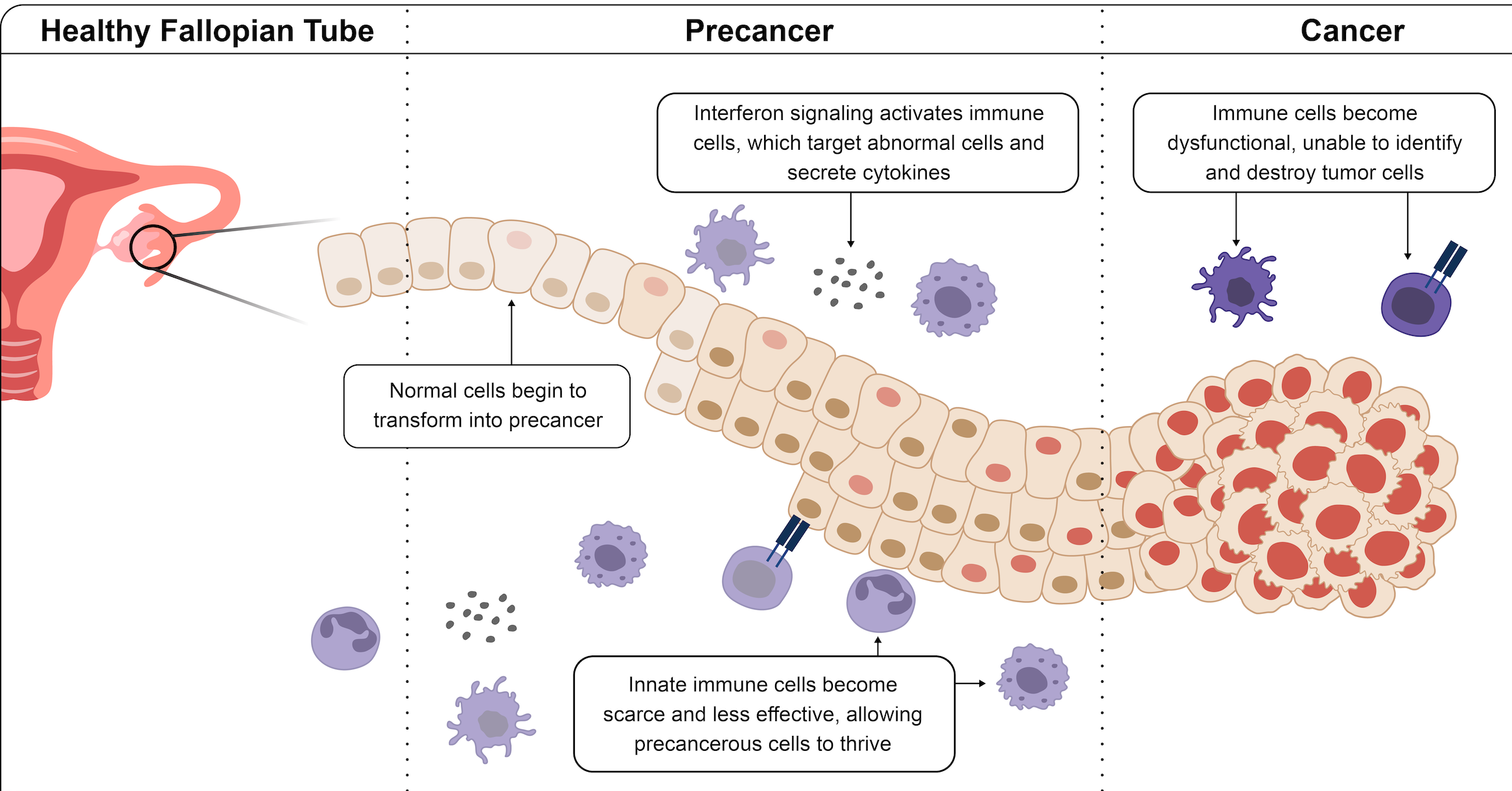Related Publications
Ovarian Cancer
2576724
IXMHRBF6
ovarian cancer
1
apa-cv
50
date
desc
1
1
4137
https://labsyspharm.org/wp-content/plugins/zotpress/
%7B%22status%22%3A%22success%22%2C%22updateneeded%22%3Afalse%2C%22instance%22%3Afalse%2C%22meta%22%3A%7B%22request_last%22%3A0%2C%22request_next%22%3A0%2C%22used_cache%22%3Atrue%7D%2C%22data%22%3A%5B%7B%22key%22%3A%22K27QX57C%22%2C%22library%22%3A%7B%22id%22%3A2576724%7D%2C%22meta%22%3A%7B%22creatorSummary%22%3A%22Mollaoglu%20et%20al.%22%2C%22parsedDate%22%3A%222024-12-26%22%2C%22numChildren%22%3A2%7D%2C%22bib%22%3A%22%3Cdiv%20class%3D%5C%22csl-bib-body%5C%22%20style%3D%5C%22line-height%3A%202%3B%20padding-left%3A%201em%3B%20text-indent%3A-1em%3B%5C%22%3E%5Cn%20%20%3Cdiv%20class%3D%5C%22csl-entry%5C%22%3EMollaoglu%2C%20G.%2C%20Tepper%2C%20A.%2C%20Falcomat%26%23xE0%3B%2C%20C.%2C%20Potak%2C%20H.%20T.%2C%20Pia%2C%20L.%2C%20Amabile%2C%20A.%2C%20Mateus-Tique%2C%20J.%2C%20Rabinovich%2C%20N.%2C%20Park%2C%20M.%20D.%2C%20LaMarche%2C%20N.%20M.%2C%20Brody%2C%20R.%2C%20Browning%2C%20L.%2C%20Lin%2C%20J.-R.%2C%20Zamarin%2C%20D.%2C%20Sorger%2C%20P.%20K.%2C%20Santagata%2C%20S.%2C%20Merad%2C%20M.%2C%20Baccarini%2C%20A.%2C%20%26amp%3B%20Brown%2C%20B.%20D.%20%282024%29.%20Ovarian%20cancer-derived%20IL-4%20promotes%20immunotherapy%20resistance.%20%3Ci%3ECell%3C%5C%2Fi%3E%2C%20%3Ci%3E187%3C%5C%2Fi%3E%2826%29%2C%207492-7510.e22.%20%3Ca%20class%3D%27zp-DOIURL%27%20target%3D%27_blank%27%20href%3D%27https%3A%5C%2F%5C%2Fdoi.org%5C%2F10.1016%5C%2Fj.cell.2024.10.006%27%3Ehttps%3A%5C%2F%5C%2Fdoi.org%5C%2F10.1016%5C%2Fj.cell.2024.10.006%3C%5C%2Fa%3E%3C%5C%2Fdiv%3E%5Cn%3C%5C%2Fdiv%3E%22%2C%22data%22%3A%7B%22itemType%22%3A%22journalArticle%22%2C%22title%22%3A%22Ovarian%20cancer-derived%20IL-4%20promotes%20immunotherapy%20resistance%22%2C%22creators%22%3A%5B%7B%22creatorType%22%3A%22author%22%2C%22firstName%22%3A%22Gurkan%22%2C%22lastName%22%3A%22Mollaoglu%22%7D%2C%7B%22creatorType%22%3A%22author%22%2C%22firstName%22%3A%22Alexander%22%2C%22lastName%22%3A%22Tepper%22%7D%2C%7B%22creatorType%22%3A%22author%22%2C%22firstName%22%3A%22Chiara%22%2C%22lastName%22%3A%22Falcomat%5Cu00e0%22%7D%2C%7B%22creatorType%22%3A%22author%22%2C%22firstName%22%3A%22Hunter%20T.%22%2C%22lastName%22%3A%22Potak%22%7D%2C%7B%22creatorType%22%3A%22author%22%2C%22firstName%22%3A%22Luisanna%22%2C%22lastName%22%3A%22Pia%22%7D%2C%7B%22creatorType%22%3A%22author%22%2C%22firstName%22%3A%22Angelo%22%2C%22lastName%22%3A%22Amabile%22%7D%2C%7B%22creatorType%22%3A%22author%22%2C%22firstName%22%3A%22Jaime%22%2C%22lastName%22%3A%22Mateus-Tique%22%7D%2C%7B%22creatorType%22%3A%22author%22%2C%22firstName%22%3A%22Noam%22%2C%22lastName%22%3A%22Rabinovich%22%7D%2C%7B%22creatorType%22%3A%22author%22%2C%22firstName%22%3A%22Matthew%20D.%22%2C%22lastName%22%3A%22Park%22%7D%2C%7B%22creatorType%22%3A%22author%22%2C%22firstName%22%3A%22Nelson%20M.%22%2C%22lastName%22%3A%22LaMarche%22%7D%2C%7B%22creatorType%22%3A%22author%22%2C%22firstName%22%3A%22Rachel%22%2C%22lastName%22%3A%22Brody%22%7D%2C%7B%22creatorType%22%3A%22author%22%2C%22firstName%22%3A%22Lindsay%22%2C%22lastName%22%3A%22Browning%22%7D%2C%7B%22creatorType%22%3A%22author%22%2C%22firstName%22%3A%22Jia-Ren%22%2C%22lastName%22%3A%22Lin%22%7D%2C%7B%22creatorType%22%3A%22author%22%2C%22firstName%22%3A%22Dmitriy%22%2C%22lastName%22%3A%22Zamarin%22%7D%2C%7B%22creatorType%22%3A%22author%22%2C%22firstName%22%3A%22Peter%20K.%22%2C%22lastName%22%3A%22Sorger%22%7D%2C%7B%22creatorType%22%3A%22author%22%2C%22firstName%22%3A%22Sandro%22%2C%22lastName%22%3A%22Santagata%22%7D%2C%7B%22creatorType%22%3A%22author%22%2C%22firstName%22%3A%22Miriam%22%2C%22lastName%22%3A%22Merad%22%7D%2C%7B%22creatorType%22%3A%22author%22%2C%22firstName%22%3A%22Alessia%22%2C%22lastName%22%3A%22Baccarini%22%7D%2C%7B%22creatorType%22%3A%22author%22%2C%22firstName%22%3A%22Brian%20D.%22%2C%22lastName%22%3A%22Brown%22%7D%5D%2C%22abstractNote%22%3A%22Ovarian%20cancer%20is%20resistant%20to%20immunotherapy%2C%20and%20this%20is%20influenced%20by%20the%20immunosuppressed%20tumor%20microenvironment%20%28TME%29%20dominated%20by%20macrophages.%20Resistance%20is%20also%20affected%20by%20intratumoral%20heterogeneity%2C%20whose%20development%20is%20poorly%20understood.%20To%20identify%20regulators%20of%20ovarian%20cancer%20immunity%2C%20we%20employed%20a%20spatial%20functional%20genomics%20screen%20%28Perturb-map%29%2C%20focused%20on%20receptor%5C%2Fligands%20hypothesized%20to%20be%20involved%20in%20tumor-macrophage%20communication.%20Perturb-map%20recapitulated%20tumor%20heterogeneity%20and%20revealed%20that%20interleukin-4%20%28IL-4%29%20promotes%20resistance%20to%20anti-PD-1.%20We%20find%20ovarian%20cancer%20cells%20are%20the%20key%20source%20of%20IL-4%2C%20which%20directs%20the%20formation%20of%20an%20immunosuppressive%20TME%20via%20macrophage%20control.%20IL-4%20loss%20was%20not%20compensated%20by%20nearby%20IL-4-expressing%20clones%2C%20revealing%20short-range%20regulation%20of%20TME%20composition%20dictating%20tumor%20evolution.%20Our%20studies%20show%20heterogeneous%20TMEs%20can%20emerge%20from%20localized%20altered%20expression%20of%20cancer-derived%20cytokines%5C%2Fchemokines%20that%20establish%20immune-rich%20and%20immune-excluded%20neighborhoods%2C%20which%20drive%20clone%20selection%20and%20immunotherapy%20resistance.%20They%20also%20demonstrate%20the%20potential%20of%20targeting%20IL-4%20signaling%20to%20enhance%20ovarian%20cancer%20response%20to%20immunotherapy.%22%2C%22date%22%3A%222024-12-26%22%2C%22language%22%3A%22eng%22%2C%22DOI%22%3A%2210.1016%5C%2Fj.cell.2024.10.006%22%2C%22ISSN%22%3A%221097-4172%22%2C%22url%22%3A%22%22%2C%22collections%22%3A%5B%22IXMHRBF6%22%5D%2C%22dateModified%22%3A%222025-01-15T17%3A18%3A49Z%22%7D%7D%2C%7B%22key%22%3A%22AJSV43N4%22%2C%22library%22%3A%7B%22id%22%3A2576724%7D%2C%22meta%22%3A%7B%22creatorSummary%22%3A%22Kader%20et%20al.%22%2C%22parsedDate%22%3A%222024-12-20%22%2C%22numChildren%22%3A2%7D%2C%22bib%22%3A%22%3Cdiv%20class%3D%5C%22csl-bib-body%5C%22%20style%3D%5C%22line-height%3A%202%3B%20padding-left%3A%201em%3B%20text-indent%3A-1em%3B%5C%22%3E%5Cn%20%20%3Cdiv%20class%3D%5C%22csl-entry%5C%22%3EKader%2C%20T.%2C%20Lin%2C%20J.-R.%2C%20Hug%2C%20C.%20B.%2C%20Coy%2C%20S.%2C%20Chen%2C%20Y.-A.%2C%20de%20Bruijn%2C%20I.%2C%20Shih%2C%20N.%2C%20Jung%2C%20E.%2C%20Pelletier%2C%20R.%20J.%2C%20Lopez%20Leon%2C%20M.%2C%20Mingo%2C%20G.%2C%20Omran%2C%20D.%20K.%2C%20Lee%2C%20J.%20S.%2C%20Yapp%2C%20C.%2C%20Satravada%2C%20B.%20A.%2C%20Kundra%2C%20R.%2C%20Xu%2C%20Y.%2C%20Chan%2C%20S.%2C%20Tefft%2C%20J.%20B.%2C%20%26%23x2026%3B%20Santagata%2C%20S.%20%282024%29.%20Multimodal%20Spatial%20Profiling%20Reveals%20Immune%20Suppression%20and%20Microenvironment%20Remodeling%20in%20Fallopian%20Tube%20Precursors%20to%20High-Grade%20Serous%20Ovarian%20Carcinoma.%20%3Ci%3ECancer%20Discovery%3C%5C%2Fi%3E.%20%3Ca%20class%3D%27zp-DOIURL%27%20target%3D%27_blank%27%20href%3D%27https%3A%5C%2F%5C%2Fdoi.org%5C%2F10.1158%5C%2F2159-8290.CD-24-1366%27%3Ehttps%3A%5C%2F%5C%2Fdoi.org%5C%2F10.1158%5C%2F2159-8290.CD-24-1366%3C%5C%2Fa%3E%3C%5C%2Fdiv%3E%5Cn%3C%5C%2Fdiv%3E%22%2C%22data%22%3A%7B%22itemType%22%3A%22journalArticle%22%2C%22title%22%3A%22Multimodal%20Spatial%20Profiling%20Reveals%20Immune%20Suppression%20and%20Microenvironment%20Remodeling%20in%20Fallopian%20Tube%20Precursors%20to%20High-Grade%20Serous%20Ovarian%20Carcinoma%22%2C%22creators%22%3A%5B%7B%22creatorType%22%3A%22author%22%2C%22firstName%22%3A%22Tanjina%22%2C%22lastName%22%3A%22Kader%22%7D%2C%7B%22creatorType%22%3A%22author%22%2C%22firstName%22%3A%22Jia-Ren%22%2C%22lastName%22%3A%22Lin%22%7D%2C%7B%22creatorType%22%3A%22author%22%2C%22firstName%22%3A%22Clemens%20B.%22%2C%22lastName%22%3A%22Hug%22%7D%2C%7B%22creatorType%22%3A%22author%22%2C%22firstName%22%3A%22Shannon%22%2C%22lastName%22%3A%22Coy%22%7D%2C%7B%22creatorType%22%3A%22author%22%2C%22firstName%22%3A%22Yu-An%22%2C%22lastName%22%3A%22Chen%22%7D%2C%7B%22creatorType%22%3A%22author%22%2C%22firstName%22%3A%22Ino%22%2C%22lastName%22%3A%22de%20Bruijn%22%7D%2C%7B%22creatorType%22%3A%22author%22%2C%22firstName%22%3A%22Natalie%22%2C%22lastName%22%3A%22Shih%22%7D%2C%7B%22creatorType%22%3A%22author%22%2C%22firstName%22%3A%22Euihye%22%2C%22lastName%22%3A%22Jung%22%7D%2C%7B%22creatorType%22%3A%22author%22%2C%22firstName%22%3A%22Roxanne%20J.%22%2C%22lastName%22%3A%22Pelletier%22%7D%2C%7B%22creatorType%22%3A%22author%22%2C%22firstName%22%3A%22Mariana%22%2C%22lastName%22%3A%22Lopez%20Leon%22%7D%2C%7B%22creatorType%22%3A%22author%22%2C%22firstName%22%3A%22Gabriel%22%2C%22lastName%22%3A%22Mingo%22%7D%2C%7B%22creatorType%22%3A%22author%22%2C%22firstName%22%3A%22Dalia%20K.%22%2C%22lastName%22%3A%22Omran%22%7D%2C%7B%22creatorType%22%3A%22author%22%2C%22firstName%22%3A%22Jong%20Suk%22%2C%22lastName%22%3A%22Lee%22%7D%2C%7B%22creatorType%22%3A%22author%22%2C%22firstName%22%3A%22Clarence%22%2C%22lastName%22%3A%22Yapp%22%7D%2C%7B%22creatorType%22%3A%22author%22%2C%22firstName%22%3A%22Baby%20A.%22%2C%22lastName%22%3A%22Satravada%22%7D%2C%7B%22creatorType%22%3A%22author%22%2C%22firstName%22%3A%22Ritika%22%2C%22lastName%22%3A%22Kundra%22%7D%2C%7B%22creatorType%22%3A%22author%22%2C%22firstName%22%3A%22Yilin%22%2C%22lastName%22%3A%22Xu%22%7D%2C%7B%22creatorType%22%3A%22author%22%2C%22firstName%22%3A%22Sabrina%22%2C%22lastName%22%3A%22Chan%22%7D%2C%7B%22creatorType%22%3A%22author%22%2C%22firstName%22%3A%22Juliann%20B.%22%2C%22lastName%22%3A%22Tefft%22%7D%2C%7B%22creatorType%22%3A%22author%22%2C%22firstName%22%3A%22Jeremy%20L.%22%2C%22lastName%22%3A%22Muhlich%22%7D%2C%7B%22creatorType%22%3A%22author%22%2C%22firstName%22%3A%22Sarah%20H.%22%2C%22lastName%22%3A%22Kim%22%7D%2C%7B%22creatorType%22%3A%22author%22%2C%22firstName%22%3A%22Stefan%20M.%22%2C%22lastName%22%3A%22Gysler%22%7D%2C%7B%22creatorType%22%3A%22author%22%2C%22firstName%22%3A%22Judith%22%2C%22lastName%22%3A%22Agudo%22%7D%2C%7B%22creatorType%22%3A%22author%22%2C%22firstName%22%3A%22James%20R.%22%2C%22lastName%22%3A%22Heath%22%7D%2C%7B%22creatorType%22%3A%22author%22%2C%22firstName%22%3A%22Nikolaus%22%2C%22lastName%22%3A%22Schultz%22%7D%2C%7B%22creatorType%22%3A%22author%22%2C%22firstName%22%3A%22Charles%20W.%22%2C%22lastName%22%3A%22Drescher%22%7D%2C%7B%22creatorType%22%3A%22author%22%2C%22firstName%22%3A%22Peter%20K.%22%2C%22lastName%22%3A%22Sorger%22%7D%2C%7B%22creatorType%22%3A%22author%22%2C%22firstName%22%3A%22Ronny%22%2C%22lastName%22%3A%22Drapkin%22%7D%2C%7B%22creatorType%22%3A%22author%22%2C%22firstName%22%3A%22Sandro%22%2C%22lastName%22%3A%22Santagata%22%7D%5D%2C%22abstractNote%22%3A%22High-Grade%20Serous%20Ovarian%20Cancer%20%28HGSOC%29%20originates%20from%20fallopian%20tube%20%28FT%29%20precursors.%20However%2C%20the%20molecular%20changes%20that%20occur%20as%20precancerous%20lesions%20progress%20to%20HGSOC%20are%20not%20well%20understood.%20To%20address%20this%2C%20we%20integrated%20high-plex%20imaging%20and%20spatial%20transcriptomics%20to%20analyze%20human%20tissue%20samples%20at%20different%20stages%20of%20HGSOC%20development%2C%20including%20p53%20signatures%2C%20serous%20tubal%20intraepithelial%20carcinomas%20%28STIC%29%2C%20and%20invasive%20HGSOC.%20Our%20findings%20reveal%20immune%20modulating%20mechanisms%20within%20precursor%20epithelium%2C%20characterized%20by%20chromosomal%20instability%2C%20persistent%20interferon%20%28IFN%29%20signaling%2C%20and%20dysregulated%20innate%20and%20adaptive%20immunity.%20FT%20precursors%20display%20elevated%20expression%20of%20MHC-class%20I%2C%20including%20HLA-E%2C%20and%20IFN-stimulated%20genes%2C%20typically%20linked%20to%20later-stage%20tumorigenesis.%20These%20molecular%20alterations%20coincide%20with%20progressive%20shifts%20in%20the%20tumor%20microenvironment%2C%20transitioning%20from%20immune%20surveillance%20in%20early%20STICs%20to%20immune%20suppression%20in%20advanced%20STICs%20and%20cancer.%20These%20insights%20identify%20potential%20biomarkers%20and%20therapeutic%20targets%20for%20HGSOC%20interception%20and%20clarify%20the%20molecular%20transitions%20from%20precancer%20to%20cancer.%22%2C%22date%22%3A%222024-12-20%22%2C%22language%22%3A%22eng%22%2C%22DOI%22%3A%2210.1158%5C%2F2159-8290.CD-24-1366%22%2C%22ISSN%22%3A%222159-8290%22%2C%22url%22%3A%22%22%2C%22collections%22%3A%5B%22IXMHRBF6%22%5D%2C%22dateModified%22%3A%222025-01-28T21%3A21%3A09Z%22%7D%7D%2C%7B%22key%22%3A%22QL2PS2WB%22%2C%22library%22%3A%7B%22id%22%3A2576724%7D%2C%22meta%22%3A%7B%22creatorSummary%22%3A%22Ding%20et%20al.%22%2C%22parsedDate%22%3A%222023-01%22%2C%22numChildren%22%3A2%7D%2C%22bib%22%3A%22%3Cdiv%20class%3D%5C%22csl-bib-body%5C%22%20style%3D%5C%22line-height%3A%202%3B%20padding-left%3A%201em%3B%20text-indent%3A-1em%3B%5C%22%3E%5Cn%20%20%3Cdiv%20class%3D%5C%22csl-entry%5C%22%3EDing%2C%20L.%2C%20Wang%2C%20Q.%2C%20Martincuks%2C%20A.%2C%20Kearns%2C%20M.%20J.%2C%20Jiang%2C%20T.%2C%20Lin%2C%20Z.%2C%20Cheng%2C%20X.%2C%20Qian%2C%20C.%2C%20Xie%2C%20S.%2C%20Kim%2C%20H.-J.%2C%20Launonen%2C%20I.-M.%2C%20F%26%23xE4%3Brkkil%26%23xE4%3B%2C%20A.%2C%20Roberts%2C%20T.%20M.%2C%20Freeman%2C%20G.%20J.%2C%20Liu%2C%20J.%20F.%2C%20Konstantinopoulos%2C%20P.%20A.%2C%20Matulonis%2C%20U.%2C%20Yu%2C%20H.%2C%20%26amp%3B%20Zhao%2C%20J.%20J.%20%282023%29.%20STING%20agonism%20overcomes%20STAT3-mediated%20immunosuppression%20and%20adaptive%20resistance%20to%20PARP%20inhibition%20in%20ovarian%20cancer.%20%3Ci%3EJournal%20for%20Immunotherapy%20of%20Cancer%3C%5C%2Fi%3E%2C%20%3Ci%3E11%3C%5C%2Fi%3E%281%29%2C%20e005627.%20%3Ca%20class%3D%27zp-DOIURL%27%20target%3D%27_blank%27%20href%3D%27https%3A%5C%2F%5C%2Fdoi.org%5C%2F10.1136%5C%2Fjitc-2022-005627%27%3Ehttps%3A%5C%2F%5C%2Fdoi.org%5C%2F10.1136%5C%2Fjitc-2022-005627%3C%5C%2Fa%3E%3C%5C%2Fdiv%3E%5Cn%3C%5C%2Fdiv%3E%22%2C%22data%22%3A%7B%22itemType%22%3A%22journalArticle%22%2C%22title%22%3A%22STING%20agonism%20overcomes%20STAT3-mediated%20immunosuppression%20and%20adaptive%20resistance%20to%20PARP%20inhibition%20in%20ovarian%20cancer%22%2C%22creators%22%3A%5B%7B%22creatorType%22%3A%22author%22%2C%22firstName%22%3A%22Liya%22%2C%22lastName%22%3A%22Ding%22%7D%2C%7B%22creatorType%22%3A%22author%22%2C%22firstName%22%3A%22Qiwei%22%2C%22lastName%22%3A%22Wang%22%7D%2C%7B%22creatorType%22%3A%22author%22%2C%22firstName%22%3A%22Antons%22%2C%22lastName%22%3A%22Martincuks%22%7D%2C%7B%22creatorType%22%3A%22author%22%2C%22firstName%22%3A%22Michael%20J.%22%2C%22lastName%22%3A%22Kearns%22%7D%2C%7B%22creatorType%22%3A%22author%22%2C%22firstName%22%3A%22Tao%22%2C%22lastName%22%3A%22Jiang%22%7D%2C%7B%22creatorType%22%3A%22author%22%2C%22firstName%22%3A%22Ziying%22%2C%22lastName%22%3A%22Lin%22%7D%2C%7B%22creatorType%22%3A%22author%22%2C%22firstName%22%3A%22Xin%22%2C%22lastName%22%3A%22Cheng%22%7D%2C%7B%22creatorType%22%3A%22author%22%2C%22firstName%22%3A%22Changli%22%2C%22lastName%22%3A%22Qian%22%7D%2C%7B%22creatorType%22%3A%22author%22%2C%22firstName%22%3A%22Shaozhen%22%2C%22lastName%22%3A%22Xie%22%7D%2C%7B%22creatorType%22%3A%22author%22%2C%22firstName%22%3A%22Hye-Jung%22%2C%22lastName%22%3A%22Kim%22%7D%2C%7B%22creatorType%22%3A%22author%22%2C%22firstName%22%3A%22Inga-Maria%22%2C%22lastName%22%3A%22Launonen%22%7D%2C%7B%22creatorType%22%3A%22author%22%2C%22firstName%22%3A%22Anniina%22%2C%22lastName%22%3A%22F%5Cu00e4rkkil%5Cu00e4%22%7D%2C%7B%22creatorType%22%3A%22author%22%2C%22firstName%22%3A%22Thomas%20M.%22%2C%22lastName%22%3A%22Roberts%22%7D%2C%7B%22creatorType%22%3A%22author%22%2C%22firstName%22%3A%22Gordon%20J.%22%2C%22lastName%22%3A%22Freeman%22%7D%2C%7B%22creatorType%22%3A%22author%22%2C%22firstName%22%3A%22Joyce%20F.%22%2C%22lastName%22%3A%22Liu%22%7D%2C%7B%22creatorType%22%3A%22author%22%2C%22firstName%22%3A%22Panagiotis%20A.%22%2C%22lastName%22%3A%22Konstantinopoulos%22%7D%2C%7B%22creatorType%22%3A%22author%22%2C%22firstName%22%3A%22Ursula%22%2C%22lastName%22%3A%22Matulonis%22%7D%2C%7B%22creatorType%22%3A%22author%22%2C%22firstName%22%3A%22Hua%22%2C%22lastName%22%3A%22Yu%22%7D%2C%7B%22creatorType%22%3A%22author%22%2C%22firstName%22%3A%22Jean%20J.%22%2C%22lastName%22%3A%22Zhao%22%7D%5D%2C%22abstractNote%22%3A%22BACKGROUND%3A%20Poly%20%28ADP-ribose%29%20polymerase%20%28PARP%29%20inhibition%20%28PARPi%29%20has%20demonstrated%20potent%20therapeutic%20efficacy%20in%20patients%20with%20BRCA-mutant%20ovarian%20cancer.%20However%2C%20acquired%20resistance%20to%20PARPi%20remains%20a%20major%20challenge%20in%20the%20clinic.%5CnMETHODS%3A%20PARPi-resistant%20ovarian%20cancer%20mouse%20models%20were%20generated%20by%20long-term%20treatment%20of%20olaparib%20in%20syngeneic%20Brca1-deficient%20ovarian%20tumors.%20Signal%20transducer%20and%20activator%20of%20transcription%203%20%28STAT3%29-mediated%20immunosuppression%20was%20investigated%20in%20vitro%20by%20co-culture%20experiments%20and%20in%20vivo%20by%20analysis%20of%20immune%20cells%20in%20the%20tumor%20microenvironment%20%28TME%29%20of%20human%20and%20mouse%20PARPi-resistant%20tumors.%20Whole%20genome%20transcriptome%20analysis%20was%20performed%20to%20assess%20the%20antitumor%20immunomodulatory%20effect%20of%20STING%20%28stimulator%20of%20interferon%20genes%29%20agonists%20on%20myeloid%20cells%20in%20the%20TME%20of%20PARPi-resistant%20ovarian%20tumors.%20A%20STING%20agonist%20was%20used%20to%20overcome%20STAT3-mediated%20immunosuppression%20and%20acquired%20PARPi%20resistance%20in%20syngeneic%20and%20patient-derived%20xenografts%20models%20of%20ovarian%20cancer.%5CnRESULTS%3A%20In%20this%20study%2C%20we%20uncover%20an%20adaptive%20resistance%20mechanism%20to%20PARP%20inhibition%20mediated%20by%20tumor-associated%20macrophages%20%28TAMs%29%20in%20the%20TME.%20Markedly%20increased%20populations%20of%20protumor%20macrophages%20are%20found%20in%20BRCA-deficient%20ovarian%20tumors%20that%20rendered%20resistance%20to%20PARPi%20in%20both%20murine%20models%20and%20patients.%20Mechanistically%2C%20PARP%20inhibition%20elevates%20the%20STAT3%20signaling%20pathway%20in%20tumor%20cells%2C%20which%20in%20turn%20promotes%20protumor%20polarization%20of%20TAMs.%20STAT3%20ablation%20in%20tumor%20cells%20mitigates%20polarization%20of%20protumor%20macrophages%20and%20increases%20tumor-infiltrating%20T%20cells%20on%20PARP%20inhibition.%20These%20findings%20are%20corroborated%20in%20patient-derived%2C%20PARPi-resistant%20BRCA1-mutant%20ovarian%20tumors.%20Importantly%2C%20STING%20agonists%20reshape%20the%20immunosuppressive%20TME%20by%20reprogramming%20myeloid%20cells%20and%20overcome%20the%20TME-dependent%20adaptive%20resistance%20to%20PARPi%20in%20ovarian%20cancer.%20This%20effect%20is%20further%20enhanced%20by%20addition%20of%20the%20programmed%20cell%20death%20protein-1%20blockade.%5CnCONCLUSIONS%3A%20We%20elucidate%20an%20adaptive%20immunosuppression%20mechanism%20rendering%20resistance%20to%20PARPi%20in%20BRCA1-mutant%20ovarian%20tumors.%20This%20is%20mediated%20by%20enrichment%20of%20protumor%20TAMs%20propelled%20by%20PARPi-induced%20STAT3%20activation%20in%20tumor%20cells.%20We%20also%20provide%20a%20new%20strategy%20to%20reshape%20the%20immunosuppressive%20TME%20with%20STING%20agonists%20and%20overcome%20PARPi%20resistance%20in%20ovarian%20cancer.%22%2C%22date%22%3A%222023-01%22%2C%22language%22%3A%22eng%22%2C%22DOI%22%3A%2210.1136%5C%2Fjitc-2022-005627%22%2C%22ISSN%22%3A%222051-1426%22%2C%22url%22%3A%22%22%2C%22collections%22%3A%5B%22IXMHRBF6%22%5D%2C%22dateModified%22%3A%222024-12-19T11%3A50%3A49Z%22%7D%7D%2C%7B%22key%22%3A%229WFYLLCV%22%2C%22library%22%3A%7B%22id%22%3A2576724%7D%2C%22meta%22%3A%7B%22lastModifiedByUser%22%3A%7B%22id%22%3A9036456%2C%22username%22%3A%22jtefft%22%2C%22name%22%3A%22%22%2C%22links%22%3A%7B%22alternate%22%3A%7B%22href%22%3A%22https%3A%5C%2F%5C%2Fwww.zotero.org%5C%2Fjtefft%22%2C%22type%22%3A%22text%5C%2Fhtml%22%7D%7D%7D%2C%22creatorSummary%22%3A%22Launonen%20et%20al.%22%2C%22parsedDate%22%3A%222022-02-11%22%2C%22numChildren%22%3A4%7D%2C%22bib%22%3A%22%3Cdiv%20class%3D%5C%22csl-bib-body%5C%22%20style%3D%5C%22line-height%3A%202%3B%20padding-left%3A%201em%3B%20text-indent%3A-1em%3B%5C%22%3E%5Cn%20%20%3Cdiv%20class%3D%5C%22csl-entry%5C%22%3ELaunonen%2C%20I.-M.%2C%20Lyytik%26%23xE4%3Binen%2C%20N.%2C%20Casado%2C%20J.%2C%20Anttila%2C%20E.%20A.%2C%20Szab%26%23xF3%3B%2C%20A.%2C%20Haltia%2C%20U.-M.%2C%20Jacobson%2C%20C.%20A.%2C%20Lin%2C%20J.%20R.%2C%20Maliga%2C%20Z.%2C%20Howitt%2C%20B.%20E.%2C%20Strickland%2C%20K.%20C.%2C%20Santagata%2C%20S.%2C%20Elias%2C%20K.%2C%20D%26%23x2019%3BAndrea%2C%20A.%20D.%2C%20Konstantinopoulos%2C%20P.%20A.%2C%20Sorger%2C%20P.%20K.%2C%20%26amp%3B%20F%26%23xE4%3Brkkil%26%23xE4%3B%2C%20A.%20%282022%29.%20Single-cell%20tumor-immune%20microenvironment%20of%20BRCA1%5C%2F2%20mutated%20high-grade%20serous%20ovarian%20cancer.%20%3Ci%3ENature%20Communications%3C%5C%2Fi%3E%2C%20%3Ci%3E13%3C%5C%2Fi%3E%281%29%2C%20835.%20%3Ca%20class%3D%27zp-DOIURL%27%20target%3D%27_blank%27%20href%3D%27https%3A%5C%2F%5C%2Fdoi.org%5C%2F10.1038%5C%2Fs41467-022-28389-3%27%3Ehttps%3A%5C%2F%5C%2Fdoi.org%5C%2F10.1038%5C%2Fs41467-022-28389-3%3C%5C%2Fa%3E%3C%5C%2Fdiv%3E%5Cn%3C%5C%2Fdiv%3E%22%2C%22data%22%3A%7B%22itemType%22%3A%22journalArticle%22%2C%22title%22%3A%22Single-cell%20tumor-immune%20microenvironment%20of%20BRCA1%5C%2F2%20mutated%20high-grade%20serous%20ovarian%20cancer%22%2C%22creators%22%3A%5B%7B%22creatorType%22%3A%22author%22%2C%22firstName%22%3A%22I.-M.%22%2C%22lastName%22%3A%22Launonen%22%7D%2C%7B%22creatorType%22%3A%22author%22%2C%22firstName%22%3A%22N.%22%2C%22lastName%22%3A%22Lyytik%5Cu00e4inen%22%7D%2C%7B%22creatorType%22%3A%22author%22%2C%22firstName%22%3A%22J.%22%2C%22lastName%22%3A%22Casado%22%7D%2C%7B%22creatorType%22%3A%22author%22%2C%22firstName%22%3A%22E.%20A.%22%2C%22lastName%22%3A%22Anttila%22%7D%2C%7B%22creatorType%22%3A%22author%22%2C%22firstName%22%3A%22A.%22%2C%22lastName%22%3A%22Szab%5Cu00f3%22%7D%2C%7B%22creatorType%22%3A%22author%22%2C%22firstName%22%3A%22U.-M.%22%2C%22lastName%22%3A%22Haltia%22%7D%2C%7B%22creatorType%22%3A%22author%22%2C%22firstName%22%3A%22C.%20A.%22%2C%22lastName%22%3A%22Jacobson%22%7D%2C%7B%22creatorType%22%3A%22author%22%2C%22firstName%22%3A%22J.%20R.%22%2C%22lastName%22%3A%22Lin%22%7D%2C%7B%22creatorType%22%3A%22author%22%2C%22firstName%22%3A%22Z.%22%2C%22lastName%22%3A%22Maliga%22%7D%2C%7B%22creatorType%22%3A%22author%22%2C%22firstName%22%3A%22B.%20E.%22%2C%22lastName%22%3A%22Howitt%22%7D%2C%7B%22creatorType%22%3A%22author%22%2C%22firstName%22%3A%22K.%20C.%22%2C%22lastName%22%3A%22Strickland%22%7D%2C%7B%22creatorType%22%3A%22author%22%2C%22firstName%22%3A%22S.%22%2C%22lastName%22%3A%22Santagata%22%7D%2C%7B%22creatorType%22%3A%22author%22%2C%22firstName%22%3A%22K.%22%2C%22lastName%22%3A%22Elias%22%7D%2C%7B%22creatorType%22%3A%22author%22%2C%22firstName%22%3A%22A.%20D.%22%2C%22lastName%22%3A%22D%27Andrea%22%7D%2C%7B%22creatorType%22%3A%22author%22%2C%22firstName%22%3A%22P.%20A.%22%2C%22lastName%22%3A%22Konstantinopoulos%22%7D%2C%7B%22creatorType%22%3A%22author%22%2C%22firstName%22%3A%22P.%20K.%22%2C%22lastName%22%3A%22Sorger%22%7D%2C%7B%22creatorType%22%3A%22author%22%2C%22firstName%22%3A%22A.%22%2C%22lastName%22%3A%22F%5Cu00e4rkkil%5Cu00e4%22%7D%5D%2C%22abstractNote%22%3A%22The%20majority%20of%20high-grade%20serous%20ovarian%20cancers%20%28HGSCs%29%20are%20deficient%20in%20homologous%20recombination%20%28HR%29%20DNA%20repair%2C%20most%20commonly%20due%20to%20mutations%20or%20hypermethylation%20of%20the%20BRCA1%5C%2F2%20genes.%20We%20aimed%20to%20discover%20how%20BRCA1%5C%2F2%20mutations%20shape%20the%20cellular%20phenotypes%20and%20spatial%20interactions%20of%20the%20tumor%20microenvironment.%20Using%20a%20highly%20multiplex%20immunofluorescence%20and%20image%20analysis%20we%20generate%20spatial%20proteomic%20data%20for%2021%20markers%20in%20124%2C623%20single%20cells%20from%20112%20tumor%20cores%20originating%20from%2031%20tumors%20with%20BRCA1%5C%2F2%20mutation%20%28BRCA1%5C%2F2mut%29%2C%20and%20from%2013%20tumors%20without%20alterations%20in%20HR%20genes.%20We%20identify%20a%20phenotypically%20distinct%20tumor%20microenvironment%20in%20the%20BRCA1%5C%2F2mut%20tumors%20with%20evidence%20of%20increased%20immunosurveillance.%20Importantly%2C%20we%20report%20a%20prognostic%20role%20of%20a%20proliferative%20tumor-cell%20subpopulation%2C%20which%20associates%20with%20enhanced%20spatial%20tumor-immune%20interactions%20by%20CD8%2B%20and%20CD4%5Cu2009%2B%5Cu2009T-cells%20in%20the%5Cu00a0BRCA1%5C%2F2mut%20tumors.%20The%20single-cell%20spatial%20landscapes%20indicate%20distinct%20patterns%20of%20spatial%20immunosurveillance%20with%20the%20potential%20to%20improve%20immunotherapeutic%20strategies%20and%20patient%20stratification%20in%20HGSC.%22%2C%22date%22%3A%222022-02-11%22%2C%22language%22%3A%22eng%22%2C%22DOI%22%3A%2210.1038%5C%2Fs41467-022-28389-3%22%2C%22ISSN%22%3A%222041-1723%22%2C%22url%22%3A%22%22%2C%22collections%22%3A%5B%22IXMHRBF6%22%5D%2C%22dateModified%22%3A%222024-10-31T19%3A10%3A47Z%22%7D%7D%2C%7B%22key%22%3A%22SJSTLJTT%22%2C%22library%22%3A%7B%22id%22%3A2576724%7D%2C%22meta%22%3A%7B%22lastModifiedByUser%22%3A%7B%22id%22%3A9036456%2C%22username%22%3A%22jtefft%22%2C%22name%22%3A%22%22%2C%22links%22%3A%7B%22alternate%22%3A%7B%22href%22%3A%22https%3A%5C%2F%5C%2Fwww.zotero.org%5C%2Fjtefft%22%2C%22type%22%3A%22text%5C%2Fhtml%22%7D%7D%7D%2C%22creatorSummary%22%3A%22Palmer%20et%20al.%22%2C%22parsedDate%22%3A%222020-10-01%22%2C%22numChildren%22%3A6%7D%2C%22bib%22%3A%22%3Cdiv%20class%3D%5C%22csl-bib-body%5C%22%20style%3D%5C%22line-height%3A%202%3B%20padding-left%3A%201em%3B%20text-indent%3A-1em%3B%5C%22%3E%5Cn%20%20%3Cdiv%20class%3D%5C%22csl-entry%5C%22%3EPalmer%2C%20A.%20C.%2C%20Plana%2C%20D.%2C%20Gao%2C%20H.%2C%20Korn%2C%20J.%20M.%2C%20Yang%2C%20G.%2C%20Green%2C%20J.%2C%20Zhang%2C%20X.%2C%20Velazquez%2C%20R.%2C%20McLaughlin%2C%20M.%20E.%2C%20Ruddy%2C%20D.%20A.%2C%20Kowal%2C%20C.%2C%20Muszynski%2C%20J.%2C%20Bullock%2C%20C.%2C%20Rivera%2C%20S.%2C%20Rakiec%2C%20D.%20P.%2C%20Elliott%2C%20G.%2C%20Fordjour%2C%20P.%2C%20Meyer%2C%20R.%2C%20Loo%2C%20A.%2C%20%26%23x2026%3B%20Sorger%2C%20P.%20K.%20%282020%29.%20A%20proof%20of%20concept%20for%20biomarker-guided%20targeted%20therapy%20against%20ovarian%20cancer%20based%20on%20patient-derived%20tumor%20xenografts.%20%3Ci%3ECancer%20Research%3C%5C%2Fi%3E%2C%20%3Ci%3E80%3C%5C%2Fi%3E%2819%29%2C%204278%26%23x2013%3B4287.%20%3Ca%20class%3D%27zp-DOIURL%27%20target%3D%27_blank%27%20href%3D%27https%3A%5C%2F%5C%2Fdoi.org%5C%2F10.1158%5C%2F0008-5472.CAN-19-3850%27%3Ehttps%3A%5C%2F%5C%2Fdoi.org%5C%2F10.1158%5C%2F0008-5472.CAN-19-3850%3C%5C%2Fa%3E%3C%5C%2Fdiv%3E%5Cn%3C%5C%2Fdiv%3E%22%2C%22data%22%3A%7B%22itemType%22%3A%22journalArticle%22%2C%22title%22%3A%22A%20proof%20of%20concept%20for%20biomarker-guided%20targeted%20therapy%20against%20ovarian%20cancer%20based%20on%20patient-derived%20tumor%20xenografts%22%2C%22creators%22%3A%5B%7B%22creatorType%22%3A%22author%22%2C%22firstName%22%3A%22Adam%20C.%22%2C%22lastName%22%3A%22Palmer%22%7D%2C%7B%22creatorType%22%3A%22author%22%2C%22firstName%22%3A%22Deborah%22%2C%22lastName%22%3A%22Plana%22%7D%2C%7B%22creatorType%22%3A%22author%22%2C%22firstName%22%3A%22Hui%22%2C%22lastName%22%3A%22Gao%22%7D%2C%7B%22creatorType%22%3A%22author%22%2C%22firstName%22%3A%22Joshua%20M.%22%2C%22lastName%22%3A%22Korn%22%7D%2C%7B%22creatorType%22%3A%22author%22%2C%22firstName%22%3A%22Guizhi%22%2C%22lastName%22%3A%22Yang%22%7D%2C%7B%22creatorType%22%3A%22author%22%2C%22firstName%22%3A%22John%22%2C%22lastName%22%3A%22Green%22%7D%2C%7B%22creatorType%22%3A%22author%22%2C%22firstName%22%3A%22Xiamei%22%2C%22lastName%22%3A%22Zhang%22%7D%2C%7B%22creatorType%22%3A%22author%22%2C%22firstName%22%3A%22Roberto%22%2C%22lastName%22%3A%22Velazquez%22%7D%2C%7B%22creatorType%22%3A%22author%22%2C%22firstName%22%3A%22Margaret%20E.%22%2C%22lastName%22%3A%22McLaughlin%22%7D%2C%7B%22creatorType%22%3A%22author%22%2C%22firstName%22%3A%22David%20A.%22%2C%22lastName%22%3A%22Ruddy%22%7D%2C%7B%22creatorType%22%3A%22author%22%2C%22firstName%22%3A%22Colleen%22%2C%22lastName%22%3A%22Kowal%22%7D%2C%7B%22creatorType%22%3A%22author%22%2C%22firstName%22%3A%22Julie%22%2C%22lastName%22%3A%22Muszynski%22%7D%2C%7B%22creatorType%22%3A%22author%22%2C%22firstName%22%3A%22Caroline%22%2C%22lastName%22%3A%22Bullock%22%7D%2C%7B%22creatorType%22%3A%22author%22%2C%22firstName%22%3A%22Stacy%22%2C%22lastName%22%3A%22Rivera%22%7D%2C%7B%22creatorType%22%3A%22author%22%2C%22firstName%22%3A%22Daniel%20P.%22%2C%22lastName%22%3A%22Rakiec%22%7D%2C%7B%22creatorType%22%3A%22author%22%2C%22firstName%22%3A%22GiNell%22%2C%22lastName%22%3A%22Elliott%22%7D%2C%7B%22creatorType%22%3A%22author%22%2C%22firstName%22%3A%22Paul%22%2C%22lastName%22%3A%22Fordjour%22%7D%2C%7B%22creatorType%22%3A%22author%22%2C%22firstName%22%3A%22Ronald%22%2C%22lastName%22%3A%22Meyer%22%7D%2C%7B%22creatorType%22%3A%22author%22%2C%22firstName%22%3A%22Alice%22%2C%22lastName%22%3A%22Loo%22%7D%2C%7B%22creatorType%22%3A%22author%22%2C%22firstName%22%3A%22Esther%22%2C%22lastName%22%3A%22Kurth%22%7D%2C%7B%22creatorType%22%3A%22author%22%2C%22firstName%22%3A%22Jeffrey%20A.%22%2C%22lastName%22%3A%22Engelman%22%7D%2C%7B%22creatorType%22%3A%22author%22%2C%22firstName%22%3A%22Hans%22%2C%22lastName%22%3A%22Bitter%22%7D%2C%7B%22creatorType%22%3A%22author%22%2C%22firstName%22%3A%22William%20R.%22%2C%22lastName%22%3A%22Sellers%22%7D%2C%7B%22creatorType%22%3A%22author%22%2C%22firstName%22%3A%22Juliet%20A.%22%2C%22lastName%22%3A%22Williams%22%7D%2C%7B%22creatorType%22%3A%22author%22%2C%22firstName%22%3A%22Peter%20K.%22%2C%22lastName%22%3A%22Sorger%22%7D%5D%2C%22abstractNote%22%3A%22Advanced%20ovarian%20cancers%20are%20a%20leading%20cause%20of%20cancer-related%20death%20in%20women%20and%20are%20currently%20treated%20with%20surgery%20and%20chemotherapy.%20This%20standard%20of%20care%20is%20often%20temporarily%20successful%20but%20exhibits%20a%20high%20rate%20of%20relapse%2C%20after%20which%2C%20treatment%20options%20are%20few.%20Here%20we%20investigate%20whether%20biomarker-guided%20use%20of%20multiple%20targeted%20therapies%2C%20including%20small%20molecules%20and%20antibody-drug%20conjugates%2C%20is%20a%20viable%20alternative.%20A%20panel%20of%20patient-derived%20ovarian%20cancer%20xenografts%20%28PDX%29%2C%20similar%20in%20genetics%20and%20chemotherapy%20responsiveness%20to%20human%20tumors%2C%20was%20exposed%20to%2021%20monotherapies%20and%20combination%20therapies.%20Three%20monotherapies%20and%20one%20combination%20were%20found%20to%20be%20active%20in%20different%20subsets%20of%20PDX.%20Analysis%20of%20gene%20expression%20data%20identified%20biomarkers%20associated%20with%20responsiveness%20to%20each%20of%20the%20three%20targeted%20therapies%2C%20none%20of%20which%20directly%20inhibits%20an%20oncogenic%20driver.%20While%20no%20single%20treatment%20had%20as%20high%20a%20response%20rate%20as%20chemotherapy%2C%20nearly%2090%25%20of%20PDXs%20were%20eligible%20for%20and%20responded%20to%20at%20least%20one%20biomarker-guided%20treatment%2C%20including%20tumors%20resistant%20to%20standard%20chemotherapy.%20The%20distribution%20of%20biomarker%20positivity%20in%20The%20Cancer%20Genome%20Atlas%20data%20suggests%20the%20potential%20for%20a%20similar%20precision%20approach%20in%20human%20patients.%20SIGNIFICANCE%3A%20This%20study%20exploits%20a%20panel%20of%20patient-derived%20xenografts%20to%20demonstrate%20that%20most%20ovarian%20tumors%20can%20be%20matched%20to%20effective%20biomarker-guided%20treatments.%22%2C%22date%22%3A%22Oct%2001%2C%202020%22%2C%22language%22%3A%22eng%22%2C%22DOI%22%3A%2210.1158%5C%2F0008-5472.CAN-19-3850%22%2C%22ISSN%22%3A%221538-7445%22%2C%22url%22%3A%22%22%2C%22collections%22%3A%5B%22IXMHRBF6%22%5D%2C%22dateModified%22%3A%222025-01-29T10%3A34%3A44Z%22%7D%7D%2C%7B%22key%22%3A%22K9NNSUVP%22%2C%22library%22%3A%7B%22id%22%3A2576724%7D%2C%22meta%22%3A%7B%22lastModifiedByUser%22%3A%7B%22id%22%3A9036456%2C%22username%22%3A%22jtefft%22%2C%22name%22%3A%22%22%2C%22links%22%3A%7B%22alternate%22%3A%7B%22href%22%3A%22https%3A%5C%2F%5C%2Fwww.zotero.org%5C%2Fjtefft%22%2C%22type%22%3A%22text%5C%2Fhtml%22%7D%7D%7D%2C%22creatorSummary%22%3A%22Izar%20et%20al.%22%2C%22parsedDate%22%3A%222020-08%22%2C%22numChildren%22%3A9%7D%2C%22bib%22%3A%22%3Cdiv%20class%3D%5C%22csl-bib-body%5C%22%20style%3D%5C%22line-height%3A%202%3B%20padding-left%3A%201em%3B%20text-indent%3A-1em%3B%5C%22%3E%5Cn%20%20%3Cdiv%20class%3D%5C%22csl-entry%5C%22%3EIzar%2C%20B.%2C%20Tirosh%2C%20I.%2C%20Stover%2C%20E.%20H.%2C%20Wakiro%2C%20I.%2C%20Cuoco%2C%20M.%20S.%2C%20Alter%2C%20I.%2C%20Rodman%2C%20C.%2C%20Leeson%2C%20R.%2C%20Su%2C%20M.-J.%2C%20Shah%2C%20P.%2C%20Iwanicki%2C%20M.%2C%20Walker%2C%20S.%20R.%2C%20Kanodia%2C%20A.%2C%20Melms%2C%20J.%20C.%2C%20Mei%2C%20S.%2C%20Lin%2C%20J.-R.%2C%20Porter%2C%20C.%20B.%20M.%2C%20Slyper%2C%20M.%2C%20Waldman%2C%20J.%2C%20%26%23x2026%3B%20Regev%2C%20A.%20%282020%29.%20A%20single-cell%20landscape%20of%20high-grade%20serous%20ovarian%20cancer.%20%3Ci%3ENature%20Medicine%3C%5C%2Fi%3E%2C%20%3Ci%3E26%3C%5C%2Fi%3E%288%29%2C%201271%26%23x2013%3B1279.%20%3Ca%20class%3D%27zp-DOIURL%27%20target%3D%27_blank%27%20href%3D%27https%3A%5C%2F%5C%2Fdoi.org%5C%2F10.1038%5C%2Fs41591-020-0926-0%27%3Ehttps%3A%5C%2F%5C%2Fdoi.org%5C%2F10.1038%5C%2Fs41591-020-0926-0%3C%5C%2Fa%3E%3C%5C%2Fdiv%3E%5Cn%3C%5C%2Fdiv%3E%22%2C%22data%22%3A%7B%22itemType%22%3A%22journalArticle%22%2C%22title%22%3A%22A%20single-cell%20landscape%20of%20high-grade%20serous%20ovarian%20cancer%22%2C%22creators%22%3A%5B%7B%22creatorType%22%3A%22author%22%2C%22firstName%22%3A%22Benjamin%22%2C%22lastName%22%3A%22Izar%22%7D%2C%7B%22creatorType%22%3A%22author%22%2C%22firstName%22%3A%22Itay%22%2C%22lastName%22%3A%22Tirosh%22%7D%2C%7B%22creatorType%22%3A%22author%22%2C%22firstName%22%3A%22Elizabeth%20H.%22%2C%22lastName%22%3A%22Stover%22%7D%2C%7B%22creatorType%22%3A%22author%22%2C%22firstName%22%3A%22Isaac%22%2C%22lastName%22%3A%22Wakiro%22%7D%2C%7B%22creatorType%22%3A%22author%22%2C%22firstName%22%3A%22Michael%20S.%22%2C%22lastName%22%3A%22Cuoco%22%7D%2C%7B%22creatorType%22%3A%22author%22%2C%22firstName%22%3A%22Idan%22%2C%22lastName%22%3A%22Alter%22%7D%2C%7B%22creatorType%22%3A%22author%22%2C%22firstName%22%3A%22Christopher%22%2C%22lastName%22%3A%22Rodman%22%7D%2C%7B%22creatorType%22%3A%22author%22%2C%22firstName%22%3A%22Rachel%22%2C%22lastName%22%3A%22Leeson%22%7D%2C%7B%22creatorType%22%3A%22author%22%2C%22firstName%22%3A%22Mei-Ju%22%2C%22lastName%22%3A%22Su%22%7D%2C%7B%22creatorType%22%3A%22author%22%2C%22firstName%22%3A%22Parin%22%2C%22lastName%22%3A%22Shah%22%7D%2C%7B%22creatorType%22%3A%22author%22%2C%22firstName%22%3A%22Marcin%22%2C%22lastName%22%3A%22Iwanicki%22%7D%2C%7B%22creatorType%22%3A%22author%22%2C%22firstName%22%3A%22Sarah%20R.%22%2C%22lastName%22%3A%22Walker%22%7D%2C%7B%22creatorType%22%3A%22author%22%2C%22firstName%22%3A%22Abhay%22%2C%22lastName%22%3A%22Kanodia%22%7D%2C%7B%22creatorType%22%3A%22author%22%2C%22firstName%22%3A%22Johannes%20C.%22%2C%22lastName%22%3A%22Melms%22%7D%2C%7B%22creatorType%22%3A%22author%22%2C%22firstName%22%3A%22Shaolin%22%2C%22lastName%22%3A%22Mei%22%7D%2C%7B%22creatorType%22%3A%22author%22%2C%22firstName%22%3A%22Jia-Ren%22%2C%22lastName%22%3A%22Lin%22%7D%2C%7B%22creatorType%22%3A%22author%22%2C%22firstName%22%3A%22Caroline%20B.%20M.%22%2C%22lastName%22%3A%22Porter%22%7D%2C%7B%22creatorType%22%3A%22author%22%2C%22firstName%22%3A%22Michal%22%2C%22lastName%22%3A%22Slyper%22%7D%2C%7B%22creatorType%22%3A%22author%22%2C%22firstName%22%3A%22Julia%22%2C%22lastName%22%3A%22Waldman%22%7D%2C%7B%22creatorType%22%3A%22author%22%2C%22firstName%22%3A%22Livnat%22%2C%22lastName%22%3A%22Jerby-Arnon%22%7D%2C%7B%22creatorType%22%3A%22author%22%2C%22firstName%22%3A%22Orr%22%2C%22lastName%22%3A%22Ashenberg%22%7D%2C%7B%22creatorType%22%3A%22author%22%2C%22firstName%22%3A%22Titus%20J.%22%2C%22lastName%22%3A%22Brinker%22%7D%2C%7B%22creatorType%22%3A%22author%22%2C%22firstName%22%3A%22Caitlin%22%2C%22lastName%22%3A%22Mills%22%7D%2C%7B%22creatorType%22%3A%22author%22%2C%22firstName%22%3A%22Meri%22%2C%22lastName%22%3A%22Rogava%22%7D%2C%7B%22creatorType%22%3A%22author%22%2C%22firstName%22%3A%22S%5Cu00e9bastien%22%2C%22lastName%22%3A%22Vigneau%22%7D%2C%7B%22creatorType%22%3A%22author%22%2C%22firstName%22%3A%22Peter%20K.%22%2C%22lastName%22%3A%22Sorger%22%7D%2C%7B%22creatorType%22%3A%22author%22%2C%22firstName%22%3A%22Levi%20A.%22%2C%22lastName%22%3A%22Garraway%22%7D%2C%7B%22creatorType%22%3A%22author%22%2C%22firstName%22%3A%22Panagiotis%20A.%22%2C%22lastName%22%3A%22Konstantinopoulos%22%7D%2C%7B%22creatorType%22%3A%22author%22%2C%22firstName%22%3A%22Joyce%20F.%22%2C%22lastName%22%3A%22Liu%22%7D%2C%7B%22creatorType%22%3A%22author%22%2C%22firstName%22%3A%22Ursula%22%2C%22lastName%22%3A%22Matulonis%22%7D%2C%7B%22creatorType%22%3A%22author%22%2C%22firstName%22%3A%22Bruce%20E.%22%2C%22lastName%22%3A%22Johnson%22%7D%2C%7B%22creatorType%22%3A%22author%22%2C%22firstName%22%3A%22Orit%22%2C%22lastName%22%3A%22Rozenblatt-Rosen%22%7D%2C%7B%22creatorType%22%3A%22author%22%2C%22firstName%22%3A%22Asaf%22%2C%22lastName%22%3A%22Rotem%22%7D%2C%7B%22creatorType%22%3A%22author%22%2C%22firstName%22%3A%22Aviv%22%2C%22lastName%22%3A%22Regev%22%7D%5D%2C%22abstractNote%22%3A%22Malignant%20abdominal%20fluid%20%28ascites%29%20frequently%20develops%20in%20women%20with%20advanced%20high-grade%20serous%20ovarian%20cancer%20%28HGSOC%29%20and%20is%20associated%20with%20drug%20resistance%20and%20a%20poor%20prognosis1.%20To%20comprehensively%20characterize%20the%20HGSOC%20ascites%20ecosystem%2C%20we%20used%20single-cell%20RNA%20sequencing%20to%20profile%20~11%2C000%20cells%20from%2022%20ascites%20specimens%20from%2011%20patients%20with%20HGSOC.%20We%20found%20significant%20inter-patient%20variability%20in%20the%20composition%20and%20functional%20programs%20of%20ascites%20cells%2C%20including%20immunomodulatory%20fibroblast%20sub-populations%20and%20dichotomous%20macrophage%20populations.%20We%20found%20that%20the%20previously%20described%20immunoreactive%20and%20mesenchymal%20subtypes%20of%20HGSOC%2C%20which%20have%20prognostic%20implications%2C%20reflect%20the%20abundance%20of%20immune%20infiltrates%20and%20fibroblasts%20rather%20than%20distinct%20subsets%20of%20malignant%20cells2.%20Malignant%20cell%20variability%20was%20partly%20explained%20by%20heterogeneous%20copy%20number%20alteration%20patterns%20or%20expression%20of%20a%20stemness%20program.%20Malignant%20cells%20shared%20expression%20of%20inflammatory%20programs%20that%20were%20largely%20recapitulated%20in%20single-cell%20RNA%20sequencing%20of%20~35%2C000%20cells%20from%20additionally%20collected%20samples%2C%20including%20three%20ascites%2C%20two%20primary%20HGSOC%20tumors%20and%20three%20patient%20ascites-derived%20xenograft%20models.%20Inhibition%20of%20the%20JAK%5C%2FSTAT%20pathway%2C%20which%20was%20expressed%20in%20both%20malignant%20cells%20and%20cancer-associated%20fibroblasts%2C%20had%20potent%20anti-tumor%20activity%20in%20primary%20short-term%20cultures%20and%20patient-derived%20xenograft%20models.%20Our%20work%20contributes%20to%20resolving%20the%20HSGOC%20landscape3-5%20and%20provides%20a%20resource%20for%20the%20development%20of%20novel%20therapeutic%20approaches.%22%2C%22date%22%3A%222020-08%22%2C%22language%22%3A%22eng%22%2C%22DOI%22%3A%2210.1038%5C%2Fs41591-020-0926-0%22%2C%22ISSN%22%3A%221546-170X%22%2C%22url%22%3A%22%22%2C%22collections%22%3A%5B%22IXMHRBF6%22%5D%2C%22dateModified%22%3A%222024-10-31T19%3A13%3A09Z%22%7D%7D%2C%7B%22key%22%3A%22LDW7HI62%22%2C%22library%22%3A%7B%22id%22%3A2576724%7D%2C%22meta%22%3A%7B%22lastModifiedByUser%22%3A%7B%22id%22%3A9036456%2C%22username%22%3A%22jtefft%22%2C%22name%22%3A%22%22%2C%22links%22%3A%7B%22alternate%22%3A%7B%22href%22%3A%22https%3A%5C%2F%5C%2Fwww.zotero.org%5C%2Fjtefft%22%2C%22type%22%3A%22text%5C%2Fhtml%22%7D%7D%7D%2C%22creatorSummary%22%3A%22F%5Cu00e4rkkil%5Cu00e4%20et%20al.%22%2C%22parsedDate%22%3A%222020-03-19%22%2C%22numChildren%22%3A10%7D%2C%22bib%22%3A%22%3Cdiv%20class%3D%5C%22csl-bib-body%5C%22%20style%3D%5C%22line-height%3A%202%3B%20padding-left%3A%201em%3B%20text-indent%3A-1em%3B%5C%22%3E%5Cn%20%20%3Cdiv%20class%3D%5C%22csl-entry%5C%22%3EF%26%23xE4%3Brkkil%26%23xE4%3B%2C%20A.%2C%20Gulhan%2C%20D.%20C.%2C%20Casado%2C%20J.%2C%20Jacobson%2C%20C.%20A.%2C%20Nguyen%2C%20H.%2C%20Kochupurakkal%2C%20B.%2C%20Maliga%2C%20Z.%2C%20Yapp%2C%20C.%2C%20Chen%2C%20Y.-A.%2C%20Schapiro%2C%20D.%2C%20Zhou%2C%20Y.%2C%20Graham%2C%20J.%20R.%2C%20Dezube%2C%20B.%20J.%2C%20Munster%2C%20P.%2C%20Santagata%2C%20S.%2C%20Garcia%2C%20E.%2C%20Rodig%2C%20S.%2C%20Lako%2C%20A.%2C%20Chowdhury%2C%20D.%2C%20%26%23x2026%3B%20Konstantinopoulos%2C%20P.%20A.%20%282020%29.%20Immunogenomic%20profiling%20determines%20responses%20to%20combined%20PARP%20and%20PD-1%20inhibition%20in%20ovarian%20cancer.%20%3Ci%3ENature%20Communications%3C%5C%2Fi%3E%2C%20%3Ci%3E11%3C%5C%2Fi%3E%281%29%2C%201459.%20%3Ca%20class%3D%27zp-DOIURL%27%20target%3D%27_blank%27%20href%3D%27https%3A%5C%2F%5C%2Fdoi.org%5C%2F10.1038%5C%2Fs41467-020-15315-8%27%3Ehttps%3A%5C%2F%5C%2Fdoi.org%5C%2F10.1038%5C%2Fs41467-020-15315-8%3C%5C%2Fa%3E%3C%5C%2Fdiv%3E%5Cn%3C%5C%2Fdiv%3E%22%2C%22data%22%3A%7B%22itemType%22%3A%22journalArticle%22%2C%22title%22%3A%22Immunogenomic%20profiling%20determines%20responses%20to%20combined%20PARP%20and%20PD-1%20inhibition%20in%20ovarian%20cancer%22%2C%22creators%22%3A%5B%7B%22creatorType%22%3A%22author%22%2C%22firstName%22%3A%22Anniina%22%2C%22lastName%22%3A%22F%5Cu00e4rkkil%5Cu00e4%22%7D%2C%7B%22creatorType%22%3A%22author%22%2C%22firstName%22%3A%22Doga%20C.%22%2C%22lastName%22%3A%22Gulhan%22%7D%2C%7B%22creatorType%22%3A%22author%22%2C%22firstName%22%3A%22Julia%22%2C%22lastName%22%3A%22Casado%22%7D%2C%7B%22creatorType%22%3A%22author%22%2C%22firstName%22%3A%22Connor%20A.%22%2C%22lastName%22%3A%22Jacobson%22%7D%2C%7B%22creatorType%22%3A%22author%22%2C%22firstName%22%3A%22Huy%22%2C%22lastName%22%3A%22Nguyen%22%7D%2C%7B%22creatorType%22%3A%22author%22%2C%22firstName%22%3A%22Bose%22%2C%22lastName%22%3A%22Kochupurakkal%22%7D%2C%7B%22creatorType%22%3A%22author%22%2C%22firstName%22%3A%22Zoltan%22%2C%22lastName%22%3A%22Maliga%22%7D%2C%7B%22creatorType%22%3A%22author%22%2C%22firstName%22%3A%22Clarence%22%2C%22lastName%22%3A%22Yapp%22%7D%2C%7B%22creatorType%22%3A%22author%22%2C%22firstName%22%3A%22Yu-An%22%2C%22lastName%22%3A%22Chen%22%7D%2C%7B%22creatorType%22%3A%22author%22%2C%22firstName%22%3A%22Denis%22%2C%22lastName%22%3A%22Schapiro%22%7D%2C%7B%22creatorType%22%3A%22author%22%2C%22firstName%22%3A%22Yinghui%22%2C%22lastName%22%3A%22Zhou%22%7D%2C%7B%22creatorType%22%3A%22author%22%2C%22firstName%22%3A%22Julie%20R.%22%2C%22lastName%22%3A%22Graham%22%7D%2C%7B%22creatorType%22%3A%22author%22%2C%22firstName%22%3A%22Bruce%20J.%22%2C%22lastName%22%3A%22Dezube%22%7D%2C%7B%22creatorType%22%3A%22author%22%2C%22firstName%22%3A%22Pamela%22%2C%22lastName%22%3A%22Munster%22%7D%2C%7B%22creatorType%22%3A%22author%22%2C%22firstName%22%3A%22Sandro%22%2C%22lastName%22%3A%22Santagata%22%7D%2C%7B%22creatorType%22%3A%22author%22%2C%22firstName%22%3A%22Elizabeth%22%2C%22lastName%22%3A%22Garcia%22%7D%2C%7B%22creatorType%22%3A%22author%22%2C%22firstName%22%3A%22Scott%22%2C%22lastName%22%3A%22Rodig%22%7D%2C%7B%22creatorType%22%3A%22author%22%2C%22firstName%22%3A%22Ana%22%2C%22lastName%22%3A%22Lako%22%7D%2C%7B%22creatorType%22%3A%22author%22%2C%22firstName%22%3A%22Dipanjan%22%2C%22lastName%22%3A%22Chowdhury%22%7D%2C%7B%22creatorType%22%3A%22author%22%2C%22firstName%22%3A%22Geoffrey%20I.%22%2C%22lastName%22%3A%22Shapiro%22%7D%2C%7B%22creatorType%22%3A%22author%22%2C%22firstName%22%3A%22Ursula%20A.%22%2C%22lastName%22%3A%22Matulonis%22%7D%2C%7B%22creatorType%22%3A%22author%22%2C%22firstName%22%3A%22Peter%20J.%22%2C%22lastName%22%3A%22Park%22%7D%2C%7B%22creatorType%22%3A%22author%22%2C%22firstName%22%3A%22Sampsa%22%2C%22lastName%22%3A%22Hautaniemi%22%7D%2C%7B%22creatorType%22%3A%22author%22%2C%22firstName%22%3A%22Peter%20K.%22%2C%22lastName%22%3A%22Sorger%22%7D%2C%7B%22creatorType%22%3A%22author%22%2C%22firstName%22%3A%22Elizabeth%20M.%22%2C%22lastName%22%3A%22Swisher%22%7D%2C%7B%22creatorType%22%3A%22author%22%2C%22firstName%22%3A%22Alan%20D.%22%2C%22lastName%22%3A%22D%27Andrea%22%7D%2C%7B%22creatorType%22%3A%22author%22%2C%22firstName%22%3A%22Panagiotis%20A.%22%2C%22lastName%22%3A%22Konstantinopoulos%22%7D%5D%2C%22abstractNote%22%3A%22Combined%20PARP%20and%20immune%20checkpoint%20inhibition%20has%20yielded%20encouraging%20results%20in%20ovarian%20cancer%2C%20but%20predictive%20biomarkers%20are%20lacking.%20We%20performed%20immunogenomic%20profiling%20and%20highly%20multiplexed%20single-cell%20imaging%20on%20tumor%20samples%20from%20patients%20enrolled%20in%20a%20Phase%20I%5C%2FII%20trial%20of%20niraparib%20and%20pembrolizumab%20in%20ovarian%20cancer%5Cu00a0%28NCT02657889%29.%20We%20identify%20two%20determinants%20of%20response%3B%20mutational%20signature%203%20reflecting%20defective%20homologous%20recombination%20DNA%20repair%2C%20and%20positive%20immune%20score%20as%20a%20surrogate%20of%20interferon-primed%20exhausted%20CD8%5Cu2009%2B%5Cu2009T-cells%20in%20the%20tumor%20microenvironment.%20Presence%20of%20one%20or%20both%20features%20associates%20with%20an%20improved%20outcome%20while%20concurrent%20absence%20yields%20no%20responses.%20Single-cell%20spatial%20analysis%20reveals%20prominent%20interactions%20of%20exhausted%20CD8%5Cu2009%2B%5Cu2009T-cells%20and%20PD-L1%5Cu2009%2B%5Cu2009macrophages%20and%20PD-L1%5Cu2009%2B%5Cu2009tumor%20cells%20as%20mechanistic%20determinants%20of%20response.%20Furthermore%2C%20spatial%20analysis%20of%20two%20extreme%20responders%20shows%20differential%20clustering%20of%20exhausted%20CD8%5Cu2009%2B%5Cu2009T-cells%20with%20PD-L1%5Cu2009%2B%5Cu2009macrophages%20in%20the%20first%2C%20and%20exhausted%20CD8%5Cu2009%2B%5Cu2009T-cells%20with%20cancer%20cells%20harboring%20genomic%20PD-L1%20and%20PD-L2%20amplification%20in%20the%20second.%22%2C%22date%22%3A%22Mar%2019%2C%202020%22%2C%22language%22%3A%22eng%22%2C%22DOI%22%3A%2210.1038%5C%2Fs41467-020-15315-8%22%2C%22ISSN%22%3A%222041-1723%22%2C%22url%22%3A%22%22%2C%22collections%22%3A%5B%22IXMHRBF6%22%5D%2C%22dateModified%22%3A%222025-04-24T13%3A45%3A38Z%22%7D%7D%5D%7D
Mollaoglu, G., Tepper, A., Falcomatà, C., Potak, H. T., Pia, L., Amabile, A., Mateus-Tique, J., Rabinovich, N., Park, M. D., LaMarche, N. M., Brody, R., Browning, L., Lin, J.-R., Zamarin, D., Sorger, P. K., Santagata, S., Merad, M., Baccarini, A., & Brown, B. D. (2024). Ovarian cancer-derived IL-4 promotes immunotherapy resistance.
Cell,
187(26), 7492-7510.e22.
https://doi.org/10.1016/j.cell.2024.10.006
Kader, T., Lin, J.-R., Hug, C. B., Coy, S., Chen, Y.-A., de Bruijn, I., Shih, N., Jung, E., Pelletier, R. J., Lopez Leon, M., Mingo, G., Omran, D. K., Lee, J. S., Yapp, C., Satravada, B. A., Kundra, R., Xu, Y., Chan, S., Tefft, J. B., … Santagata, S. (2024). Multimodal Spatial Profiling Reveals Immune Suppression and Microenvironment Remodeling in Fallopian Tube Precursors to High-Grade Serous Ovarian Carcinoma.
Cancer Discovery.
https://doi.org/10.1158/2159-8290.CD-24-1366
Ding, L., Wang, Q., Martincuks, A., Kearns, M. J., Jiang, T., Lin, Z., Cheng, X., Qian, C., Xie, S., Kim, H.-J., Launonen, I.-M., Färkkilä, A., Roberts, T. M., Freeman, G. J., Liu, J. F., Konstantinopoulos, P. A., Matulonis, U., Yu, H., & Zhao, J. J. (2023). STING agonism overcomes STAT3-mediated immunosuppression and adaptive resistance to PARP inhibition in ovarian cancer.
Journal for Immunotherapy of Cancer,
11(1), e005627.
https://doi.org/10.1136/jitc-2022-005627
Launonen, I.-M., Lyytikäinen, N., Casado, J., Anttila, E. A., Szabó, A., Haltia, U.-M., Jacobson, C. A., Lin, J. R., Maliga, Z., Howitt, B. E., Strickland, K. C., Santagata, S., Elias, K., D’Andrea, A. D., Konstantinopoulos, P. A., Sorger, P. K., & Färkkilä, A. (2022). Single-cell tumor-immune microenvironment of BRCA1/2 mutated high-grade serous ovarian cancer.
Nature Communications,
13(1), 835.
https://doi.org/10.1038/s41467-022-28389-3
Palmer, A. C., Plana, D., Gao, H., Korn, J. M., Yang, G., Green, J., Zhang, X., Velazquez, R., McLaughlin, M. E., Ruddy, D. A., Kowal, C., Muszynski, J., Bullock, C., Rivera, S., Rakiec, D. P., Elliott, G., Fordjour, P., Meyer, R., Loo, A., … Sorger, P. K. (2020). A proof of concept for biomarker-guided targeted therapy against ovarian cancer based on patient-derived tumor xenografts.
Cancer Research,
80(19), 4278–4287.
https://doi.org/10.1158/0008-5472.CAN-19-3850
Izar, B., Tirosh, I., Stover, E. H., Wakiro, I., Cuoco, M. S., Alter, I., Rodman, C., Leeson, R., Su, M.-J., Shah, P., Iwanicki, M., Walker, S. R., Kanodia, A., Melms, J. C., Mei, S., Lin, J.-R., Porter, C. B. M., Slyper, M., Waldman, J., … Regev, A. (2020). A single-cell landscape of high-grade serous ovarian cancer.
Nature Medicine,
26(8), 1271–1279.
https://doi.org/10.1038/s41591-020-0926-0
Färkkilä, A., Gulhan, D. C., Casado, J., Jacobson, C. A., Nguyen, H., Kochupurakkal, B., Maliga, Z., Yapp, C., Chen, Y.-A., Schapiro, D., Zhou, Y., Graham, J. R., Dezube, B. J., Munster, P., Santagata, S., Garcia, E., Rodig, S., Lako, A., Chowdhury, D., … Konstantinopoulos, P. A. (2020). Immunogenomic profiling determines responses to combined PARP and PD-1 inhibition in ovarian cancer.
Nature Communications,
11(1), 1459.
https://doi.org/10.1038/s41467-020-15315-8
Breast Cancer
2576724
IXMHRBF6
breast cancer
1
apa-cv
50
date
desc
1
1
4137
https://labsyspharm.org/wp-content/plugins/zotpress/
%7B%22status%22%3A%22success%22%2C%22updateneeded%22%3Afalse%2C%22instance%22%3Afalse%2C%22meta%22%3A%7B%22request_last%22%3A0%2C%22request_next%22%3A0%2C%22used_cache%22%3Atrue%7D%2C%22data%22%3A%5B%7B%22key%22%3A%2272XL4YQK%22%2C%22library%22%3A%7B%22id%22%3A2576724%7D%2C%22meta%22%3A%7B%22creatorSummary%22%3A%22Girnius%20et%20al.%22%2C%22parsedDate%22%3A%222024-12-20%22%2C%22numChildren%22%3A1%7D%2C%22bib%22%3A%22%3Cdiv%20class%3D%5C%22csl-bib-body%5C%22%20style%3D%5C%22line-height%3A%202%3B%20padding-left%3A%201em%3B%20text-indent%3A-1em%3B%5C%22%3E%5Cn%20%20%3Cdiv%20class%3D%5C%22csl-entry%5C%22%3EGirnius%2C%20N.%2C%20Henstridge%2C%20A.%20Z.%2C%20Marks%2C%20B.%2C%20Yu%2C%20J.%20K.%2C%20Gray%2C%20G.%20K.%2C%20Sander%2C%20C.%2C%20Zervantonakis%2C%20I.%20K.%2C%20%26amp%3B%20Luna%2C%20A.%20%282024%29.%20Cilengitide%20sensitivity%20is%20predicted%20by%20overall%20integrin%20expression%20in%20breast%20cancer.%20%3Ci%3EBreast%20Cancer%20Research%3A%20BCR%3C%5C%2Fi%3E%2C%20%3Ci%3E26%3C%5C%2Fi%3E%281%29%2C%20187.%20%3Ca%20class%3D%27zp-DOIURL%27%20target%3D%27_blank%27%20href%3D%27https%3A%5C%2F%5C%2Fdoi.org%5C%2F10.1186%5C%2Fs13058-024-01942-2%27%3Ehttps%3A%5C%2F%5C%2Fdoi.org%5C%2F10.1186%5C%2Fs13058-024-01942-2%3C%5C%2Fa%3E%3C%5C%2Fdiv%3E%5Cn%3C%5C%2Fdiv%3E%22%2C%22data%22%3A%7B%22itemType%22%3A%22journalArticle%22%2C%22title%22%3A%22Cilengitide%20sensitivity%20is%20predicted%20by%20overall%20integrin%20expression%20in%20breast%20cancer%22%2C%22creators%22%3A%5B%7B%22creatorType%22%3A%22author%22%2C%22firstName%22%3A%22Nomeda%22%2C%22lastName%22%3A%22Girnius%22%7D%2C%7B%22creatorType%22%3A%22author%22%2C%22firstName%22%3A%22Aylin%20Z.%22%2C%22lastName%22%3A%22Henstridge%22%7D%2C%7B%22creatorType%22%3A%22author%22%2C%22firstName%22%3A%22Benjamin%22%2C%22lastName%22%3A%22Marks%22%7D%2C%7B%22creatorType%22%3A%22author%22%2C%22firstName%22%3A%22Jeffrey%20K.%22%2C%22lastName%22%3A%22Yu%22%7D%2C%7B%22creatorType%22%3A%22author%22%2C%22firstName%22%3A%22G.%20Kenneth%22%2C%22lastName%22%3A%22Gray%22%7D%2C%7B%22creatorType%22%3A%22author%22%2C%22firstName%22%3A%22Chris%22%2C%22lastName%22%3A%22Sander%22%7D%2C%7B%22creatorType%22%3A%22author%22%2C%22firstName%22%3A%22Ioannis%20K.%22%2C%22lastName%22%3A%22Zervantonakis%22%7D%2C%7B%22creatorType%22%3A%22author%22%2C%22firstName%22%3A%22Augustin%22%2C%22lastName%22%3A%22Luna%22%7D%5D%2C%22abstractNote%22%3A%22BACKGROUND%3A%20Treatment%20options%20for%20triple-negative%20breast%20cancer%20%28TNBC%29%20are%20limited%20and%20patients%20face%20a%20poor%20prognosis.%20Here%2C%20we%20sought%20to%20identify%20drugs%20that%20target%20TNBC%20vulnerabilities%20and%20understand%20the%20biology%20underlying%20these%20responses.%20We%20analyzed%20the%20Broad%20Institute%20DepMap%20to%20identify%20recurrent%20TNBC%20vulnerabilities%20and%20performed%20a%2045-compound%20screen%20on%20vulnerability-related%20pathways%20on%20a%20set%20of%20up%20to%208%20TNBC%20cell%20lines.%20We%20identified%20a%20subset%20of%20cell%20lines%20with%20an%20ITGAV%20vulnerability%20and%20a%20differential%20sensitivity%20to%20cilengitide%2C%20an%20integrin%20inhibitor%20targeting%20ITGAV%3AITGB3%20and%20ITGAV%3AITGB5.%20Next%2C%20we%20sought%20to%20understand%20cilengitide%20resistance%20and%20response%20biomarkers.%20Clinical%20trials%20targeting%20integrins%20continue%20enrolling%20patients%2C%20necessitating%20an%20understanding%20of%20how%20these%20drugs%20affect%20tumors.%5CnMETHODS%3A%20We%20combined%20in%20vitro%20assays%20with%20computational%20approaches%20to%20systematically%20explore%20the%20differential%20sensitivity%20to%20cilengitide%20and%20resistance%20mechanisms.%20We%20tested%20an%20additional%20pan-ITGAV%20inhibitor%20%28GLPG0187%29%20to%20determine%20how%20generalizable%20our%20findings%20on%20cilengitide%20sensitivity%20might%20be%20to%20integrin%20inhibition.%20ITGB4%2C%20ITGA3%2C%20and%20ITGA6%20knockdown%20experiments%20assessed%20the%20importance%20of%20integrin%20monomers%20in%20cell%20attachment%20during%20cilengitide%20treatment.%20Additionally%2C%20we%20explored%20the%20role%20of%20extracellular%20matrix%20%28ECM%29%20proteins%20in%20cilengitide%20response%20by%20performing%20cell%20replating%20experiments%20and%20by%20culturing%20on%20collagen%2C%20fibronectin%2C%20or%20laminin%20coated%20plates.%5CnRESULTS%3A%20We%20discovered%20that%20cell-derived%20ECM%20modulates%20cilengitide%20sensitivity%20and%20exogenous%20fibronectin%20addition%20conferred%20resistance%20to%20all%20sensitive%20TNBC%20cell%20lines%2C%20though%20fibronectin%20expression%20did%20not%20correlate%20with%20sensitivity.%20Instead%2C%20elevated%20overall%20integrin%20protein%20levels%2C%20not%20specific%20integrins%2C%20in%20TNBC%20cells%20positively%20correlated%20with%20resistance.%20This%20suggested%20that%20high%20pan-integrin%20expression%20promotes%20cilengitide%20resistance.%20Thus%2C%20we%20tested%20cilengitide%20in%20six%20luminal%20breast%20cancer%20cell%20lines%20%28which%20have%20low%20integrin%20levels%29%3B%20all%20were%20sensitive.%20Also%2C%20pan-ITGAV%20inhibitor%2C%20GLPG0187%2C%20showed%20the%20same%20sensitivity%20profile%20across%20our%20TNBC%20cell%20lines%2C%20suggesting%20our%20findings%20apply%20to%20other%20integrin%20inhibitors.%5CnCONCLUSIONS%3A%20Integrin%20inhibitors%20are%20appealing%20candidates%20to%20pursue%20as%20anti-cancer%20drugs%20because%20they%20are%20generally%20well-tolerated%2C%20but%20their%20efficacy%20is%20mixed%2C%20possibly%20due%20to%20the%20absence%20of%20predictive%20markers.%20Cilengitide%20induces%20death%20in%20breast%20cancer%20cells%20with%20low%20integrin%20abundance%2C%20where%20complementary%20ECM%20promotes%20survival.%20Thus%2C%20integrin%20inhibition%20in%20breast%20cancer%20warrants%20further%20study.%22%2C%22date%22%3A%222024-12-20%22%2C%22language%22%3A%22eng%22%2C%22DOI%22%3A%2210.1186%5C%2Fs13058-024-01942-2%22%2C%22ISSN%22%3A%221465-542X%22%2C%22url%22%3A%22%22%2C%22collections%22%3A%5B%22IXMHRBF6%22%5D%2C%22dateModified%22%3A%222025-01-06T15%3A12%3A25Z%22%7D%7D%2C%7B%22key%22%3A%22VSPLVMKA%22%2C%22library%22%3A%7B%22id%22%3A2576724%7D%2C%22meta%22%3A%7B%22lastModifiedByUser%22%3A%7B%22id%22%3A9036456%2C%22username%22%3A%22jtefft%22%2C%22name%22%3A%22%22%2C%22links%22%3A%7B%22alternate%22%3A%7B%22href%22%3A%22https%3A%5C%2F%5C%2Fwww.zotero.org%5C%2Fjtefft%22%2C%22type%22%3A%22text%5C%2Fhtml%22%7D%7D%7D%2C%22creatorSummary%22%3A%22Schade%20et%20al.%22%2C%22parsedDate%22%3A%222024-11%22%2C%22numChildren%22%3A2%7D%2C%22bib%22%3A%22%3Cdiv%20class%3D%5C%22csl-bib-body%5C%22%20style%3D%5C%22line-height%3A%202%3B%20padding-left%3A%201em%3B%20text-indent%3A-1em%3B%5C%22%3E%5Cn%20%20%3Cdiv%20class%3D%5C%22csl-entry%5C%22%3ESchade%2C%20A.%20E.%2C%20Perurena%2C%20N.%2C%20Yang%2C%20Y.%2C%20Rodriguez%2C%20C.%20L.%2C%20Krishnan%2C%20A.%2C%20Gardner%2C%20A.%2C%20Loi%2C%20P.%2C%20Xu%2C%20Y.%2C%20Nguyen%2C%20V.%20T.%20M.%2C%20Mastellone%2C%20G.%20M.%2C%20Pilla%2C%20N.%20F.%2C%20Watanabe%2C%20M.%2C%20Ota%2C%20K.%2C%20Davis%2C%20R.%20A.%2C%20Mattioli%2C%20K.%2C%20Xiang%2C%20D.%2C%20Zoeller%2C%20J.%20J.%2C%20Lin%2C%20J.-R.%2C%20Morganti%2C%20S.%2C%20%26%23x2026%3B%20Cichowski%2C%20K.%20%282024%29.%20AKT%20and%20EZH2%20inhibitors%20kill%20TNBCs%20by%20hijacking%20mechanisms%20of%20involution.%20%3Ci%3ENature%3C%5C%2Fi%3E%2C%20%3Ci%3E635%3C%5C%2Fi%3E%288039%29%2C%20755%26%23x2013%3B763.%20%3Ca%20class%3D%27zp-DOIURL%27%20target%3D%27_blank%27%20href%3D%27https%3A%5C%2F%5C%2Fdoi.org%5C%2F10.1038%5C%2Fs41586-024-08031-6%27%3Ehttps%3A%5C%2F%5C%2Fdoi.org%5C%2F10.1038%5C%2Fs41586-024-08031-6%3C%5C%2Fa%3E%3C%5C%2Fdiv%3E%5Cn%3C%5C%2Fdiv%3E%22%2C%22data%22%3A%7B%22itemType%22%3A%22journalArticle%22%2C%22title%22%3A%22AKT%20and%20EZH2%20inhibitors%20kill%20TNBCs%20by%20hijacking%20mechanisms%20of%20involution%22%2C%22creators%22%3A%5B%7B%22creatorType%22%3A%22author%22%2C%22firstName%22%3A%22Amy%20E.%22%2C%22lastName%22%3A%22Schade%22%7D%2C%7B%22creatorType%22%3A%22author%22%2C%22firstName%22%3A%22Naiara%22%2C%22lastName%22%3A%22Perurena%22%7D%2C%7B%22creatorType%22%3A%22author%22%2C%22firstName%22%3A%22Yoona%22%2C%22lastName%22%3A%22Yang%22%7D%2C%7B%22creatorType%22%3A%22author%22%2C%22firstName%22%3A%22Carrie%20L.%22%2C%22lastName%22%3A%22Rodriguez%22%7D%2C%7B%22creatorType%22%3A%22author%22%2C%22firstName%22%3A%22Anjana%22%2C%22lastName%22%3A%22Krishnan%22%7D%2C%7B%22creatorType%22%3A%22author%22%2C%22firstName%22%3A%22Alycia%22%2C%22lastName%22%3A%22Gardner%22%7D%2C%7B%22creatorType%22%3A%22author%22%2C%22firstName%22%3A%22Patrick%22%2C%22lastName%22%3A%22Loi%22%7D%2C%7B%22creatorType%22%3A%22author%22%2C%22firstName%22%3A%22Yilin%22%2C%22lastName%22%3A%22Xu%22%7D%2C%7B%22creatorType%22%3A%22author%22%2C%22firstName%22%3A%22Van%20T.%20M.%22%2C%22lastName%22%3A%22Nguyen%22%7D%2C%7B%22creatorType%22%3A%22author%22%2C%22firstName%22%3A%22G.%20M.%22%2C%22lastName%22%3A%22Mastellone%22%7D%2C%7B%22creatorType%22%3A%22author%22%2C%22firstName%22%3A%22Natalie%20F.%22%2C%22lastName%22%3A%22Pilla%22%7D%2C%7B%22creatorType%22%3A%22author%22%2C%22firstName%22%3A%22Marina%22%2C%22lastName%22%3A%22Watanabe%22%7D%2C%7B%22creatorType%22%3A%22author%22%2C%22firstName%22%3A%22Keiichi%22%2C%22lastName%22%3A%22Ota%22%7D%2C%7B%22creatorType%22%3A%22author%22%2C%22firstName%22%3A%22Rachel%20A.%22%2C%22lastName%22%3A%22Davis%22%7D%2C%7B%22creatorType%22%3A%22author%22%2C%22firstName%22%3A%22Kaia%22%2C%22lastName%22%3A%22Mattioli%22%7D%2C%7B%22creatorType%22%3A%22author%22%2C%22firstName%22%3A%22Dongxi%22%2C%22lastName%22%3A%22Xiang%22%7D%2C%7B%22creatorType%22%3A%22author%22%2C%22firstName%22%3A%22Jason%20J.%22%2C%22lastName%22%3A%22Zoeller%22%7D%2C%7B%22creatorType%22%3A%22author%22%2C%22firstName%22%3A%22Jia-Ren%22%2C%22lastName%22%3A%22Lin%22%7D%2C%7B%22creatorType%22%3A%22author%22%2C%22firstName%22%3A%22Stefania%22%2C%22lastName%22%3A%22Morganti%22%7D%2C%7B%22creatorType%22%3A%22author%22%2C%22firstName%22%3A%22Ana%20C.%22%2C%22lastName%22%3A%22Garrido-Castro%22%7D%2C%7B%22creatorType%22%3A%22author%22%2C%22firstName%22%3A%22Sara%20M.%22%2C%22lastName%22%3A%22Tolaney%22%7D%2C%7B%22creatorType%22%3A%22author%22%2C%22firstName%22%3A%22Zhe%22%2C%22lastName%22%3A%22Li%22%7D%2C%7B%22creatorType%22%3A%22author%22%2C%22firstName%22%3A%22David%20A.%22%2C%22lastName%22%3A%22Barbie%22%7D%2C%7B%22creatorType%22%3A%22author%22%2C%22firstName%22%3A%22Peter%20K.%22%2C%22lastName%22%3A%22Sorger%22%7D%2C%7B%22creatorType%22%3A%22author%22%2C%22firstName%22%3A%22Kristian%22%2C%22lastName%22%3A%22Helin%22%7D%2C%7B%22creatorType%22%3A%22author%22%2C%22firstName%22%3A%22Sandro%22%2C%22lastName%22%3A%22Santagata%22%7D%2C%7B%22creatorType%22%3A%22author%22%2C%22firstName%22%3A%22Simon%20R.%20V.%22%2C%22lastName%22%3A%22Knott%22%7D%2C%7B%22creatorType%22%3A%22author%22%2C%22firstName%22%3A%22Karen%22%2C%22lastName%22%3A%22Cichowski%22%7D%5D%2C%22abstractNote%22%3A%22Triple-negative%20breast%20cancer%20%28TNBC%29%20is%20the%20most%20aggressive%20breast%20cancer%20subtype%20and%20has%20the%20highest%20rate%20of%20recurrence1.%20The%20predominant%20standard%20of%20care%20for%20advanced%20TNBC%20is%20systemic%20chemotherapy%20with%20or%20without%20immunotherapy%3B%20however%2C%20responses%20are%20typically%20short%20lived1%2C2.%20Thus%2C%20there%20is%20an%20urgent%20need%20to%20develop%20more%20effective%20treatments.%20Components%20of%20the%20PI3K%20pathway%20represent%20plausible%20therapeutic%20targets%3B%20more%20than%2070%25%20of%20TNBCs%20have%20alterations%20in%20PIK3CA%2C%20AKT1%20or%20PTEN3-6.%20However%2C%20in%20contrast%20to%20hormone-receptor-positive%20tumours%2C%20it%20is%20still%20unclear%20whether%20or%20how%20triple-negative%20disease%20will%20respond%20to%20PI3K%20pathway%20inhibitors7.%20Here%20we%20describe%20a%20promising%20AKT-inhibitor-based%20therapeutic%20combination%20for%20TNBC.%20Specifically%2C%20we%20show%20that%20AKT%20inhibitors%20synergize%20with%20agents%20that%20suppress%20the%20histone%20methyltransferase%20EZH2%20and%20promote%20robust%20tumour%20regression%20in%20multiple%20TNBC%20models%20in%20vivo.%20AKT%20and%20EZH2%20inhibitors%20exert%20these%20effects%20by%20first%20cooperatively%20driving%20basal-like%20TNBC%20cells%20into%20a%20more%20differentiated%2C%20luminal-like%20state%2C%20which%20cannot%20be%20effectively%20induced%20by%20either%20agent%20alone.%20Once%5Cu00a0TNBCs%20are%20differentiated%2C%20these%20agents%20kill%20them%20by%20hijacking%20signals%20that%20normally%20drive%20mammary%20gland%20involution.%20Using%20a%20machine%20learning%20approach%2C%20we%20developed%20a%20classifier%20that%20can%20be%20used%20to%20predict%20sensitivity.%20Together%2C%20these%20findings%20identify%20a%20promising%20therapeutic%20strategy%20for%20this%20highly%20aggressive%20tumour%20type%20and%20illustrate%20how%20deregulated%20epigenetic%20enzymes%20can%20insulate%20tumours%20from%20oncogenic%20vulnerabilities.%20These%20studies%20also%20reveal%20how%20developmental%20tissue-specific%20cell%20death%20pathways%20may%20be%20co-opted%20for%20therapeutic%20benefit.%22%2C%22date%22%3A%222024-11%22%2C%22language%22%3A%22eng%22%2C%22DOI%22%3A%2210.1038%5C%2Fs41586-024-08031-6%22%2C%22ISSN%22%3A%221476-4687%22%2C%22url%22%3A%22%22%2C%22collections%22%3A%5B%22IXMHRBF6%22%5D%2C%22dateModified%22%3A%222025-04-30T14%3A04%3A56Z%22%7D%7D%2C%7B%22key%22%3A%22K8L2ZTL7%22%2C%22library%22%3A%7B%22id%22%3A2576724%7D%2C%22meta%22%3A%7B%22creatorSummary%22%3A%22Conger%20et%20al.%22%2C%22parsedDate%22%3A%222024-08-27%22%2C%22numChildren%22%3A1%7D%2C%22bib%22%3A%22%3Cdiv%20class%3D%5C%22csl-bib-body%5C%22%20style%3D%5C%22line-height%3A%202%3B%20padding-left%3A%201em%3B%20text-indent%3A-1em%3B%5C%22%3E%5Cn%20%20%3Cdiv%20class%3D%5C%22csl-entry%5C%22%3EConger%2C%20K.%20O.%2C%20Chidley%2C%20C.%2C%20Ozgurses%2C%20M.%20E.%2C%20Zhao%2C%20H.%2C%20Kim%2C%20Y.%2C%20Semina%2C%20S.%20E.%2C%20Burns%2C%20P.%2C%20Rawat%2C%20V.%2C%20Lietuvninkas%2C%20L.%2C%20Sheldon%2C%20R.%2C%20Ben-Sahra%2C%20I.%2C%20Frasor%2C%20J.%2C%20Sorger%2C%20P.%20K.%2C%20DeNicola%2C%20G.%20M.%2C%20%26amp%3B%20Coloff%2C%20J.%20L.%20%282024%29.%20ASCT2%20is%20a%20major%20contributor%20to%20serine%20uptake%20in%20cancer%20cells.%20%3Ci%3ECell%20Reports%3C%5C%2Fi%3E%2C%20%3Ci%3E43%3C%5C%2Fi%3E%288%29%2C%20114552.%20%3Ca%20class%3D%27zp-DOIURL%27%20target%3D%27_blank%27%20href%3D%27https%3A%5C%2F%5C%2Fdoi.org%5C%2F10.1016%5C%2Fj.celrep.2024.114552%27%3Ehttps%3A%5C%2F%5C%2Fdoi.org%5C%2F10.1016%5C%2Fj.celrep.2024.114552%3C%5C%2Fa%3E%3C%5C%2Fdiv%3E%5Cn%3C%5C%2Fdiv%3E%22%2C%22data%22%3A%7B%22itemType%22%3A%22journalArticle%22%2C%22title%22%3A%22ASCT2%20is%20a%20major%20contributor%20to%20serine%20uptake%20in%20cancer%20cells%22%2C%22creators%22%3A%5B%7B%22creatorType%22%3A%22author%22%2C%22firstName%22%3A%22Kelly%20O.%22%2C%22lastName%22%3A%22Conger%22%7D%2C%7B%22creatorType%22%3A%22author%22%2C%22firstName%22%3A%22Christopher%22%2C%22lastName%22%3A%22Chidley%22%7D%2C%7B%22creatorType%22%3A%22author%22%2C%22firstName%22%3A%22Mete%20Emir%22%2C%22lastName%22%3A%22Ozgurses%22%7D%2C%7B%22creatorType%22%3A%22author%22%2C%22firstName%22%3A%22Huiping%22%2C%22lastName%22%3A%22Zhao%22%7D%2C%7B%22creatorType%22%3A%22author%22%2C%22firstName%22%3A%22Yumi%22%2C%22lastName%22%3A%22Kim%22%7D%2C%7B%22creatorType%22%3A%22author%22%2C%22firstName%22%3A%22Svetlana%20E.%22%2C%22lastName%22%3A%22Semina%22%7D%2C%7B%22creatorType%22%3A%22author%22%2C%22firstName%22%3A%22Philippa%22%2C%22lastName%22%3A%22Burns%22%7D%2C%7B%22creatorType%22%3A%22author%22%2C%22firstName%22%3A%22Vipin%22%2C%22lastName%22%3A%22Rawat%22%7D%2C%7B%22creatorType%22%3A%22author%22%2C%22firstName%22%3A%22Lina%22%2C%22lastName%22%3A%22Lietuvninkas%22%7D%2C%7B%22creatorType%22%3A%22author%22%2C%22firstName%22%3A%22Ryan%22%2C%22lastName%22%3A%22Sheldon%22%7D%2C%7B%22creatorType%22%3A%22author%22%2C%22firstName%22%3A%22Issam%22%2C%22lastName%22%3A%22Ben-Sahra%22%7D%2C%7B%22creatorType%22%3A%22author%22%2C%22firstName%22%3A%22Jonna%22%2C%22lastName%22%3A%22Frasor%22%7D%2C%7B%22creatorType%22%3A%22author%22%2C%22firstName%22%3A%22Peter%20K.%22%2C%22lastName%22%3A%22Sorger%22%7D%2C%7B%22creatorType%22%3A%22author%22%2C%22firstName%22%3A%22Gina%20M.%22%2C%22lastName%22%3A%22DeNicola%22%7D%2C%7B%22creatorType%22%3A%22author%22%2C%22firstName%22%3A%22Jonathan%20L.%22%2C%22lastName%22%3A%22Coloff%22%7D%5D%2C%22abstractNote%22%3A%22The%20non-essential%20amino%20acid%20serine%20is%20a%20critical%20nutrient%20for%20cancer%20cells%20due%20to%20its%20diverse%20biosynthetic%20functions.%20While%20some%20tumors%20can%20synthesize%20serine%20de%20novo%2C%20others%20are%20auxotrophic%20and%20therefore%20reliant%20on%20serine%20uptake.%20Importantly%2C%20despite%20several%20transporters%20being%20known%20to%20be%20capable%20of%20transporting%20serine%2C%20the%20transporters%20that%20mediate%20serine%20uptake%20in%20cancer%20cells%20are%20not%20known.%20Here%2C%20we%20characterize%20the%20amino%20acid%20transporter%20ASCT2%20%28SLC1A5%29%20as%20a%20major%20contributor%20to%20serine%20uptake%20in%20cancer%20cells.%20ASCT2%20is%20well%20known%20as%20a%20glutamine%20transporter%20in%20cancer%2C%20and%20our%20work%20demonstrates%20that%20serine%20and%20glutamine%20compete%20for%20uptake%20through%20ASCT2.%20We%20further%20show%20that%20ASCT2-mediated%20serine%20uptake%20is%20essential%20for%20purine%20nucleotide%20biosynthesis%20and%20that%20estrogen%20receptor%20%5Cu03b1%20%28ER%5Cu03b1%29%20promotes%20serine%20uptake%20by%20directly%20activating%20SLC1A5%20transcription.%20Collectively%2C%20our%20work%20defines%20an%20additional%20important%20role%20for%20ASCT2%20as%20a%20serine%20transporter%20in%20cancer%20and%20evaluates%20ASCT2%20as%20a%20potential%20therapeutic%20target.%22%2C%22date%22%3A%222024-08-27%22%2C%22language%22%3A%22eng%22%2C%22DOI%22%3A%2210.1016%5C%2Fj.celrep.2024.114552%22%2C%22ISSN%22%3A%222211-1247%22%2C%22url%22%3A%22%22%2C%22collections%22%3A%5B%22IXMHRBF6%22%5D%2C%22dateModified%22%3A%222025-04-07T22%3A43%3A01Z%22%7D%7D%2C%7B%22key%22%3A%22VXAQ4LHR%22%2C%22library%22%3A%7B%22id%22%3A2576724%7D%2C%22meta%22%3A%7B%22lastModifiedByUser%22%3A%7B%22id%22%3A9036456%2C%22username%22%3A%22jtefft%22%2C%22name%22%3A%22%22%2C%22links%22%3A%7B%22alternate%22%3A%7B%22href%22%3A%22https%3A%5C%2F%5C%2Fwww.zotero.org%5C%2Fjtefft%22%2C%22type%22%3A%22text%5C%2Fhtml%22%7D%7D%7D%2C%22creatorSummary%22%3A%22Guerriero%20et%20al.%22%2C%22parsedDate%22%3A%222024-01-02%22%2C%22numChildren%22%3A2%7D%2C%22bib%22%3A%22%3Cdiv%20class%3D%5C%22csl-bib-body%5C%22%20style%3D%5C%22line-height%3A%202%3B%20padding-left%3A%201em%3B%20text-indent%3A-1em%3B%5C%22%3E%5Cn%20%20%3Cdiv%20class%3D%5C%22csl-entry%5C%22%3EGuerriero%2C%20J.%20L.%2C%20Lin%2C%20J.-R.%2C%20Pastorello%2C%20R.%20G.%2C%20Du%2C%20Z.%2C%20Chen%2C%20Y.-A.%2C%20Townsend%2C%20M.%20G.%2C%20Shimada%2C%20K.%2C%20Hughes%2C%20M.%20E.%2C%20Ren%2C%20S.%2C%20Tayob%2C%20N.%2C%20Zheng%2C%20K.%2C%20Mei%2C%20S.%2C%20Patterson%2C%20A.%2C%20Taneja%2C%20K.%20L.%2C%20Metzger%2C%20O.%2C%20Tolaney%2C%20S.%20M.%2C%20Lin%2C%20N.%20U.%2C%20Dillon%2C%20D.%20A.%2C%20Schnitt%2C%20S.%20J.%2C%20%26%23x2026%3B%20Santagata%2C%20S.%20%282024%29.%20Qualification%20of%20a%20multiplexed%20tissue%20imaging%20assay%20and%20detection%20of%20novel%20patterns%20of%20HER2%20heterogeneity%20in%20breast%20cancer.%20%3Ci%3ENPJ%20Breast%20Cancer%3C%5C%2Fi%3E%2C%20%3Ci%3E10%3C%5C%2Fi%3E%281%29%2C%202.%20%3Ca%20class%3D%27zp-DOIURL%27%20target%3D%27_blank%27%20href%3D%27https%3A%5C%2F%5C%2Fdoi.org%5C%2F10.1038%5C%2Fs41523-023-00605-3%27%3Ehttps%3A%5C%2F%5C%2Fdoi.org%5C%2F10.1038%5C%2Fs41523-023-00605-3%3C%5C%2Fa%3E%3C%5C%2Fdiv%3E%5Cn%3C%5C%2Fdiv%3E%22%2C%22data%22%3A%7B%22itemType%22%3A%22journalArticle%22%2C%22title%22%3A%22Qualification%20of%20a%20multiplexed%20tissue%20imaging%20assay%20and%20detection%20of%20novel%20patterns%20of%20HER2%20heterogeneity%20in%20breast%20cancer%22%2C%22creators%22%3A%5B%7B%22creatorType%22%3A%22author%22%2C%22firstName%22%3A%22Jennifer%20L.%22%2C%22lastName%22%3A%22Guerriero%22%7D%2C%7B%22creatorType%22%3A%22author%22%2C%22firstName%22%3A%22Jia-Ren%22%2C%22lastName%22%3A%22Lin%22%7D%2C%7B%22creatorType%22%3A%22author%22%2C%22firstName%22%3A%22Ricardo%20G.%22%2C%22lastName%22%3A%22Pastorello%22%7D%2C%7B%22creatorType%22%3A%22author%22%2C%22firstName%22%3A%22Ziming%22%2C%22lastName%22%3A%22Du%22%7D%2C%7B%22creatorType%22%3A%22author%22%2C%22firstName%22%3A%22Yu-An%22%2C%22lastName%22%3A%22Chen%22%7D%2C%7B%22creatorType%22%3A%22author%22%2C%22firstName%22%3A%22Madeline%20G.%22%2C%22lastName%22%3A%22Townsend%22%7D%2C%7B%22creatorType%22%3A%22author%22%2C%22firstName%22%3A%22Kenichi%22%2C%22lastName%22%3A%22Shimada%22%7D%2C%7B%22creatorType%22%3A%22author%22%2C%22firstName%22%3A%22Melissa%20E.%22%2C%22lastName%22%3A%22Hughes%22%7D%2C%7B%22creatorType%22%3A%22author%22%2C%22firstName%22%3A%22Siyang%22%2C%22lastName%22%3A%22Ren%22%7D%2C%7B%22creatorType%22%3A%22author%22%2C%22firstName%22%3A%22Nabihah%22%2C%22lastName%22%3A%22Tayob%22%7D%2C%7B%22creatorType%22%3A%22author%22%2C%22firstName%22%3A%22Kelly%22%2C%22lastName%22%3A%22Zheng%22%7D%2C%7B%22creatorType%22%3A%22author%22%2C%22firstName%22%3A%22Shaolin%22%2C%22lastName%22%3A%22Mei%22%7D%2C%7B%22creatorType%22%3A%22author%22%2C%22firstName%22%3A%22Alyssa%22%2C%22lastName%22%3A%22Patterson%22%7D%2C%7B%22creatorType%22%3A%22author%22%2C%22firstName%22%3A%22Krishan%20L.%22%2C%22lastName%22%3A%22Taneja%22%7D%2C%7B%22creatorType%22%3A%22author%22%2C%22firstName%22%3A%22Otto%22%2C%22lastName%22%3A%22Metzger%22%7D%2C%7B%22creatorType%22%3A%22author%22%2C%22firstName%22%3A%22Sara%20M.%22%2C%22lastName%22%3A%22Tolaney%22%7D%2C%7B%22creatorType%22%3A%22author%22%2C%22firstName%22%3A%22Nancy%20U.%22%2C%22lastName%22%3A%22Lin%22%7D%2C%7B%22creatorType%22%3A%22author%22%2C%22firstName%22%3A%22Deborah%20A.%22%2C%22lastName%22%3A%22Dillon%22%7D%2C%7B%22creatorType%22%3A%22author%22%2C%22firstName%22%3A%22Stuart%20J.%22%2C%22lastName%22%3A%22Schnitt%22%7D%2C%7B%22creatorType%22%3A%22author%22%2C%22firstName%22%3A%22Peter%20K.%22%2C%22lastName%22%3A%22Sorger%22%7D%2C%7B%22creatorType%22%3A%22author%22%2C%22firstName%22%3A%22Elizabeth%20A.%22%2C%22lastName%22%3A%22Mittendorf%22%7D%2C%7B%22creatorType%22%3A%22author%22%2C%22firstName%22%3A%22Sandro%22%2C%22lastName%22%3A%22Santagata%22%7D%5D%2C%22abstractNote%22%3A%22Emerging%20data%20suggests%20that%20HER2%20intratumoral%20heterogeneity%20%28ITH%29%20is%20associated%20with%20therapy%20resistance%2C%20highlighting%20the%20need%20for%20new%20strategies%20to%20assess%20HER2%20ITH.%20A%20promising%20approach%20is%20leveraging%20multiplexed%20tissue%20analysis%20techniques%20such%20as%20cyclic%20immunofluorescence%20%28CyCIF%29%2C%20which%20enable%20visualization%20and%20quantification%20of%2010-60%20antigens%20at%20single-cell%20resolution%20from%20individual%20tissue%20sections.%20In%20this%20study%2C%20we%20qualified%20a%20breast%20cancer-specific%20antibody%20panel%2C%20including%20HER2%2C%20ER%2C%20and%20PR%2C%20for%20multiplexed%20tissue%20imaging.%20We%20then%20compared%20the%20performance%20of%20these%20antibodies%20against%20established%20clinical%20standards%20using%20pixel-%2C%20cell-%20and%20tissue-level%20analyses%2C%20utilizing%20866%20tissue%20cores%20%28representing%20294%20patients%29.%20To%20ensure%20reliability%2C%20the%20CyCIF%20antibodies%20were%20qualified%20against%20HER2%20immunohistochemistry%20%28IHC%29%20and%20fluorescence%20in%20situ%20hybridization%20%28FISH%29%20data%20from%20the%20same%20samples.%20Our%20findings%20demonstrate%20the%20successful%20qualification%20of%20a%20breast%20cancer%20antibody%20panel%20for%20CyCIF%2C%20showing%20high%20concordance%20with%20established%20clinical%20antibodies.%20Subsequently%2C%20we%20employed%20the%20qualified%20antibodies%2C%20along%20with%20antibodies%20for%20CD45%2C%20CD68%2C%20PD-L1%2C%20p53%2C%20Ki67%2C%20pRB%2C%20and%20AR%2C%20to%20characterize%20567%20HER2%2B%20invasive%20breast%20cancer%20samples%20from%20189%20patients.%20Through%20single-cell%20analysis%2C%20we%20identified%20four%20distinct%20cell%20clusters%20within%20HER2%2B%20breast%20cancer%20exhibiting%20heterogeneous%20HER2%20expression.%20Furthermore%2C%20these%20clusters%20displayed%20variations%20in%20ER%2C%20PR%2C%20p53%2C%20AR%2C%20and%20PD-L1%20expression.%20To%20quantify%20the%20extent%20of%20heterogeneity%2C%20we%20calculated%20heterogeneity%20scores%20based%20on%20the%20diversity%20among%20these%20clusters.%20Our%20analysis%20revealed%20expression%20patterns%20that%20are%20relevant%20to%20breast%20cancer%20biology%2C%20with%20correlations%20to%20HER2%20ITH%20and%20potential%20relevance%20to%20clinical%20outcomes.%22%2C%22date%22%3A%222024-01-02%22%2C%22language%22%3A%22eng%22%2C%22DOI%22%3A%2210.1038%5C%2Fs41523-023-00605-3%22%2C%22ISSN%22%3A%222374-4677%22%2C%22url%22%3A%22%22%2C%22collections%22%3A%5B%22IXMHRBF6%22%5D%2C%22dateModified%22%3A%222024-10-25T14%3A50%3A02Z%22%7D%7D%2C%7B%22key%22%3A%2239WJ84GV%22%2C%22library%22%3A%7B%22id%22%3A2576724%7D%2C%22meta%22%3A%7B%22lastModifiedByUser%22%3A%7B%22id%22%3A9036456%2C%22username%22%3A%22jtefft%22%2C%22name%22%3A%22%22%2C%22links%22%3A%7B%22alternate%22%3A%7B%22href%22%3A%22https%3A%5C%2F%5C%2Fwww.zotero.org%5C%2Fjtefft%22%2C%22type%22%3A%22text%5C%2Fhtml%22%7D%7D%7D%2C%22creatorSummary%22%3A%22Hermida-Prado%20et%20al.%22%2C%22parsedDate%22%3A%222023-10-02%22%2C%22numChildren%22%3A3%7D%2C%22bib%22%3A%22%3Cdiv%20class%3D%5C%22csl-bib-body%5C%22%20style%3D%5C%22line-height%3A%202%3B%20padding-left%3A%201em%3B%20text-indent%3A-1em%3B%5C%22%3E%5Cn%20%20%3Cdiv%20class%3D%5C%22csl-entry%5C%22%3EHermida-Prado%2C%20F.%2C%20Xie%2C%20Y.%2C%20Sherman%2C%20S.%2C%20Nagy%2C%20Z.%2C%20Russo%2C%20D.%2C%20Akhshi%2C%20T.%2C%20Chu%2C%20Z.%2C%20Feit%2C%20A.%2C%20Campisi%2C%20M.%2C%20Chen%2C%20M.%2C%20Nardone%2C%20A.%2C%20Guarducci%2C%20C.%2C%20Lim%2C%20K.%2C%20Font-Tello%2C%20A.%2C%20Lee%2C%20I.%2C%20Garc%26%23xED%3Ba-Pedrero%2C%20J.%2C%20Ca%26%23xF1%3Badas%2C%20I.%2C%20Agudo%2C%20J.%2C%20Huang%2C%20Y.%2C%20%26%23x2026%3B%20Jeselsohn%2C%20R.%20%282023%29.%20Endocrine%20therapy%20synergizes%20with%20SMAC%20mimetics%20to%20potentiate%20antigen%20presentation%20and%20tumor%20regression%20in%20hormone%20receptor-positive%20breast%20cancer.%20%3Ci%3ECancer%20Research%3C%5C%2Fi%3E%2C%20%3Ci%3E83%3C%5C%2Fi%3E%2819%29%2C%203284%26%23x2013%3B3304.%20%3Ca%20class%3D%27zp-DOIURL%27%20target%3D%27_blank%27%20href%3D%27https%3A%5C%2F%5C%2Fdoi.org%5C%2F10.1158%5C%2F0008-5472.CAN-23-1711%27%3Ehttps%3A%5C%2F%5C%2Fdoi.org%5C%2F10.1158%5C%2F0008-5472.CAN-23-1711%3C%5C%2Fa%3E%3C%5C%2Fdiv%3E%5Cn%3C%5C%2Fdiv%3E%22%2C%22data%22%3A%7B%22itemType%22%3A%22journalArticle%22%2C%22title%22%3A%22Endocrine%20therapy%20synergizes%20with%20SMAC%20mimetics%20to%20potentiate%20antigen%20presentation%20and%20tumor%20regression%20in%20hormone%20receptor-positive%20breast%20cancer%22%2C%22creators%22%3A%5B%7B%22creatorType%22%3A%22author%22%2C%22firstName%22%3A%22Francisco%22%2C%22lastName%22%3A%22Hermida-Prado%22%7D%2C%7B%22creatorType%22%3A%22author%22%2C%22firstName%22%3A%22Yingtian%22%2C%22lastName%22%3A%22Xie%22%7D%2C%7B%22creatorType%22%3A%22author%22%2C%22firstName%22%3A%22Shira%22%2C%22lastName%22%3A%22Sherman%22%7D%2C%7B%22creatorType%22%3A%22author%22%2C%22firstName%22%3A%22Zsuzsanna%22%2C%22lastName%22%3A%22Nagy%22%7D%2C%7B%22creatorType%22%3A%22author%22%2C%22firstName%22%3A%22Douglas%22%2C%22lastName%22%3A%22Russo%22%7D%2C%7B%22creatorType%22%3A%22author%22%2C%22firstName%22%3A%22Tara%22%2C%22lastName%22%3A%22Akhshi%22%7D%2C%7B%22creatorType%22%3A%22author%22%2C%22firstName%22%3A%22Zhengtao%22%2C%22lastName%22%3A%22Chu%22%7D%2C%7B%22creatorType%22%3A%22author%22%2C%22firstName%22%3A%22Avery%22%2C%22lastName%22%3A%22Feit%22%7D%2C%7B%22creatorType%22%3A%22author%22%2C%22firstName%22%3A%22Marco%22%2C%22lastName%22%3A%22Campisi%22%7D%2C%7B%22creatorType%22%3A%22author%22%2C%22firstName%22%3A%22Minyue%22%2C%22lastName%22%3A%22Chen%22%7D%2C%7B%22creatorType%22%3A%22author%22%2C%22firstName%22%3A%22Agostina%22%2C%22lastName%22%3A%22Nardone%22%7D%2C%7B%22creatorType%22%3A%22author%22%2C%22firstName%22%3A%22Cristina%22%2C%22lastName%22%3A%22Guarducci%22%7D%2C%7B%22creatorType%22%3A%22author%22%2C%22firstName%22%3A%22Klothilda%22%2C%22lastName%22%3A%22Lim%22%7D%2C%7B%22creatorType%22%3A%22author%22%2C%22firstName%22%3A%22Alba%22%2C%22lastName%22%3A%22Font-Tello%22%7D%2C%7B%22creatorType%22%3A%22author%22%2C%22firstName%22%3A%22Irene%22%2C%22lastName%22%3A%22Lee%22%7D%2C%7B%22creatorType%22%3A%22author%22%2C%22firstName%22%3A%22Juana%22%2C%22lastName%22%3A%22Garc%5Cu00eda-Pedrero%22%7D%2C%7B%22creatorType%22%3A%22author%22%2C%22firstName%22%3A%22Israel%22%2C%22lastName%22%3A%22Ca%5Cu00f1adas%22%7D%2C%7B%22creatorType%22%3A%22author%22%2C%22firstName%22%3A%22Judith%22%2C%22lastName%22%3A%22Agudo%22%7D%2C%7B%22creatorType%22%3A%22author%22%2C%22firstName%22%3A%22Ying%22%2C%22lastName%22%3A%22Huang%22%7D%2C%7B%22creatorType%22%3A%22author%22%2C%22firstName%22%3A%22Tal%22%2C%22lastName%22%3A%22Sella%22%7D%2C%7B%22creatorType%22%3A%22author%22%2C%22firstName%22%3A%22Qingchun%22%2C%22lastName%22%3A%22Jin%22%7D%2C%7B%22creatorType%22%3A%22author%22%2C%22firstName%22%3A%22Nabihah%22%2C%22lastName%22%3A%22Tayob%22%7D%2C%7B%22creatorType%22%3A%22author%22%2C%22firstName%22%3A%22Elizabeth%20A.%22%2C%22lastName%22%3A%22Mittendorf%22%7D%2C%7B%22creatorType%22%3A%22author%22%2C%22firstName%22%3A%22Sara%20M.%22%2C%22lastName%22%3A%22Tolaney%22%7D%2C%7B%22creatorType%22%3A%22author%22%2C%22firstName%22%3A%22Xintao%22%2C%22lastName%22%3A%22Qiu%22%7D%2C%7B%22creatorType%22%3A%22author%22%2C%22firstName%22%3A%22Henry%22%2C%22lastName%22%3A%22Long%22%7D%2C%7B%22creatorType%22%3A%22author%22%2C%22firstName%22%3A%22William%20F.%22%2C%22lastName%22%3A%22Symmans%22%7D%2C%7B%22creatorType%22%3A%22author%22%2C%22firstName%22%3A%22Jia-Ren%22%2C%22lastName%22%3A%22Lin%22%7D%2C%7B%22creatorType%22%3A%22author%22%2C%22firstName%22%3A%22Sandro%22%2C%22lastName%22%3A%22Santagata%22%7D%2C%7B%22creatorType%22%3A%22author%22%2C%22firstName%22%3A%22Isabelle%22%2C%22lastName%22%3A%22Bedrosian%22%7D%2C%7B%22creatorType%22%3A%22author%22%2C%22firstName%22%3A%22Denise%20A.%22%2C%22lastName%22%3A%22Yardley%22%7D%2C%7B%22creatorType%22%3A%22author%22%2C%22firstName%22%3A%22Ingrid%20A.%22%2C%22lastName%22%3A%22Mayer%22%7D%2C%7B%22creatorType%22%3A%22author%22%2C%22firstName%22%3A%22Edward%20T.%22%2C%22lastName%22%3A%22Richardson%22%7D%2C%7B%22creatorType%22%3A%22author%22%2C%22firstName%22%3A%22Giacomo%22%2C%22lastName%22%3A%22Oliveira%22%7D%2C%7B%22creatorType%22%3A%22author%22%2C%22firstName%22%3A%22Catherine%20J.%22%2C%22lastName%22%3A%22Wu%22%7D%2C%7B%22creatorType%22%3A%22author%22%2C%22firstName%22%3A%22Eugene%20F.%22%2C%22lastName%22%3A%22Schuster%22%7D%2C%7B%22creatorType%22%3A%22author%22%2C%22firstName%22%3A%22Mitch%22%2C%22lastName%22%3A%22Dowsett%22%7D%2C%7B%22creatorType%22%3A%22author%22%2C%22firstName%22%3A%22Alana%20L.%22%2C%22lastName%22%3A%22Welm%22%7D%2C%7B%22creatorType%22%3A%22author%22%2C%22firstName%22%3A%22David%22%2C%22lastName%22%3A%22Barbie%22%7D%2C%7B%22creatorType%22%3A%22author%22%2C%22firstName%22%3A%22Otto%22%2C%22lastName%22%3A%22Metzger%22%7D%2C%7B%22creatorType%22%3A%22author%22%2C%22firstName%22%3A%22Rinath%22%2C%22lastName%22%3A%22Jeselsohn%22%7D%5D%2C%22abstractNote%22%3A%22Immunotherapies%20have%20yet%20to%20demonstrate%20significant%20efficacy%20in%20the%20treatment%20of%20hormone%20receptor-positive%20%28HR%2B%29%20breast%20cancer.%20Given%20that%20endocrine%20therapy%20%28ET%29%20is%20the%20primary%20approach%20for%20treating%20HR%2B%20breast%20cancer%2C%20we%20investigated%20the%20effects%20of%20ET%20on%20the%20tumor%20immune%20microenvironment%20%28TME%29%20in%20HR%2B%20breast%20cancer.%20Spatial%20proteomics%20of%20primary%20HR%2B%20breast%20cancer%20samples%20obtained%20at%20baseline%20and%20after%20ET%20from%20patients%20enrolled%20in%20a%20neoadjuvant%20clinical%20trial%20%28NCT02764541%29%20indicated%20that%20ET%20upregulated%20%5Cu03b22-microglobulin%20and%20influenced%20the%20TME%20in%20a%20manner%20that%20promotes%20enhanced%20immunogenicity.%20To%20gain%20a%20deeper%20understanding%20of%20the%20underlying%20mechanisms%2C%20the%20intrinsic%20effects%20of%20ET%20on%20cancer%20cells%20were%20explored%2C%20which%20revealed%20that%20ET%20plays%20a%20crucial%20role%20in%20facilitating%20the%20chromatin%20binding%20of%20RelA%2C%20a%20key%20component%20of%20the%20NF-%5Cu03baB%20complex.%20Consequently%2C%20heightened%20NF-%5Cu03baB%20signaling%20enhanced%20the%20response%20to%20interferon-gamma%2C%20leading%20to%20the%20upregulation%20of%20%5Cu03b22-microglobulin%20and%20other%20antigen%20presentation-related%20genes.%20Further%2C%20modulation%20of%20NF-%5Cu03baB%20signaling%20using%20a%20SMAC%20mimetic%20in%20conjunction%20with%20ET%20augmented%20T-cell%20migration%20and%20enhanced%20MHC-I-specific%20T-cell-mediated%20cytotoxicity.%20Remarkably%2C%20the%20combination%20of%20ET%20and%20SMAC%20mimetics%2C%20which%20also%20blocks%20prosurvival%20effects%20of%20NF-%5Cu03baB%20signaling%20through%20the%20degradation%20of%20inhibitors%20of%20apoptosis%20proteins%2C%20elicited%20tumor%20regression%20through%20cell%20autonomous%20mechanisms%2C%20providing%20additional%20support%20for%20their%20combined%20use%20in%20HR%2B%20breast%20cancer.%5CnSIGNIFICANCE%3A%20Adding%20SMAC%20mimetics%20to%20endocrine%20therapy%20enhances%20tumor%20regression%20in%20a%20cell%20autonomous%20manner%20while%20increasing%20tumor%20immunogenicity%2C%20indicating%20that%20this%20combination%20could%20be%20an%20effective%20treatment%20for%20HR%2B%20patients%20with%20breast%20cancer.%22%2C%22date%22%3A%222023-10-02%22%2C%22language%22%3A%22eng%22%2C%22DOI%22%3A%2210.1158%5C%2F0008-5472.CAN-23-1711%22%2C%22ISSN%22%3A%221538-7445%22%2C%22url%22%3A%22%22%2C%22collections%22%3A%5B%22IXMHRBF6%22%5D%2C%22dateModified%22%3A%222024-11-04T20%3A42%3A00Z%22%7D%7D%2C%7B%22key%22%3A%22C5D2IEC6%22%2C%22library%22%3A%7B%22id%22%3A2576724%7D%2C%22meta%22%3A%7B%22lastModifiedByUser%22%3A%7B%22id%22%3A9036456%2C%22username%22%3A%22jtefft%22%2C%22name%22%3A%22%22%2C%22links%22%3A%7B%22alternate%22%3A%7B%22href%22%3A%22https%3A%5C%2F%5C%2Fwww.zotero.org%5C%2Fjtefft%22%2C%22type%22%3A%22text%5C%2Fhtml%22%7D%7D%7D%2C%22creatorSummary%22%3A%22Kalocsay%20et%20al.%22%2C%22parsedDate%22%3A%222023-08-04%22%2C%22numChildren%22%3A2%7D%2C%22bib%22%3A%22%3Cdiv%20class%3D%5C%22csl-bib-body%5C%22%20style%3D%5C%22line-height%3A%202%3B%20padding-left%3A%201em%3B%20text-indent%3A-1em%3B%5C%22%3E%5Cn%20%20%3Cdiv%20class%3D%5C%22csl-entry%5C%22%3EKalocsay%2C%20M.%2C%20Berberich%2C%20M.%20J.%2C%20Everley%2C%20R.%20A.%2C%20Nariya%2C%20M.%20K.%2C%20Chung%2C%20M.%2C%20Gaudio%2C%20B.%2C%20Victor%2C%20C.%2C%20Bradshaw%2C%20G.%20A.%2C%20Eisert%2C%20R.%20J.%2C%20Hafner%2C%20M.%2C%20Sorger%2C%20P.%20K.%2C%20Mills%2C%20C.%20E.%2C%20%26amp%3B%20Subramanian%2C%20K.%20%282023%29.%20Proteomic%20profiling%20across%20breast%20cancer%20cell%20lines%20and%20models.%20%3Ci%3EScientific%20Data%3C%5C%2Fi%3E%2C%20%3Ci%3E10%3C%5C%2Fi%3E%281%29%2C%20514.%20%3Ca%20class%3D%27zp-DOIURL%27%20target%3D%27_blank%27%20href%3D%27https%3A%5C%2F%5C%2Fdoi.org%5C%2F10.1038%5C%2Fs41597-023-02355-0%27%3Ehttps%3A%5C%2F%5C%2Fdoi.org%5C%2F10.1038%5C%2Fs41597-023-02355-0%3C%5C%2Fa%3E%3C%5C%2Fdiv%3E%5Cn%3C%5C%2Fdiv%3E%22%2C%22data%22%3A%7B%22itemType%22%3A%22journalArticle%22%2C%22title%22%3A%22Proteomic%20profiling%20across%20breast%20cancer%20cell%20lines%20and%20models%22%2C%22creators%22%3A%5B%7B%22creatorType%22%3A%22author%22%2C%22firstName%22%3A%22Marian%22%2C%22lastName%22%3A%22Kalocsay%22%7D%2C%7B%22creatorType%22%3A%22author%22%2C%22firstName%22%3A%22Matthew%20J.%22%2C%22lastName%22%3A%22Berberich%22%7D%2C%7B%22creatorType%22%3A%22author%22%2C%22firstName%22%3A%22Robert%20A.%22%2C%22lastName%22%3A%22Everley%22%7D%2C%7B%22creatorType%22%3A%22author%22%2C%22firstName%22%3A%22Maulik%20K.%22%2C%22lastName%22%3A%22Nariya%22%7D%2C%7B%22creatorType%22%3A%22author%22%2C%22firstName%22%3A%22Mirra%22%2C%22lastName%22%3A%22Chung%22%7D%2C%7B%22creatorType%22%3A%22author%22%2C%22firstName%22%3A%22Benjamin%22%2C%22lastName%22%3A%22Gaudio%22%7D%2C%7B%22creatorType%22%3A%22author%22%2C%22firstName%22%3A%22Chiara%22%2C%22lastName%22%3A%22Victor%22%7D%2C%7B%22creatorType%22%3A%22author%22%2C%22firstName%22%3A%22Gary%20A.%22%2C%22lastName%22%3A%22Bradshaw%22%7D%2C%7B%22creatorType%22%3A%22author%22%2C%22firstName%22%3A%22Robyn%20J.%22%2C%22lastName%22%3A%22Eisert%22%7D%2C%7B%22creatorType%22%3A%22author%22%2C%22firstName%22%3A%22Marc%22%2C%22lastName%22%3A%22Hafner%22%7D%2C%7B%22creatorType%22%3A%22author%22%2C%22firstName%22%3A%22Peter%20K.%22%2C%22lastName%22%3A%22Sorger%22%7D%2C%7B%22creatorType%22%3A%22author%22%2C%22firstName%22%3A%22Caitlin%20E.%22%2C%22lastName%22%3A%22Mills%22%7D%2C%7B%22creatorType%22%3A%22author%22%2C%22firstName%22%3A%22Kartik%22%2C%22lastName%22%3A%22Subramanian%22%7D%5D%2C%22abstractNote%22%3A%22We%20performed%20quantitative%20proteomics%20on%2060%20human-derived%20breast%20cancer%20cell%20line%20models%20to%20a%20depth%20of%20~13%2C000%20proteins.%20The%20resulting%20high-throughput%20datasets%20were%20assessed%20for%20quality%20and%20reproducibility.%20We%20used%20the%20datasets%20to%20identify%20and%20characterize%20the%20subtypes%20of%20breast%20cancer%20and%20showed%20that%20they%20conform%20to%20known%20transcriptional%20subtypes%2C%20revealing%20that%20molecular%20subtypes%20are%20preserved%20even%20in%20under-sampled%20protein%20feature%20sets.%20All%20datasets%20are%20freely%20available%20as%20public%20resources%20on%20the%20LINCS%20portal.%20We%20anticipate%20that%20these%20datasets%2C%20either%20in%20isolation%20or%20in%20combination%20with%20complimentary%20measurements%20such%20as%20genomics%2C%20transcriptomics%20and%20phosphoproteomics%2C%20can%20be%20mined%20for%20the%20purpose%20of%20predicting%20drug%20response%2C%20informing%20cell%20line%20specific%20context%20in%20models%20of%20signalling%20pathways%2C%20and%20identifying%20markers%20of%20sensitivity%20or%20resistance%20to%20therapeutics.%22%2C%22date%22%3A%222023-08-04%22%2C%22language%22%3A%22eng%22%2C%22DOI%22%3A%2210.1038%5C%2Fs41597-023-02355-0%22%2C%22ISSN%22%3A%222052-4463%22%2C%22url%22%3A%22%22%2C%22collections%22%3A%5B%22IXMHRBF6%22%5D%2C%22dateModified%22%3A%222024-10-31T19%3A00%3A27Z%22%7D%7D%2C%7B%22key%22%3A%2278WG5WJP%22%2C%22library%22%3A%7B%22id%22%3A2576724%7D%2C%22meta%22%3A%7B%22lastModifiedByUser%22%3A%7B%22id%22%3A9036456%2C%22username%22%3A%22jtefft%22%2C%22name%22%3A%22%22%2C%22links%22%3A%7B%22alternate%22%3A%7B%22href%22%3A%22https%3A%5C%2F%5C%2Fwww.zotero.org%5C%2Fjtefft%22%2C%22type%22%3A%22text%5C%2Fhtml%22%7D%7D%7D%2C%22creatorSummary%22%3A%22Mills%20et%20al.%22%2C%22parsedDate%22%3A%222022-11-14%22%2C%22numChildren%22%3A2%7D%2C%22bib%22%3A%22%3Cdiv%20class%3D%5C%22csl-bib-body%5C%22%20style%3D%5C%22line-height%3A%202%3B%20padding-left%3A%201em%3B%20text-indent%3A-1em%3B%5C%22%3E%5Cn%20%20%3Cdiv%20class%3D%5C%22csl-entry%5C%22%3EMills%2C%20C.%20E.%2C%20Subramanian%2C%20K.%2C%20Hafner%2C%20M.%2C%20Niepel%2C%20M.%2C%20Gerosa%2C%20L.%2C%20Chung%2C%20M.%2C%20Victor%2C%20C.%2C%20Gaudio%2C%20B.%2C%20Yapp%2C%20C.%2C%20Nirmal%2C%20A.%20J.%2C%20Clark%2C%20N.%2C%20%26amp%3B%20Sorger%2C%20P.%20K.%20%282022%29.%20Multiplexed%20and%20reproducible%20high%20content%20screening%20of%20live%20and%20fixed%20cells%20using%20Dye%20Drop.%20%3Ci%3ENature%20Communications%3C%5C%2Fi%3E%2C%20%3Ci%3E13%3C%5C%2Fi%3E%281%29%2C%206918.%20%3Ca%20class%3D%27zp-DOIURL%27%20target%3D%27_blank%27%20href%3D%27https%3A%5C%2F%5C%2Fdoi.org%5C%2F10.1038%5C%2Fs41467-022-34536-7%27%3Ehttps%3A%5C%2F%5C%2Fdoi.org%5C%2F10.1038%5C%2Fs41467-022-34536-7%3C%5C%2Fa%3E%3C%5C%2Fdiv%3E%5Cn%3C%5C%2Fdiv%3E%22%2C%22data%22%3A%7B%22itemType%22%3A%22journalArticle%22%2C%22title%22%3A%22Multiplexed%20and%20reproducible%20high%20content%20screening%20of%20live%20and%20fixed%20cells%20using%20Dye%20Drop%22%2C%22creators%22%3A%5B%7B%22creatorType%22%3A%22author%22%2C%22firstName%22%3A%22Caitlin%20E.%22%2C%22lastName%22%3A%22Mills%22%7D%2C%7B%22creatorType%22%3A%22author%22%2C%22firstName%22%3A%22Kartik%22%2C%22lastName%22%3A%22Subramanian%22%7D%2C%7B%22creatorType%22%3A%22author%22%2C%22firstName%22%3A%22Marc%22%2C%22lastName%22%3A%22Hafner%22%7D%2C%7B%22creatorType%22%3A%22author%22%2C%22firstName%22%3A%22Mario%22%2C%22lastName%22%3A%22Niepel%22%7D%2C%7B%22creatorType%22%3A%22author%22%2C%22firstName%22%3A%22Luca%22%2C%22lastName%22%3A%22Gerosa%22%7D%2C%7B%22creatorType%22%3A%22author%22%2C%22firstName%22%3A%22Mirra%22%2C%22lastName%22%3A%22Chung%22%7D%2C%7B%22creatorType%22%3A%22author%22%2C%22firstName%22%3A%22Chiara%22%2C%22lastName%22%3A%22Victor%22%7D%2C%7B%22creatorType%22%3A%22author%22%2C%22firstName%22%3A%22Benjamin%22%2C%22lastName%22%3A%22Gaudio%22%7D%2C%7B%22creatorType%22%3A%22author%22%2C%22firstName%22%3A%22Clarence%22%2C%22lastName%22%3A%22Yapp%22%7D%2C%7B%22creatorType%22%3A%22author%22%2C%22firstName%22%3A%22Ajit%20J.%22%2C%22lastName%22%3A%22Nirmal%22%7D%2C%7B%22creatorType%22%3A%22author%22%2C%22firstName%22%3A%22Nicholas%22%2C%22lastName%22%3A%22Clark%22%7D%2C%7B%22creatorType%22%3A%22author%22%2C%22firstName%22%3A%22Peter%20K.%22%2C%22lastName%22%3A%22Sorger%22%7D%5D%2C%22abstractNote%22%3A%22High-throughput%20measurement%20of%20cells%20perturbed%20using%20libraries%20of%20small%20molecules%2C%20gene%20knockouts%2C%20or%20different%20microenvironmental%20factors%20is%20a%20key%20step%20in%20functional%20genomics%20and%20pre-clinical%20drug%20discovery.%20However%2C%20it%20remains%20difficult%20to%20perform%20accurate%20single-cell%20assays%20in%20384-well%20plates%2C%20limiting%20many%20studies%20to%20well-average%20measurements%20%28e.g.%2C%20CellTiter-Glo%5Cu00ae%29.%20Here%20we%20describe%20a%20public%20domain%20Dye%20Drop%20method%20that%20uses%20sequential%20density%20displacement%20and%20microscopy%20to%20perform%20multi-step%20assays%20on%20living%20cells.%20We%20use%20Dye%20Drop%20cell%20viability%20and%20DNA%20replication%20assays%20followed%20by%20immunofluorescence%20imaging%20to%20collect%20single-cell%20dose-response%20data%20for%2067%20investigational%20and%20clinical-grade%20small%20molecules%20in%2058%20breast%20cancer%20cell%20lines.%20By%20separating%20the%20cytostatic%20and%20cytotoxic%20effects%20of%20drugs%20computationally%2C%20we%20uncover%20unexpected%20relationships%20between%20the%20two.%20Dye%20Drop%20is%20rapid%2C%20reproducible%2C%20customizable%2C%20and%20compatible%20with%20manual%20or%20automated%20laboratory%20equipment.%20Dye%20Drop%20improves%20the%20tradeoff%20between%20data%20content%20and%20cost%2C%20enabling%20the%20collection%20of%20information-rich%20perturbagen-response%20datasets.%22%2C%22date%22%3A%222022-11-14%22%2C%22language%22%3A%22eng%22%2C%22DOI%22%3A%2210.1038%5C%2Fs41467-022-34536-7%22%2C%22ISSN%22%3A%222041-1723%22%2C%22url%22%3A%22%22%2C%22collections%22%3A%5B%22IXMHRBF6%22%5D%2C%22dateModified%22%3A%222025-01-08T23%3A00%3A10Z%22%7D%7D%2C%7B%22key%22%3A%22CRYRSPBK%22%2C%22library%22%3A%7B%22id%22%3A2576724%7D%2C%22meta%22%3A%7B%22lastModifiedByUser%22%3A%7B%22id%22%3A9036456%2C%22username%22%3A%22jtefft%22%2C%22name%22%3A%22%22%2C%22links%22%3A%7B%22alternate%22%3A%7B%22href%22%3A%22https%3A%5C%2F%5C%2Fwww.zotero.org%5C%2Fjtefft%22%2C%22type%22%3A%22text%5C%2Fhtml%22%7D%7D%7D%2C%22creatorSummary%22%3A%22Gray%20et%20al.%22%2C%22parsedDate%22%3A%222022-06-06%22%2C%22numChildren%22%3A1%7D%2C%22bib%22%3A%22%3Cdiv%20class%3D%5C%22csl-bib-body%5C%22%20style%3D%5C%22line-height%3A%202%3B%20padding-left%3A%201em%3B%20text-indent%3A-1em%3B%5C%22%3E%5Cn%20%20%3Cdiv%20class%3D%5C%22csl-entry%5C%22%3EGray%2C%20G.%20K.%2C%20Li%2C%20C.%20M.-C.%2C%20Rosenbluth%2C%20J.%20M.%2C%20Selfors%2C%20L.%20M.%2C%20Girnius%2C%20N.%2C%20Lin%2C%20J.-R.%2C%20Schackmann%2C%20R.%20C.%20J.%2C%20Goh%2C%20W.%20L.%2C%20Moore%2C%20K.%2C%20Shapiro%2C%20H.%20K.%2C%20Mei%2C%20S.%2C%20D%26%23x2019%3BAndrea%2C%20K.%2C%20Nathanson%2C%20K.%20L.%2C%20Sorger%2C%20P.%20K.%2C%20Santagata%2C%20S.%2C%20Regev%2C%20A.%2C%20Garber%2C%20J.%20E.%2C%20Dillon%2C%20D.%20A.%2C%20%26amp%3B%20Brugge%2C%20J.%20S.%20%282022%29.%20A%20human%20breast%20atlas%20integrating%20single-cell%20proteomics%20and%20transcriptomics.%20%3Ci%3EDevelopmental%20Cell%3C%5C%2Fi%3E%2C%20%3Ci%3E57%3C%5C%2Fi%3E%2811%29%2C%201400-1420.e7.%20%3Ca%20class%3D%27zp-DOIURL%27%20target%3D%27_blank%27%20href%3D%27https%3A%5C%2F%5C%2Fdoi.org%5C%2F10.1016%5C%2Fj.devcel.2022.05.003%27%3Ehttps%3A%5C%2F%5C%2Fdoi.org%5C%2F10.1016%5C%2Fj.devcel.2022.05.003%3C%5C%2Fa%3E%3C%5C%2Fdiv%3E%5Cn%3C%5C%2Fdiv%3E%22%2C%22data%22%3A%7B%22itemType%22%3A%22journalArticle%22%2C%22title%22%3A%22A%20human%20breast%20atlas%20integrating%20single-cell%20proteomics%20and%20transcriptomics%22%2C%22creators%22%3A%5B%7B%22creatorType%22%3A%22author%22%2C%22firstName%22%3A%22G.%20Kenneth%22%2C%22lastName%22%3A%22Gray%22%7D%2C%7B%22creatorType%22%3A%22author%22%2C%22firstName%22%3A%22Carman%20Man-Chung%22%2C%22lastName%22%3A%22Li%22%7D%2C%7B%22creatorType%22%3A%22author%22%2C%22firstName%22%3A%22Jennifer%20M.%22%2C%22lastName%22%3A%22Rosenbluth%22%7D%2C%7B%22creatorType%22%3A%22author%22%2C%22firstName%22%3A%22Laura%20M.%22%2C%22lastName%22%3A%22Selfors%22%7D%2C%7B%22creatorType%22%3A%22author%22%2C%22firstName%22%3A%22Nomeda%22%2C%22lastName%22%3A%22Girnius%22%7D%2C%7B%22creatorType%22%3A%22author%22%2C%22firstName%22%3A%22Jia-Ren%22%2C%22lastName%22%3A%22Lin%22%7D%2C%7B%22creatorType%22%3A%22author%22%2C%22firstName%22%3A%22Ron%20C.%20J.%22%2C%22lastName%22%3A%22Schackmann%22%7D%2C%7B%22creatorType%22%3A%22author%22%2C%22firstName%22%3A%22Walter%20L.%22%2C%22lastName%22%3A%22Goh%22%7D%2C%7B%22creatorType%22%3A%22author%22%2C%22firstName%22%3A%22Kaitlin%22%2C%22lastName%22%3A%22Moore%22%7D%2C%7B%22creatorType%22%3A%22author%22%2C%22firstName%22%3A%22Hana%20K.%22%2C%22lastName%22%3A%22Shapiro%22%7D%2C%7B%22creatorType%22%3A%22author%22%2C%22firstName%22%3A%22Shaolin%22%2C%22lastName%22%3A%22Mei%22%7D%2C%7B%22creatorType%22%3A%22author%22%2C%22firstName%22%3A%22Kurt%22%2C%22lastName%22%3A%22D%27Andrea%22%7D%2C%7B%22creatorType%22%3A%22author%22%2C%22firstName%22%3A%22Katherine%20L.%22%2C%22lastName%22%3A%22Nathanson%22%7D%2C%7B%22creatorType%22%3A%22author%22%2C%22firstName%22%3A%22Peter%20K.%22%2C%22lastName%22%3A%22Sorger%22%7D%2C%7B%22creatorType%22%3A%22author%22%2C%22firstName%22%3A%22Sandro%22%2C%22lastName%22%3A%22Santagata%22%7D%2C%7B%22creatorType%22%3A%22author%22%2C%22firstName%22%3A%22Aviv%22%2C%22lastName%22%3A%22Regev%22%7D%2C%7B%22creatorType%22%3A%22author%22%2C%22firstName%22%3A%22Judy%20E.%22%2C%22lastName%22%3A%22Garber%22%7D%2C%7B%22creatorType%22%3A%22author%22%2C%22firstName%22%3A%22Deborah%20A.%22%2C%22lastName%22%3A%22Dillon%22%7D%2C%7B%22creatorType%22%3A%22author%22%2C%22firstName%22%3A%22Joan%20S.%22%2C%22lastName%22%3A%22Brugge%22%7D%5D%2C%22abstractNote%22%3A%22The%20breast%20is%20a%20dynamic%20organ%20whose%20response%20to%20physiological%20and%20pathophysiological%20conditions%20alters%20its%20disease%20susceptibility%2C%20yet%20the%20specific%20effects%20of%20these%20clinical%20variables%20on%20cell%20state%20remain%20poorly%20annotated.%20We%20present%20a%20unified%2C%20high-resolution%20breast%20atlas%20by%20integrating%20single-cell%20RNA-seq%2C%20mass%20cytometry%2C%20and%20cyclic%20immunofluorescence%2C%20encompassing%20a%20myriad%20of%20states.%20We%20define%20cell%20subtypes%20within%20the%20alveolar%2C%20hormone-sensing%2C%20and%20basal%20epithelial%20lineages%2C%20delineating%20associations%20of%20several%20subtypes%20with%20cancer%20risk%20factors%2C%20including%20age%2C%20parity%2C%20and%20BRCA2%20germline%20mutation.%20Of%20particular%20interest%20is%20a%20subset%20of%20alveolar%20cells%20termed%20basal-luminal%20%28BL%29%20cells%2C%20which%20exhibit%20poor%20transcriptional%20lineage%20fidelity%2C%20accumulate%20with%20age%2C%20and%20carry%20a%20gene%20signature%20associated%20with%20basal-like%20breast%20cancer.%20We%20further%20utilize%20a%20medium-depletion%20approach%20to%20identify%20molecular%20factors%20regulating%20cell-subtype%20proportion%20in%20organoids.%20Together%2C%20these%20data%20are%20a%20rich%20resource%20to%20elucidate%20diverse%20mammary%20cell%20states.%22%2C%22date%22%3A%222022-06-06%22%2C%22language%22%3A%22eng%22%2C%22DOI%22%3A%2210.1016%5C%2Fj.devcel.2022.05.003%22%2C%22ISSN%22%3A%221878-1551%22%2C%22url%22%3A%22%22%2C%22collections%22%3A%5B%22IXMHRBF6%22%5D%2C%22dateModified%22%3A%222024-10-31T19%3A00%3A42Z%22%7D%7D%2C%7B%22key%22%3A%22WLF2G2N7%22%2C%22library%22%3A%7B%22id%22%3A2576724%7D%2C%22meta%22%3A%7B%22lastModifiedByUser%22%3A%7B%22id%22%3A9036456%2C%22username%22%3A%22jtefft%22%2C%22name%22%3A%22%22%2C%22links%22%3A%7B%22alternate%22%3A%7B%22href%22%3A%22https%3A%5C%2F%5C%2Fwww.zotero.org%5C%2Fjtefft%22%2C%22type%22%3A%22text%5C%2Fhtml%22%7D%7D%7D%2C%22creatorSummary%22%3A%22Wang%20et%20al.%22%2C%22parsedDate%22%3A%222022-05-31%22%2C%22numChildren%22%3A2%7D%2C%22bib%22%3A%22%3Cdiv%20class%3D%5C%22csl-bib-body%5C%22%20style%3D%5C%22line-height%3A%202%3B%20padding-left%3A%201em%3B%20text-indent%3A-1em%3B%5C%22%3E%5Cn%20%20%3Cdiv%20class%3D%5C%22csl-entry%5C%22%3EWang%2C%20Q.%2C%20Bergholz%2C%20J.%20S.%2C%20Ding%2C%20L.%2C%20Lin%2C%20Z.%2C%20Kabraji%2C%20S.%20K.%2C%20Hughes%2C%20M.%20E.%2C%20He%2C%20X.%2C%20Xie%2C%20S.%2C%20Jiang%2C%20T.%2C%20Wang%2C%20W.%2C%20Zoeller%2C%20J.%20J.%2C%20Kim%2C%20H.-J.%2C%20Roberts%2C%20T.%20M.%2C%20Konstantinopoulos%2C%20P.%20A.%2C%20Matulonis%2C%20U.%20A.%2C%20Dillon%2C%20D.%20A.%2C%20Winer%2C%20E.%20P.%2C%20Lin%2C%20N.%20U.%2C%20%26amp%3B%20Zhao%2C%20J.%20J.%20%282022%29.%20STING%20agonism%20reprograms%20tumor-associated%20macrophages%20and%20overcomes%20resistance%20to%20PARP%20inhibition%20in%20BRCA1-deficient%20models%20of%20breast%20cancer.%20%3Ci%3ENature%20Communications%3C%5C%2Fi%3E%2C%20%3Ci%3E13%3C%5C%2Fi%3E%281%29%2C%203022.%20%3Ca%20class%3D%27zp-DOIURL%27%20target%3D%27_blank%27%20href%3D%27https%3A%5C%2F%5C%2Fdoi.org%5C%2F10.1038%5C%2Fs41467-022-30568-1%27%3Ehttps%3A%5C%2F%5C%2Fdoi.org%5C%2F10.1038%5C%2Fs41467-022-30568-1%3C%5C%2Fa%3E%3C%5C%2Fdiv%3E%5Cn%3C%5C%2Fdiv%3E%22%2C%22data%22%3A%7B%22itemType%22%3A%22journalArticle%22%2C%22title%22%3A%22STING%20agonism%20reprograms%20tumor-associated%20macrophages%20and%20overcomes%20resistance%20to%20PARP%20inhibition%20in%20BRCA1-deficient%20models%20of%20breast%20cancer%22%2C%22creators%22%3A%5B%7B%22creatorType%22%3A%22author%22%2C%22firstName%22%3A%22Qiwei%22%2C%22lastName%22%3A%22Wang%22%7D%2C%7B%22creatorType%22%3A%22author%22%2C%22firstName%22%3A%22Johann%20S.%22%2C%22lastName%22%3A%22Bergholz%22%7D%2C%7B%22creatorType%22%3A%22author%22%2C%22firstName%22%3A%22Liya%22%2C%22lastName%22%3A%22Ding%22%7D%2C%7B%22creatorType%22%3A%22author%22%2C%22firstName%22%3A%22Ziying%22%2C%22lastName%22%3A%22Lin%22%7D%2C%7B%22creatorType%22%3A%22author%22%2C%22firstName%22%3A%22Sheheryar%20K.%22%2C%22lastName%22%3A%22Kabraji%22%7D%2C%7B%22creatorType%22%3A%22author%22%2C%22firstName%22%3A%22Melissa%20E.%22%2C%22lastName%22%3A%22Hughes%22%7D%2C%7B%22creatorType%22%3A%22author%22%2C%22firstName%22%3A%22Xiadi%22%2C%22lastName%22%3A%22He%22%7D%2C%7B%22creatorType%22%3A%22author%22%2C%22firstName%22%3A%22Shaozhen%22%2C%22lastName%22%3A%22Xie%22%7D%2C%7B%22creatorType%22%3A%22author%22%2C%22firstName%22%3A%22Tao%22%2C%22lastName%22%3A%22Jiang%22%7D%2C%7B%22creatorType%22%3A%22author%22%2C%22firstName%22%3A%22Weihua%22%2C%22lastName%22%3A%22Wang%22%7D%2C%7B%22creatorType%22%3A%22author%22%2C%22firstName%22%3A%22Jason%20J.%22%2C%22lastName%22%3A%22Zoeller%22%7D%2C%7B%22creatorType%22%3A%22author%22%2C%22firstName%22%3A%22Hye-Jung%22%2C%22lastName%22%3A%22Kim%22%7D%2C%7B%22creatorType%22%3A%22author%22%2C%22firstName%22%3A%22Thomas%20M.%22%2C%22lastName%22%3A%22Roberts%22%7D%2C%7B%22creatorType%22%3A%22author%22%2C%22firstName%22%3A%22Panagiotis%20A.%22%2C%22lastName%22%3A%22Konstantinopoulos%22%7D%2C%7B%22creatorType%22%3A%22author%22%2C%22firstName%22%3A%22Ursula%20A.%22%2C%22lastName%22%3A%22Matulonis%22%7D%2C%7B%22creatorType%22%3A%22author%22%2C%22firstName%22%3A%22Deborah%20A.%22%2C%22lastName%22%3A%22Dillon%22%7D%2C%7B%22creatorType%22%3A%22author%22%2C%22firstName%22%3A%22Eric%20P.%22%2C%22lastName%22%3A%22Winer%22%7D%2C%7B%22creatorType%22%3A%22author%22%2C%22firstName%22%3A%22Nancy%20U.%22%2C%22lastName%22%3A%22Lin%22%7D%2C%7B%22creatorType%22%3A%22author%22%2C%22firstName%22%3A%22Jean%20J.%22%2C%22lastName%22%3A%22Zhao%22%7D%5D%2C%22abstractNote%22%3A%22PARP%20inhibitors%20%28PARPi%29%20have%20drastically%20changed%20the%20treatment%20landscape%20of%20advanced%20ovarian%20tumors%20with%20BRCA%20mutations.%20However%2C%20the%20impact%20of%20this%20class%20of%20inhibitors%20in%20patients%20with%20advanced%20BRCA-mutant%20breast%20cancer%20is%20relatively%20modest.%20Using%20a%20syngeneic%20genetically-engineered%20mouse%20model%20of%20breast%20tumor%20driven%20by%20Brca1%20deficiency%2C%20we%20show%20that%20tumor-associated%20macrophages%20%28TAMs%29%20blunt%20PARPi%20efficacy%20both%20in%20vivo%20and%20in%20vitro.%20Mechanistically%2C%20BRCA1-deficient%20breast%20tumor%20cells%20induce%20pro-tumor%20polarization%20of%20TAMs%2C%20which%20in%20turn%20suppress%20PARPi-elicited%20DNA%20damage%20in%20tumor%20cells%2C%20leading%20to%20reduced%20production%20of%20dsDNA%20fragments%20and%20synthetic%20lethality%2C%20hence%20impairing%20STING-dependent%20anti-tumor%20immunity.%20STING%20agonists%20reprogram%20M2-like%20pro-tumor%20macrophages%20into%20an%20M1-like%20anti-tumor%20state%20in%20a%20macrophage%20STING-dependent%20manner.%20Systemic%20administration%20of%20a%20STING%20agonist%20breaches%20multiple%20layers%20of%20tumor%20cell-mediated%20suppression%20of%20immune%20cells%2C%20and%20synergizes%20with%20PARPi%20to%20suppress%20tumor%20growth.%20The%20therapeutic%20benefits%20of%20this%20combination%20require%20host%20STING%20and%20are%20mediated%20by%20a%20type%20I%20IFN%20response%20and%20CD8%2B%20T%20cells%2C%20but%20do%20not%20rely%20on%20tumor%20cell-intrinsic%20STING.%20Our%20data%20illustrate%20the%20importance%20of%20targeting%20innate%20immune%20suppression%20to%20facilitate%20PARPi-mediated%20engagement%20of%20anti-tumor%20immunity%20in%20breast%20cancer.%22%2C%22date%22%3A%222022-05-31%22%2C%22language%22%3A%22eng%22%2C%22DOI%22%3A%2210.1038%5C%2Fs41467-022-30568-1%22%2C%22ISSN%22%3A%222041-1723%22%2C%22url%22%3A%22%22%2C%22collections%22%3A%5B%22IXMHRBF6%22%5D%2C%22dateModified%22%3A%222025-02-11T13%3A53%3A59Z%22%7D%7D%2C%7B%22key%22%3A%222RQMDVIH%22%2C%22library%22%3A%7B%22id%22%3A2576724%7D%2C%22meta%22%3A%7B%22lastModifiedByUser%22%3A%7B%22id%22%3A9036456%2C%22username%22%3A%22jtefft%22%2C%22name%22%3A%22%22%2C%22links%22%3A%7B%22alternate%22%3A%7B%22href%22%3A%22https%3A%5C%2F%5C%2Fwww.zotero.org%5C%2Fjtefft%22%2C%22type%22%3A%22text%5C%2Fhtml%22%7D%7D%7D%2C%22creatorSummary%22%3A%22Keenan%20et%20al.%22%2C%22parsedDate%22%3A%222021-02-15%22%2C%22numChildren%22%3A4%7D%2C%22bib%22%3A%22%3Cdiv%20class%3D%5C%22csl-bib-body%5C%22%20style%3D%5C%22line-height%3A%202%3B%20padding-left%3A%201em%3B%20text-indent%3A-1em%3B%5C%22%3E%5Cn%20%20%3Cdiv%20class%3D%5C%22csl-entry%5C%22%3EKeenan%2C%20T.%20E.%2C%20Li%2C%20T.%2C%20Vallius%2C%20T.%2C%20Guerriero%2C%20J.%20L.%2C%20Tayob%2C%20N.%2C%20Kochupurakkal%2C%20B.%2C%20Davis%2C%20J.%2C%20Pastorello%2C%20R.%2C%20Tahara%2C%20R.%20K.%2C%20Anderson%2C%20L.%2C%20Conway%2C%20J.%2C%20He%2C%20M.%20X.%2C%20Shannon%2C%20E.%2C%20Godin%2C%20R.%20E.%2C%20Sorger%2C%20P.%20K.%2C%20D%26%23x2019%3BAndrea%2C%20A.%2C%20Overmoyer%2C%20B.%2C%20Winer%2C%20E.%20P.%2C%20Mittendorf%2C%20E.%20A.%2C%20%26%23x2026%3B%20Tolaney%2C%20S.%20M.%20%282021%29.%20Clinical%20efficacy%20and%20molecular%20response%20correlates%20of%20the%20WEE1%20inhibitor%20adavosertib%20combined%20with%20cisplatin%20in%20patients%20with%20metastatic%20triple-negative%20breast%20cancer.%20%3Ci%3EClinical%20Cancer%20Research%3A%20An%20Official%20Journal%20of%20the%20American%20Association%20for%20Cancer%20Research%3C%5C%2Fi%3E%2C%20%3Ci%3E27%3C%5C%2Fi%3E%284%29%2C%20983%26%23x2013%3B991.%20%3Ca%20class%3D%27zp-DOIURL%27%20target%3D%27_blank%27%20href%3D%27https%3A%5C%2F%5C%2Fdoi.org%5C%2F10.1158%5C%2F1078-0432.CCR-20-3089%27%3Ehttps%3A%5C%2F%5C%2Fdoi.org%5C%2F10.1158%5C%2F1078-0432.CCR-20-3089%3C%5C%2Fa%3E%3C%5C%2Fdiv%3E%5Cn%3C%5C%2Fdiv%3E%22%2C%22data%22%3A%7B%22itemType%22%3A%22journalArticle%22%2C%22title%22%3A%22Clinical%20efficacy%20and%20molecular%20response%20correlates%20of%20the%20WEE1%20inhibitor%20adavosertib%20combined%20with%20cisplatin%20in%20patients%20with%20metastatic%20triple-negative%20breast%20cancer%22%2C%22creators%22%3A%5B%7B%22creatorType%22%3A%22author%22%2C%22firstName%22%3A%22Tanya%20E.%22%2C%22lastName%22%3A%22Keenan%22%7D%2C%7B%22creatorType%22%3A%22author%22%2C%22firstName%22%3A%22Tianyu%22%2C%22lastName%22%3A%22Li%22%7D%2C%7B%22creatorType%22%3A%22author%22%2C%22firstName%22%3A%22Tuulia%22%2C%22lastName%22%3A%22Vallius%22%7D%2C%7B%22creatorType%22%3A%22author%22%2C%22firstName%22%3A%22Jennifer%20L.%22%2C%22lastName%22%3A%22Guerriero%22%7D%2C%7B%22creatorType%22%3A%22author%22%2C%22firstName%22%3A%22Nabihah%22%2C%22lastName%22%3A%22Tayob%22%7D%2C%7B%22creatorType%22%3A%22author%22%2C%22firstName%22%3A%22Bose%22%2C%22lastName%22%3A%22Kochupurakkal%22%7D%2C%7B%22creatorType%22%3A%22author%22%2C%22firstName%22%3A%22Janae%22%2C%22lastName%22%3A%22Davis%22%7D%2C%7B%22creatorType%22%3A%22author%22%2C%22firstName%22%3A%22Ricardo%22%2C%22lastName%22%3A%22Pastorello%22%7D%2C%7B%22creatorType%22%3A%22author%22%2C%22firstName%22%3A%22Rie%20K.%22%2C%22lastName%22%3A%22Tahara%22%7D%2C%7B%22creatorType%22%3A%22author%22%2C%22firstName%22%3A%22Leilani%22%2C%22lastName%22%3A%22Anderson%22%7D%2C%7B%22creatorType%22%3A%22author%22%2C%22firstName%22%3A%22Jake%22%2C%22lastName%22%3A%22Conway%22%7D%2C%7B%22creatorType%22%3A%22author%22%2C%22firstName%22%3A%22Meng%20X.%22%2C%22lastName%22%3A%22He%22%7D%2C%7B%22creatorType%22%3A%22author%22%2C%22firstName%22%3A%22Erin%22%2C%22lastName%22%3A%22Shannon%22%7D%2C%7B%22creatorType%22%3A%22author%22%2C%22firstName%22%3A%22Robert%20E.%22%2C%22lastName%22%3A%22Godin%22%7D%2C%7B%22creatorType%22%3A%22author%22%2C%22firstName%22%3A%22Peter%20K.%22%2C%22lastName%22%3A%22Sorger%22%7D%2C%7B%22creatorType%22%3A%22author%22%2C%22firstName%22%3A%22Alan%22%2C%22lastName%22%3A%22D%27Andrea%22%7D%2C%7B%22creatorType%22%3A%22author%22%2C%22firstName%22%3A%22Beth%22%2C%22lastName%22%3A%22Overmoyer%22%7D%2C%7B%22creatorType%22%3A%22author%22%2C%22firstName%22%3A%22Eric%20P.%22%2C%22lastName%22%3A%22Winer%22%7D%2C%7B%22creatorType%22%3A%22author%22%2C%22firstName%22%3A%22Elizabeth%20A.%22%2C%22lastName%22%3A%22Mittendorf%22%7D%2C%7B%22creatorType%22%3A%22author%22%2C%22firstName%22%3A%22Eliezer%20M.%22%2C%22lastName%22%3A%22Van%20Allen%22%7D%2C%7B%22creatorType%22%3A%22author%22%2C%22firstName%22%3A%22Geoffrey%20I.%22%2C%22lastName%22%3A%22Shapiro%22%7D%2C%7B%22creatorType%22%3A%22author%22%2C%22firstName%22%3A%22Sara%20M.%22%2C%22lastName%22%3A%22Tolaney%22%7D%5D%2C%22abstractNote%22%3A%22PURPOSE%3A%20We%20report%20results%20from%20a%20phase%20II%20study%20assessing%20the%20efficacy%20of%20the%20WEE1%20inhibitor%20adavosertib%20with%20cisplatin%20in%20metastatic%20triple-negative%20breast%20cancer%20%28mTNBC%29.%5CnPATIENTS%20AND%20METHODS%3A%20Patients%20with%20mTNBC%20treated%20with%200-1%20prior%20lines%20of%20chemotherapy%20received%20cisplatin%2075%20mg%5C%2Fm2%20i.v.%20followed%2021%20days%20later%20by%20cisplatin%20plus%20adavosertib%20200%20mg%20oral%20twice%20daily%20for%20five%20doses%20every%2021%20days.%20The%20study%20had%2090%25%20power%20to%20detect%20the%20difference%20between%20null%20%2820%25%29%20and%20alternative%20%2840%25%29%20objective%20response%20rates%20%28ORR%29%20with%20a%20one-sided%20type%20I%20error%20of%200.1%3A%20an%20ORR%20%3E30%25%20was%20predefined%20as%20making%20the%20regimen%20worthy%20of%20further%20study.%20RNA%20sequencing%20and%20multiplex%20cyclic%20immunofluorescence%20on%20pre-%20and%20post-adavosertib%20tumor%20biopsies%2C%20as%20well%20as%20targeted%20next-generation%20sequencing%20on%20archival%20tissue%2C%20were%20correlated%20with%20clinical%20benefit%2C%20defined%20as%20stable%20disease%20%5Cu22656%20months%20or%20complete%20or%20partial%20response.%5CnRESULTS%3A%20A%20total%20of%2034%20patients%20initiated%20protocol%20therapy%3B%20median%20age%20was%2056%20years%2C%202%20patients%20%286%25%29%20had%20BRCA2%20mutations%2C%20and%2014%20%2841%25%29%20had%20one%20prior%20chemotherapy.%20ORR%20was%2026%25%20%5B95%25%20confidence%20interval%20%28CI%29%2C%2013-44%5D%2C%20and%20median%20progression-free%20survival%20was%204.9%20months%20%2895%25%20CI%2C%202.3-5.7%29.%20Treatment-related%20grade%203-5%20adverse%20events%20occurred%20in%2053%25%20of%20patients%2C%20most%20commonly%20diarrhea%20in%2021%25.%20One%20death%20occurred%20because%20of%20sepsis%2C%20possibly%20related%20to%20study%20therapy.%20Tumors%20from%20patients%20with%20clinical%20benefit%20demonstrated%20enriched%20immune%20gene%20expression%20and%20T-cell%20infiltration.%5CnCONCLUSIONS%3A%20Among%20patients%20with%20mTNBC%20treated%20with%200-1%20prior%20lines%2C%20adavosertib%20combined%20with%20cisplatin%20missed%20the%20prespecified%20ORR%20cutoff%20of%20%3E30%25.%20The%20finding%20of%20immune-infiltrated%20tumors%20in%20patients%20with%20clinical%20benefit%20warrants%20validation.%22%2C%22date%22%3A%222021-02-15%22%2C%22language%22%3A%22eng%22%2C%22DOI%22%3A%2210.1158%5C%2F1078-0432.CCR-20-3089%22%2C%22ISSN%22%3A%221557-3265%22%2C%22url%22%3A%22%22%2C%22collections%22%3A%5B%22IXMHRBF6%22%5D%2C%22dateModified%22%3A%222024-10-31T19%3A01%3A18Z%22%7D%7D%2C%7B%22key%22%3A%225UD56TZW%22%2C%22library%22%3A%7B%22id%22%3A2576724%7D%2C%22meta%22%3A%7B%22lastModifiedByUser%22%3A%7B%22id%22%3A9036456%2C%22username%22%3A%22jtefft%22%2C%22name%22%3A%22%22%2C%22links%22%3A%7B%22alternate%22%3A%7B%22href%22%3A%22https%3A%5C%2F%5C%2Fwww.zotero.org%5C%2Fjtefft%22%2C%22type%22%3A%22text%5C%2Fhtml%22%7D%7D%7D%2C%22creatorSummary%22%3A%22Mehta%20et%20al.%22%2C%22parsedDate%22%3A%222021-01%22%2C%22numChildren%22%3A5%7D%2C%22bib%22%3A%22%3Cdiv%20class%3D%5C%22csl-bib-body%5C%22%20style%3D%5C%22line-height%3A%202%3B%20padding-left%3A%201em%3B%20text-indent%3A-1em%3B%5C%22%3E%5Cn%20%20%3Cdiv%20class%3D%5C%22csl-entry%5C%22%3EMehta%2C%20A.%20K.%2C%20Cheney%2C%20E.%20M.%2C%20Hartl%2C%20C.%20A.%2C%20Pantelidou%2C%20C.%2C%20Oliwa%2C%20M.%2C%20Castrillon%2C%20J.%20A.%2C%20Lin%2C%20J.-R.%2C%20Hurst%2C%20K.%20E.%2C%20de%20Oliveira%20Taveira%2C%20M.%2C%20Johnson%2C%20N.%20T.%2C%20Oldham%2C%20W.%20M.%2C%20Kalocsay%2C%20M.%2C%20Berberich%2C%20M.%20J.%2C%20Boswell%2C%20S.%20A.%2C%20Kothari%2C%20A.%2C%20Johnson%2C%20S.%2C%20Dillon%2C%20D.%20A.%2C%20Lipschitz%2C%20M.%2C%20Rodig%2C%20S.%2C%20%26%23x2026%3B%20Guerriero%2C%20J.%20L.%20%282021%29.%20Targeting%20immunosuppressive%20macrophages%20overcomes%20PARP%20inhibitor%20resistance%20in%20BRCA1-associated%20triple-negative%20breast%20cancer.%20%3Ci%3ENature%20Cancer%3C%5C%2Fi%3E%2C%20%3Ci%3E2%3C%5C%2Fi%3E%281%29%2C%2066%26%23x2013%3B82.%20%3Ca%20class%3D%27zp-DOIURL%27%20target%3D%27_blank%27%20href%3D%27https%3A%5C%2F%5C%2Fdoi.org%5C%2F10.1038%5C%2Fs43018-020-00148-7%27%3Ehttps%3A%5C%2F%5C%2Fdoi.org%5C%2F10.1038%5C%2Fs43018-020-00148-7%3C%5C%2Fa%3E%3C%5C%2Fdiv%3E%5Cn%3C%5C%2Fdiv%3E%22%2C%22data%22%3A%7B%22itemType%22%3A%22journalArticle%22%2C%22title%22%3A%22Targeting%20immunosuppressive%20macrophages%20overcomes%20PARP%20inhibitor%20resistance%20in%20BRCA1-associated%20triple-negative%20breast%20cancer%22%2C%22creators%22%3A%5B%7B%22creatorType%22%3A%22author%22%2C%22firstName%22%3A%22Anita%20K.%22%2C%22lastName%22%3A%22Mehta%22%7D%2C%7B%22creatorType%22%3A%22author%22%2C%22firstName%22%3A%22Emily%20M.%22%2C%22lastName%22%3A%22Cheney%22%7D%2C%7B%22creatorType%22%3A%22author%22%2C%22firstName%22%3A%22Christina%20A.%22%2C%22lastName%22%3A%22Hartl%22%7D%2C%7B%22creatorType%22%3A%22author%22%2C%22firstName%22%3A%22Constantia%22%2C%22lastName%22%3A%22Pantelidou%22%7D%2C%7B%22creatorType%22%3A%22author%22%2C%22firstName%22%3A%22Madisson%22%2C%22lastName%22%3A%22Oliwa%22%7D%2C%7B%22creatorType%22%3A%22author%22%2C%22firstName%22%3A%22Jessica%20A.%22%2C%22lastName%22%3A%22Castrillon%22%7D%2C%7B%22creatorType%22%3A%22author%22%2C%22firstName%22%3A%22Jia-Ren%22%2C%22lastName%22%3A%22Lin%22%7D%2C%7B%22creatorType%22%3A%22author%22%2C%22firstName%22%3A%22Katie%20E.%22%2C%22lastName%22%3A%22Hurst%22%7D%2C%7B%22creatorType%22%3A%22author%22%2C%22firstName%22%3A%22Mateus%22%2C%22lastName%22%3A%22de%20Oliveira%20Taveira%22%7D%2C%7B%22creatorType%22%3A%22author%22%2C%22firstName%22%3A%22Nathan%20T.%22%2C%22lastName%22%3A%22Johnson%22%7D%2C%7B%22creatorType%22%3A%22author%22%2C%22firstName%22%3A%22William%20M.%22%2C%22lastName%22%3A%22Oldham%22%7D%2C%7B%22creatorType%22%3A%22author%22%2C%22firstName%22%3A%22Marian%22%2C%22lastName%22%3A%22Kalocsay%22%7D%2C%7B%22creatorType%22%3A%22author%22%2C%22firstName%22%3A%22Matthew%20J.%22%2C%22lastName%22%3A%22Berberich%22%7D%2C%7B%22creatorType%22%3A%22author%22%2C%22firstName%22%3A%22Sarah%20A.%22%2C%22lastName%22%3A%22Boswell%22%7D%2C%7B%22creatorType%22%3A%22author%22%2C%22firstName%22%3A%22Aditi%22%2C%22lastName%22%3A%22Kothari%22%7D%2C%7B%22creatorType%22%3A%22author%22%2C%22firstName%22%3A%22Shawn%22%2C%22lastName%22%3A%22Johnson%22%7D%2C%7B%22creatorType%22%3A%22author%22%2C%22firstName%22%3A%22Deborah%20A.%22%2C%22lastName%22%3A%22Dillon%22%7D%2C%7B%22creatorType%22%3A%22author%22%2C%22firstName%22%3A%22Mikel%22%2C%22lastName%22%3A%22Lipschitz%22%7D%2C%7B%22creatorType%22%3A%22author%22%2C%22firstName%22%3A%22Scott%22%2C%22lastName%22%3A%22Rodig%22%7D%2C%7B%22creatorType%22%3A%22author%22%2C%22firstName%22%3A%22Sandro%22%2C%22lastName%22%3A%22Santagata%22%7D%2C%7B%22creatorType%22%3A%22author%22%2C%22firstName%22%3A%22Judy%20E.%22%2C%22lastName%22%3A%22Garber%22%7D%2C%7B%22creatorType%22%3A%22author%22%2C%22firstName%22%3A%22Nadine%22%2C%22lastName%22%3A%22Tung%22%7D%2C%7B%22creatorType%22%3A%22author%22%2C%22firstName%22%3A%22Jos%5Cu00e9%22%2C%22lastName%22%3A%22Y%5Cu00e9lamos%22%7D%2C%7B%22creatorType%22%3A%22author%22%2C%22firstName%22%3A%22Jessica%20E.%22%2C%22lastName%22%3A%22Thaxton%22%7D%2C%7B%22creatorType%22%3A%22author%22%2C%22firstName%22%3A%22Elizabeth%20A.%22%2C%22lastName%22%3A%22Mittendorf%22%7D%2C%7B%22creatorType%22%3A%22author%22%2C%22firstName%22%3A%22Peter%20K.%22%2C%22lastName%22%3A%22Sorger%22%7D%2C%7B%22creatorType%22%3A%22author%22%2C%22firstName%22%3A%22Geoffrey%20I.%22%2C%22lastName%22%3A%22Shapiro%22%7D%2C%7B%22creatorType%22%3A%22author%22%2C%22firstName%22%3A%22Jennifer%20L.%22%2C%22lastName%22%3A%22Guerriero%22%7D%5D%2C%22abstractNote%22%3A%22Despite%20objective%20responses%20to%20PARP%20inhibition%20and%20improvements%20in%20progression-free%20survival%20compared%20to%20standard%20chemotherapy%20in%20patients%20with%20BRCA-associated%20triple-negative%20breast%20cancer%20%28TNBC%29%2C%20benefits%20are%20transitory.%20Using%20high%20dimensional%20single-cell%20profiling%20of%20human%20TNBC%2C%20here%20we%20demonstrate%20that%20macrophages%20are%20the%20predominant%20infiltrating%20immune%20cell%20type%20in%20BRCA-associated%20TNBC.%20Through%20multi-omics%20profiling%20we%20show%20that%20PARP%20inhibitors%20enhance%20both%20anti-%20and%20pro-tumor%20features%20of%20macrophages%20through%20glucose%20and%20lipid%20metabolic%20reprogramming%20driven%20by%20the%20sterol%20regulatory%20element-binding%20protein%201%20%28SREBP-1%29%20pathway.%20Combined%20PARP%20inhibitor%20therapy%20with%20CSF-1R%20blocking%20antibodies%20significantly%20enhanced%20innate%20and%20adaptive%20anti-tumor%20immunity%20and%20extends%20survival%20in%20BRCA-deficient%20tumors%20in%20vivo%20and%20is%20mediated%20by%20CD8%2B%20T-cells.%20Collectively%2C%20our%20results%20uncover%20macrophage-mediated%20immune%20suppression%20as%20a%20liability%20of%20PARP%20inhibitor%20treatment%20and%20demonstrate%20combined%20PARP%20inhibition%20and%20macrophage%20targeting%20therapy%20induces%20a%20durable%20reprogramming%20of%20the%20tumor%20microenvironment%2C%20thus%20constituting%20a%20promising%20therapeutic%20strategy%20for%20TNBC.%22%2C%22date%22%3A%222021-01%22%2C%22language%22%3A%22eng%22%2C%22DOI%22%3A%2210.1038%5C%2Fs43018-020-00148-7%22%2C%22ISSN%22%3A%222662-1347%22%2C%22url%22%3A%22%22%2C%22collections%22%3A%5B%22IXMHRBF6%22%5D%2C%22dateModified%22%3A%222024-10-31T19%3A01%3A43Z%22%7D%7D%2C%7B%22key%22%3A%22P7LYERJF%22%2C%22library%22%3A%7B%22id%22%3A2576724%7D%2C%22meta%22%3A%7B%22lastModifiedByUser%22%3A%7B%22id%22%3A9036456%2C%22username%22%3A%22jtefft%22%2C%22name%22%3A%22%22%2C%22links%22%3A%7B%22alternate%22%3A%7B%22href%22%3A%22https%3A%5C%2F%5C%2Fwww.zotero.org%5C%2Fjtefft%22%2C%22type%22%3A%22text%5C%2Fhtml%22%7D%7D%7D%2C%22creatorSummary%22%3A%22Bhola%20et%20al.%22%2C%22parsedDate%22%3A%222020-06-16%22%2C%22numChildren%22%3A3%7D%2C%22bib%22%3A%22%3Cdiv%20class%3D%5C%22csl-bib-body%5C%22%20style%3D%5C%22line-height%3A%202%3B%20padding-left%3A%201em%3B%20text-indent%3A-1em%3B%5C%22%3E%5Cn%20%20%3Cdiv%20class%3D%5C%22csl-entry%5C%22%3EBhola%2C%20P.%20D.%2C%20Ahmed%2C%20E.%2C%20Guerriero%2C%20J.%20L.%2C%20Sicinska%2C%20E.%2C%20Su%2C%20E.%2C%20Lavrova%2C%20E.%2C%20Ni%2C%20J.%2C%20Chipashvili%2C%20O.%2C%20Hagan%2C%20T.%2C%20Pioso%2C%20M.%20S.%2C%20McQueeney%2C%20K.%2C%20Ng%2C%20K.%2C%20Aguirre%2C%20A.%20J.%2C%20Cleary%2C%20J.%20M.%2C%20Cocozziello%2C%20D.%2C%20Sotayo%2C%20A.%2C%20Ryan%2C%20J.%2C%20Zhao%2C%20J.%20J.%2C%20%26amp%3B%20Letai%2C%20A.%20%282020%29.%20High-throughput%20dynamic%20BH3%20profiling%20may%20quickly%20and%20accurately%20predict%20effective%20therapies%20in%20solid%20tumors.%20%3Ci%3EScience%20Signaling%3C%5C%2Fi%3E%2C%20%3Ci%3E13%3C%5C%2Fi%3E%28636%29.%20%3Ca%20class%3D%27zp-DOIURL%27%20target%3D%27_blank%27%20href%3D%27https%3A%5C%2F%5C%2Fdoi.org%5C%2F10.1126%5C%2Fscisignal.aay1451%27%3Ehttps%3A%5C%2F%5C%2Fdoi.org%5C%2F10.1126%5C%2Fscisignal.aay1451%3C%5C%2Fa%3E%3C%5C%2Fdiv%3E%5Cn%3C%5C%2Fdiv%3E%22%2C%22data%22%3A%7B%22itemType%22%3A%22journalArticle%22%2C%22title%22%3A%22High-throughput%20dynamic%20BH3%20profiling%20may%20quickly%20and%20accurately%20predict%20effective%20therapies%20in%20solid%20tumors%22%2C%22creators%22%3A%5B%7B%22creatorType%22%3A%22author%22%2C%22firstName%22%3A%22Patrick%20D.%22%2C%22lastName%22%3A%22Bhola%22%7D%2C%7B%22creatorType%22%3A%22author%22%2C%22firstName%22%3A%22Eman%22%2C%22lastName%22%3A%22Ahmed%22%7D%2C%7B%22creatorType%22%3A%22author%22%2C%22firstName%22%3A%22Jennifer%20L.%22%2C%22lastName%22%3A%22Guerriero%22%7D%2C%7B%22creatorType%22%3A%22author%22%2C%22firstName%22%3A%22Ewa%22%2C%22lastName%22%3A%22Sicinska%22%7D%2C%7B%22creatorType%22%3A%22author%22%2C%22firstName%22%3A%22Emily%22%2C%22lastName%22%3A%22Su%22%7D%2C%7B%22creatorType%22%3A%22author%22%2C%22firstName%22%3A%22Elizaveta%22%2C%22lastName%22%3A%22Lavrova%22%7D%2C%7B%22creatorType%22%3A%22author%22%2C%22firstName%22%3A%22Jing%22%2C%22lastName%22%3A%22Ni%22%7D%2C%7B%22creatorType%22%3A%22author%22%2C%22firstName%22%3A%22Otari%22%2C%22lastName%22%3A%22Chipashvili%22%7D%2C%7B%22creatorType%22%3A%22author%22%2C%22firstName%22%3A%22Timothy%22%2C%22lastName%22%3A%22Hagan%22%7D%2C%7B%22creatorType%22%3A%22author%22%2C%22firstName%22%3A%22Marissa%20S.%22%2C%22lastName%22%3A%22Pioso%22%7D%2C%7B%22creatorType%22%3A%22author%22%2C%22firstName%22%3A%22Kelley%22%2C%22lastName%22%3A%22McQueeney%22%7D%2C%7B%22creatorType%22%3A%22author%22%2C%22firstName%22%3A%22Kimmie%22%2C%22lastName%22%3A%22Ng%22%7D%2C%7B%22creatorType%22%3A%22author%22%2C%22firstName%22%3A%22Andrew%20J.%22%2C%22lastName%22%3A%22Aguirre%22%7D%2C%7B%22creatorType%22%3A%22author%22%2C%22firstName%22%3A%22James%20M.%22%2C%22lastName%22%3A%22Cleary%22%7D%2C%7B%22creatorType%22%3A%22author%22%2C%22firstName%22%3A%22David%22%2C%22lastName%22%3A%22Cocozziello%22%7D%2C%7B%22creatorType%22%3A%22author%22%2C%22firstName%22%3A%22Alaba%22%2C%22lastName%22%3A%22Sotayo%22%7D%2C%7B%22creatorType%22%3A%22author%22%2C%22firstName%22%3A%22Jeremy%22%2C%22lastName%22%3A%22Ryan%22%7D%2C%7B%22creatorType%22%3A%22author%22%2C%22firstName%22%3A%22Jean%20J.%22%2C%22lastName%22%3A%22Zhao%22%7D%2C%7B%22creatorType%22%3A%22author%22%2C%22firstName%22%3A%22Anthony%22%2C%22lastName%22%3A%22Letai%22%7D%5D%2C%22abstractNote%22%3A%22Despite%20decades%20of%20effort%2C%20the%20sensitivity%20of%20patient%20tumors%20to%20individual%20drugs%20is%20often%20not%20predictable%20on%20the%20basis%20of%20molecular%20markers%20alone.%20Therefore%2C%20unbiased%2C%20high-throughput%20approaches%20to%20match%20patient%20tumors%20to%20effective%20drugs%2C%20without%20requiring%20a%20priori%20molecular%20hypotheses%2C%20are%20critically%20needed.%20Here%2C%20we%20improved%20upon%20a%20method%20that%20we%20previously%20reported%20and%20developed%20called%20high-throughput%20dynamic%20BH3%20profiling%20%28HT-DBP%29.%20HT-DBP%20is%20a%20microscopy-based%2C%20single-cell%20resolution%20assay%20that%20enables%20chemical%20screens%20of%20hundreds%20to%20thousands%20of%20candidate%20drugs%20on%20freshly%20isolated%20tumor%20cells.%20The%20method%20identifies%20chemical%20inducers%20of%20mitochondrial%20apoptotic%20signaling%2C%20a%20mechanism%20of%20cell%20death.%20HT-DBP%20requires%20only%2024%20hours%20of%20ex%20vivo%20culture%2C%20which%20enables%20a%20more%20immediate%20study%20of%20fresh%20primary%20tumor%20cells%20and%20minimizes%20adaptive%20changes%20that%20occur%20with%20prolonged%20ex%20vivo%20culture.%20Effective%20compounds%20identified%20by%20HT-DBP%20induced%20tumor%20regression%20in%20genetically%20engineered%20and%20patient-derived%20xenograft%20%28PDX%29%20models%20of%20breast%20cancer.%20We%20additionally%20found%20that%20chemical%20vulnerabilities%20changed%20as%20cancer%20cells%20expanded%20ex%20vivo.%20Furthermore%2C%20using%20PDX%20models%20of%20colon%20cancer%20and%20resected%20tumors%20from%20colon%20cancer%20patients%2C%20our%20data%20demonstrated%20that%20HT-DBP%20could%20be%20used%20to%20generate%20personalized%20pharmacotypes.%20Thus%2C%20HT-DBP%20appears%20to%20be%20an%20ex%20vivo%20functional%20method%20with%20sufficient%20scale%20to%20simultaneously%20function%20as%20a%20companion%20diagnostic%2C%20therapeutic%20personalization%2C%20and%20discovery%20tool.%22%2C%22date%22%3A%222020-06-16%22%2C%22language%22%3A%22eng%22%2C%22DOI%22%3A%2210.1126%5C%2Fscisignal.aay1451%22%2C%22ISSN%22%3A%221937-9145%22%2C%22url%22%3A%22%22%2C%22collections%22%3A%5B%22IXMHRBF6%22%5D%2C%22dateModified%22%3A%222025-04-22T15%3A05%3A24Z%22%7D%7D%2C%7B%22key%22%3A%22VMYDWV36%22%2C%22library%22%3A%7B%22id%22%3A2576724%7D%2C%22meta%22%3A%7B%22lastModifiedByUser%22%3A%7B%22id%22%3A9036456%2C%22username%22%3A%22jtefft%22%2C%22name%22%3A%22%22%2C%22links%22%3A%7B%22alternate%22%3A%7B%22href%22%3A%22https%3A%5C%2F%5C%2Fwww.zotero.org%5C%2Fjtefft%22%2C%22type%22%3A%22text%5C%2Fhtml%22%7D%7D%7D%2C%22creatorSummary%22%3A%22Chopra%20et%20al.%22%2C%22parsedDate%22%3A%222020-01-22%22%2C%22numChildren%22%3A4%7D%2C%22bib%22%3A%22%3Cdiv%20class%3D%5C%22csl-bib-body%5C%22%20style%3D%5C%22line-height%3A%202%3B%20padding-left%3A%201em%3B%20text-indent%3A-1em%3B%5C%22%3E%5Cn%20%20%3Cdiv%20class%3D%5C%22csl-entry%5C%22%3EChopra%2C%20S.%20S.%2C%20Jenney%2C%20A.%2C%20Palmer%2C%20A.%2C%20Niepel%2C%20M.%2C%20Chung%2C%20M.%2C%20Mills%2C%20C.%2C%20Sivakumaren%2C%20S.%20C.%2C%20Liu%2C%20Q.%2C%20Chen%2C%20J.-Y.%2C%20Yapp%2C%20C.%2C%20Asara%2C%20J.%20M.%2C%20Gray%2C%20N.%20S.%2C%20%26amp%3B%20Sorger%2C%20P.%20K.%20%282020%29.%20Torin2%20exploits%20replication%20and%20checkpoint%20vulnerabilities%20to%20cause%20death%20of%20PI3K-activated%20triple-negative%20breast%20cancer%20cells.%20%3Ci%3ECell%20Systems%3C%5C%2Fi%3E%2C%20%3Ci%3E10%3C%5C%2Fi%3E%281%29%2C%2066-81.e11.%20%3Ca%20class%3D%27zp-DOIURL%27%20target%3D%27_blank%27%20href%3D%27https%3A%5C%2F%5C%2Fdoi.org%5C%2F10.1016%5C%2Fj.cels.2019.11.001%27%3Ehttps%3A%5C%2F%5C%2Fdoi.org%5C%2F10.1016%5C%2Fj.cels.2019.11.001%3C%5C%2Fa%3E%3C%5C%2Fdiv%3E%5Cn%3C%5C%2Fdiv%3E%22%2C%22data%22%3A%7B%22itemType%22%3A%22journalArticle%22%2C%22title%22%3A%22Torin2%20exploits%20replication%20and%20checkpoint%20vulnerabilities%20to%20cause%20death%20of%20PI3K-activated%20triple-negative%20breast%20cancer%20cells%22%2C%22creators%22%3A%5B%7B%22creatorType%22%3A%22author%22%2C%22firstName%22%3A%22Sameer%20S.%22%2C%22lastName%22%3A%22Chopra%22%7D%2C%7B%22creatorType%22%3A%22author%22%2C%22firstName%22%3A%22Anne%22%2C%22lastName%22%3A%22Jenney%22%7D%2C%7B%22creatorType%22%3A%22author%22%2C%22firstName%22%3A%22Adam%22%2C%22lastName%22%3A%22Palmer%22%7D%2C%7B%22creatorType%22%3A%22author%22%2C%22firstName%22%3A%22Mario%22%2C%22lastName%22%3A%22Niepel%22%7D%2C%7B%22creatorType%22%3A%22author%22%2C%22firstName%22%3A%22Mirra%22%2C%22lastName%22%3A%22Chung%22%7D%2C%7B%22creatorType%22%3A%22author%22%2C%22firstName%22%3A%22Caitlin%22%2C%22lastName%22%3A%22Mills%22%7D%2C%7B%22creatorType%22%3A%22author%22%2C%22firstName%22%3A%22Sindhu%20Carmen%22%2C%22lastName%22%3A%22Sivakumaren%22%7D%2C%7B%22creatorType%22%3A%22author%22%2C%22firstName%22%3A%22Qingsong%22%2C%22lastName%22%3A%22Liu%22%7D%2C%7B%22creatorType%22%3A%22author%22%2C%22firstName%22%3A%22Jia-Yun%22%2C%22lastName%22%3A%22Chen%22%7D%2C%7B%22creatorType%22%3A%22author%22%2C%22firstName%22%3A%22Clarence%22%2C%22lastName%22%3A%22Yapp%22%7D%2C%7B%22creatorType%22%3A%22author%22%2C%22firstName%22%3A%22John%20M.%22%2C%22lastName%22%3A%22Asara%22%7D%2C%7B%22creatorType%22%3A%22author%22%2C%22firstName%22%3A%22Nathanael%20S.%22%2C%22lastName%22%3A%22Gray%22%7D%2C%7B%22creatorType%22%3A%22author%22%2C%22firstName%22%3A%22Peter%20K.%22%2C%22lastName%22%3A%22Sorger%22%7D%5D%2C%22abstractNote%22%3A%22Frequent%20mutation%20of%20PI3K%5C%2FAKT%5C%2FmTOR%20signaling%20pathway%20genes%20in%20human%20cancers%20has%20stimulated%20large%20investments%20in%20targeted%20drugs%20but%20clinical%20successes%20are%20rare.%20As%20a%20result%2C%20many%20cancers%20with%20high%20PI3K%20pathway%20activity%2C%20such%20as%20triple-negative%20breast%20cancer%20%28TNBC%29%2C%20are%20treated%20primarily%20with%20chemotherapy.%20By%20systematically%20analyzing%20responses%20of%20TNBC%20cells%20to%20a%20diverse%20collection%20of%20PI3K%20pathway%20inhibitors%2C%20we%20find%20that%20one%20drug%2C%20Torin2%2C%20is%20unusually%20effective%20because%20it%20inhibits%20both%20mTOR%20and%20other%20PI3K-like%20kinases%20%28PIKKs%29.%20In%20contrast%20to%20mTOR-selective%20inhibitors%2C%20Torin2%20exploits%20dependencies%20on%20several%20kinases%20for%20S-phase%20progression%20and%20cell-cycle%20checkpoints%2C%20thereby%20causing%20accumulation%20of%20single-stranded%20DNA%20and%20death%20by%20replication%20catastrophe%20or%20mitotic%20failure.%20Thus%2C%20Torin2%20and%20its%20chemical%20analogs%20represent%20a%20mechanistically%20distinct%20class%20of%20PI3K%20pathway%20inhibitors%20that%20are%20uniquely%20cytotoxic%20to%20TNBC%20cells.%20This%20insight%20could%20be%20translated%20therapeutically%20by%20further%20developing%20Torin2%20analogs%20or%20combinations%20of%20existing%20mTOR%20and%20PIKK%20inhibitors.%22%2C%22date%22%3A%22Jan%2022%2C%202020%22%2C%22language%22%3A%22eng%22%2C%22DOI%22%3A%2210.1016%5C%2Fj.cels.2019.11.001%22%2C%22ISSN%22%3A%222405-4720%22%2C%22url%22%3A%22%22%2C%22collections%22%3A%5B%22IXMHRBF6%22%5D%2C%22dateModified%22%3A%222024-10-31T19%3A07%3A25Z%22%7D%7D%2C%7B%22key%22%3A%2232ZSBL92%22%2C%22library%22%3A%7B%22id%22%3A2576724%7D%2C%22meta%22%3A%7B%22lastModifiedByUser%22%3A%7B%22id%22%3A9036456%2C%22username%22%3A%22jtefft%22%2C%22name%22%3A%22%22%2C%22links%22%3A%7B%22alternate%22%3A%7B%22href%22%3A%22https%3A%5C%2F%5C%2Fwww.zotero.org%5C%2Fjtefft%22%2C%22type%22%3A%22text%5C%2Fhtml%22%7D%7D%7D%2C%22creatorSummary%22%3A%22Hafner%20et%20al.%22%2C%22parsedDate%22%3A%222019-08-15%22%2C%22numChildren%22%3A9%7D%2C%22bib%22%3A%22%3Cdiv%20class%3D%5C%22csl-bib-body%5C%22%20style%3D%5C%22line-height%3A%202%3B%20padding-left%3A%201em%3B%20text-indent%3A-1em%3B%5C%22%3E%5Cn%20%20%3Cdiv%20class%3D%5C%22csl-entry%5C%22%3EHafner%2C%20M.%2C%20Mills%2C%20C.%20E.%2C%20Subramanian%2C%20K.%2C%20Chen%2C%20C.%2C%20Chung%2C%20M.%2C%20Boswell%2C%20S.%20A.%2C%20Everley%2C%20R.%20A.%2C%20Liu%2C%20C.%2C%20Walmsley%2C%20C.%20S.%2C%20Juric%2C%20D.%2C%20%26amp%3B%20Sorger%2C%20P.%20K.%20%282019%29.%20Multiomics%20profiling%20establishes%20the%20polypharmacology%20of%20FDA-approved%20CDK4%5C%2F6%20inhibitors%20and%20the%20potential%20for%20differential%20clinical%20activity.%20%3Ci%3ECell%20Chemical%20Biology%3C%5C%2Fi%3E%2C%20%3Ci%3E26%3C%5C%2Fi%3E%288%29%2C%201067-1080.e8.%20%3Ca%20class%3D%27zp-DOIURL%27%20target%3D%27_blank%27%20href%3D%27https%3A%5C%2F%5C%2Fdoi.org%5C%2F10.1016%5C%2Fj.chembiol.2019.05.005%27%3Ehttps%3A%5C%2F%5C%2Fdoi.org%5C%2F10.1016%5C%2Fj.chembiol.2019.05.005%3C%5C%2Fa%3E%3C%5C%2Fdiv%3E%5Cn%3C%5C%2Fdiv%3E%22%2C%22data%22%3A%7B%22itemType%22%3A%22journalArticle%22%2C%22title%22%3A%22Multiomics%20profiling%20establishes%20the%20polypharmacology%20of%20FDA-approved%20CDK4%5C%2F6%20inhibitors%20and%20the%20potential%20for%20differential%20clinical%20activity%22%2C%22creators%22%3A%5B%7B%22creatorType%22%3A%22author%22%2C%22firstName%22%3A%22Marc%22%2C%22lastName%22%3A%22Hafner%22%7D%2C%7B%22creatorType%22%3A%22author%22%2C%22firstName%22%3A%22Caitlin%20E.%22%2C%22lastName%22%3A%22Mills%22%7D%2C%7B%22creatorType%22%3A%22author%22%2C%22firstName%22%3A%22Kartik%22%2C%22lastName%22%3A%22Subramanian%22%7D%2C%7B%22creatorType%22%3A%22author%22%2C%22firstName%22%3A%22Chen%22%2C%22lastName%22%3A%22Chen%22%7D%2C%7B%22creatorType%22%3A%22author%22%2C%22firstName%22%3A%22Mirra%22%2C%22lastName%22%3A%22Chung%22%7D%2C%7B%22creatorType%22%3A%22author%22%2C%22firstName%22%3A%22Sarah%20A.%22%2C%22lastName%22%3A%22Boswell%22%7D%2C%7B%22creatorType%22%3A%22author%22%2C%22firstName%22%3A%22Robert%20A.%22%2C%22lastName%22%3A%22Everley%22%7D%2C%7B%22creatorType%22%3A%22author%22%2C%22firstName%22%3A%22Changchang%22%2C%22lastName%22%3A%22Liu%22%7D%2C%7B%22creatorType%22%3A%22author%22%2C%22firstName%22%3A%22Charlotte%20S.%22%2C%22lastName%22%3A%22Walmsley%22%7D%2C%7B%22creatorType%22%3A%22author%22%2C%22firstName%22%3A%22Dejan%22%2C%22lastName%22%3A%22Juric%22%7D%2C%7B%22creatorType%22%3A%22author%22%2C%22firstName%22%3A%22Peter%20K.%22%2C%22lastName%22%3A%22Sorger%22%7D%5D%2C%22abstractNote%22%3A%22The%20target%20profiles%20of%20many%20drugs%20are%20established%20early%20in%20their%20development%20and%20are%20not%20systematically%20revisited%20at%20the%20time%20of%20FDA%20approval.%20Thus%2C%20it%20is%20often%20unclear%20whether%20therapeutics%20with%20the%20same%20nominal%20targets%20but%20different%20chemical%20structures%20are%20functionally%20equivalent.%20In%20this%20paper%20we%20use%20five%20different%20phenotypic%20and%20biochemical%20assays%20to%20compare%20approved%20inhibitors%20of%20cyclin-dependent%20kinases%204%5C%2F6-collectively%20regarded%20as%20breakthroughs%20in%20the%20treatment%20of%20hormone%20receptor-positive%20breast%20cancer.%20We%20find%20that%20transcriptional%2C%20proteomic%2C%20and%20phenotypic%20changes%20induced%20by%20palbociclib%2C%20ribociclib%2C%20and%20abemaciclib%20differ%20significantly%3B%20abemaciclib%20in%20particular%20has%20advantageous%20activities%20partially%20overlapping%20those%20of%20alvocidib%2C%20an%20older%20polyselective%20CDK%20inhibitor.%20In%20cells%20and%20mice%2C%20abemaciclib%20inhibits%20kinases%20other%20than%20CDK4%5C%2F6%20including%20CDK2%5C%2Fcyclin%20A%5C%2FE-implicated%20in%20resistance%20to%20CDK4%5C%2F6%20inhibition-and%20CDK1%5C%2Fcyclin%20B.%20The%20multifaceted%20experimental%20and%20computational%20approaches%20described%20here%20therefore%20uncover%20underappreciated%20differences%20in%20CDK4%5C%2F6%20inhibitor%20activities%20with%20potential%20importance%20in%20treating%20human%20patients.%22%2C%22date%22%3A%222019-08-15%22%2C%22language%22%3A%22eng%22%2C%22DOI%22%3A%2210.1016%5C%2Fj.chembiol.2019.05.005%22%2C%22ISSN%22%3A%222451-9448%22%2C%22url%22%3A%22%22%2C%22collections%22%3A%5B%22IXMHRBF6%22%5D%2C%22dateModified%22%3A%222025-04-15T16%3A45%3A30Z%22%7D%7D%5D%7D
Girnius, N., Henstridge, A. Z., Marks, B., Yu, J. K., Gray, G. K., Sander, C., Zervantonakis, I. K., & Luna, A. (2024). Cilengitide sensitivity is predicted by overall integrin expression in breast cancer.
Breast Cancer Research: BCR,
26(1), 187.
https://doi.org/10.1186/s13058-024-01942-2
Schade, A. E., Perurena, N., Yang, Y., Rodriguez, C. L., Krishnan, A., Gardner, A., Loi, P., Xu, Y., Nguyen, V. T. M., Mastellone, G. M., Pilla, N. F., Watanabe, M., Ota, K., Davis, R. A., Mattioli, K., Xiang, D., Zoeller, J. J., Lin, J.-R., Morganti, S., … Cichowski, K. (2024). AKT and EZH2 inhibitors kill TNBCs by hijacking mechanisms of involution.
Nature,
635(8039), 755–763.
https://doi.org/10.1038/s41586-024-08031-6
Conger, K. O., Chidley, C., Ozgurses, M. E., Zhao, H., Kim, Y., Semina, S. E., Burns, P., Rawat, V., Lietuvninkas, L., Sheldon, R., Ben-Sahra, I., Frasor, J., Sorger, P. K., DeNicola, G. M., & Coloff, J. L. (2024). ASCT2 is a major contributor to serine uptake in cancer cells.
Cell Reports,
43(8), 114552.
https://doi.org/10.1016/j.celrep.2024.114552
Guerriero, J. L., Lin, J.-R., Pastorello, R. G., Du, Z., Chen, Y.-A., Townsend, M. G., Shimada, K., Hughes, M. E., Ren, S., Tayob, N., Zheng, K., Mei, S., Patterson, A., Taneja, K. L., Metzger, O., Tolaney, S. M., Lin, N. U., Dillon, D. A., Schnitt, S. J., … Santagata, S. (2024). Qualification of a multiplexed tissue imaging assay and detection of novel patterns of HER2 heterogeneity in breast cancer.
NPJ Breast Cancer,
10(1), 2.
https://doi.org/10.1038/s41523-023-00605-3
Hermida-Prado, F., Xie, Y., Sherman, S., Nagy, Z., Russo, D., Akhshi, T., Chu, Z., Feit, A., Campisi, M., Chen, M., Nardone, A., Guarducci, C., Lim, K., Font-Tello, A., Lee, I., García-Pedrero, J., Cañadas, I., Agudo, J., Huang, Y., … Jeselsohn, R. (2023). Endocrine therapy synergizes with SMAC mimetics to potentiate antigen presentation and tumor regression in hormone receptor-positive breast cancer.
Cancer Research,
83(19), 3284–3304.
https://doi.org/10.1158/0008-5472.CAN-23-1711
Kalocsay, M., Berberich, M. J., Everley, R. A., Nariya, M. K., Chung, M., Gaudio, B., Victor, C., Bradshaw, G. A., Eisert, R. J., Hafner, M., Sorger, P. K., Mills, C. E., & Subramanian, K. (2023). Proteomic profiling across breast cancer cell lines and models.
Scientific Data,
10(1), 514.
https://doi.org/10.1038/s41597-023-02355-0
Mills, C. E., Subramanian, K., Hafner, M., Niepel, M., Gerosa, L., Chung, M., Victor, C., Gaudio, B., Yapp, C., Nirmal, A. J., Clark, N., & Sorger, P. K. (2022). Multiplexed and reproducible high content screening of live and fixed cells using Dye Drop.
Nature Communications,
13(1), 6918.
https://doi.org/10.1038/s41467-022-34536-7
Gray, G. K., Li, C. M.-C., Rosenbluth, J. M., Selfors, L. M., Girnius, N., Lin, J.-R., Schackmann, R. C. J., Goh, W. L., Moore, K., Shapiro, H. K., Mei, S., D’Andrea, K., Nathanson, K. L., Sorger, P. K., Santagata, S., Regev, A., Garber, J. E., Dillon, D. A., & Brugge, J. S. (2022). A human breast atlas integrating single-cell proteomics and transcriptomics.
Developmental Cell,
57(11), 1400-1420.e7.
https://doi.org/10.1016/j.devcel.2022.05.003
Wang, Q., Bergholz, J. S., Ding, L., Lin, Z., Kabraji, S. K., Hughes, M. E., He, X., Xie, S., Jiang, T., Wang, W., Zoeller, J. J., Kim, H.-J., Roberts, T. M., Konstantinopoulos, P. A., Matulonis, U. A., Dillon, D. A., Winer, E. P., Lin, N. U., & Zhao, J. J. (2022). STING agonism reprograms tumor-associated macrophages and overcomes resistance to PARP inhibition in BRCA1-deficient models of breast cancer.
Nature Communications,
13(1), 3022.
https://doi.org/10.1038/s41467-022-30568-1
Keenan, T. E., Li, T., Vallius, T., Guerriero, J. L., Tayob, N., Kochupurakkal, B., Davis, J., Pastorello, R., Tahara, R. K., Anderson, L., Conway, J., He, M. X., Shannon, E., Godin, R. E., Sorger, P. K., D’Andrea, A., Overmoyer, B., Winer, E. P., Mittendorf, E. A., … Tolaney, S. M. (2021). Clinical efficacy and molecular response correlates of the WEE1 inhibitor adavosertib combined with cisplatin in patients with metastatic triple-negative breast cancer.
Clinical Cancer Research: An Official Journal of the American Association for Cancer Research,
27(4), 983–991.
https://doi.org/10.1158/1078-0432.CCR-20-3089
Mehta, A. K., Cheney, E. M., Hartl, C. A., Pantelidou, C., Oliwa, M., Castrillon, J. A., Lin, J.-R., Hurst, K. E., de Oliveira Taveira, M., Johnson, N. T., Oldham, W. M., Kalocsay, M., Berberich, M. J., Boswell, S. A., Kothari, A., Johnson, S., Dillon, D. A., Lipschitz, M., Rodig, S., … Guerriero, J. L. (2021). Targeting immunosuppressive macrophages overcomes PARP inhibitor resistance in BRCA1-associated triple-negative breast cancer.
Nature Cancer,
2(1), 66–82.
https://doi.org/10.1038/s43018-020-00148-7
Bhola, P. D., Ahmed, E., Guerriero, J. L., Sicinska, E., Su, E., Lavrova, E., Ni, J., Chipashvili, O., Hagan, T., Pioso, M. S., McQueeney, K., Ng, K., Aguirre, A. J., Cleary, J. M., Cocozziello, D., Sotayo, A., Ryan, J., Zhao, J. J., & Letai, A. (2020). High-throughput dynamic BH3 profiling may quickly and accurately predict effective therapies in solid tumors.
Science Signaling,
13(636).
https://doi.org/10.1126/scisignal.aay1451
Chopra, S. S., Jenney, A., Palmer, A., Niepel, M., Chung, M., Mills, C., Sivakumaren, S. C., Liu, Q., Chen, J.-Y., Yapp, C., Asara, J. M., Gray, N. S., & Sorger, P. K. (2020). Torin2 exploits replication and checkpoint vulnerabilities to cause death of PI3K-activated triple-negative breast cancer cells.
Cell Systems,
10(1), 66-81.e11.
https://doi.org/10.1016/j.cels.2019.11.001
Hafner, M., Mills, C. E., Subramanian, K., Chen, C., Chung, M., Boswell, S. A., Everley, R. A., Liu, C., Walmsley, C. S., Juric, D., & Sorger, P. K. (2019). Multiomics profiling establishes the polypharmacology of FDA-approved CDK4/6 inhibitors and the potential for differential clinical activity.
Cell Chemical Biology,
26(8), 1067-1080.e8.
https://doi.org/10.1016/j.chembiol.2019.05.005







